CHAPTER NINETEEN
GOVERNMENT INFORMATION AND OPEN CONTENT LICENSING: AN ACCESS AND USE STRATEGY*
1. EXECUTIVE SUMMARY
1.1 This report outlines work undertaken during Stage 2 of the Government Information Licensing Framework Project.
1.2 Stage 1 of the project resulted in endorsement by the Queensland Spatial Information Council (QSIC) and the Information Queensland Steering Committee of an open content licensing model, based on Creative Commons (CC).
1.3 Stage 2 of the project was initiated to bring QSIC licensing arrangements up to date, and to create a Draft Government Information Licensing Framework based on an open content licensing model to support data and information transactions between the Queensland Government, other government jurisdictions and the private sector.
1.4 Other jurisdictions in Australia and overseas are moving to more open access and use arrangements to support social and economic development, and are introducing policies and principles and implementing appropriate licences to support this move. Background research during Stage 2 has resulted in the recommendation that the Queensland Government also move to open access and use arrangements, balanced with appropriate protection for private and confidential information collected or held by government.
1.5 The project proved valuable in testing the CC licences against a sample of existing licences used within the Queensland Government. A detailed legal analysis of existing licences was undertaken to identify key characteristics and to map these to CC licence provisions.
1.6 Feedback received through consultation workshops conducted with agencies identified a clear demand for simpler, formal and standardised licences.
1.7 The project included a review of the digital rights management component which embeds an electronic watermark into licensed data.
3531.8 Further work to progress the Draft Government Information Licensing Framework will be required, including developing a business case, legal drafting, developing technical systems for the digital rights management and conducting a pilot project. These activities are proposed to be conducted, subject to funding, during Stage 3. A Government Information Licensing Framework Project Stage 3: Draft Project Plan was provided to the Strategic Information and ICT Board on 27 September 2006 for noting.
1.9 There is an opportunity to progress a generic standard for government information licensing in partnership with CC.
1.10 This report is to be provided to QSIC, the Information Queensland Steering Committee, the Office of Economic and Statistical Research Office Management Team and the Strategic Information and ICT Board.
2. RECOMMENDATIONS
2.1 That the Queensland Government establish a policy position that, while ensuring that confidential, security classified and private information collected and held by government continues to be appropriately protected, enables greater use and re-use of other publicly available government data and facilitates data-sharing arrangements.
2.2 That the CC open content licensing model be adopted by the Queensland Government to enable greater use of publicly available government data and to support data-sharing arrangements.
2.3 That QSIC and the Office of Economic and Statistical Research continue to work closely with the Department of Justice and Attorney-General to ensure that any privacy provisions developed also support new data use, re-use and sharing policies.
3542.4 That the Government Information Licensing Framework Project Stage 3: Draft Project Plan for the next phase of this project be endorsed.
2.5 That the Draft Government Information Licensing Framework toolkit, which incorporates the six iCommons (Creative Commons Australia) licences, be endorsed for use in pilot projects proposed for Stage 3, which involves Information Queensland, the Department of Natural Resources and Water, the Environmental Protection Agency, the Department of Primary Industries and Fisheries, the Office of Economic and Statistical Research of Queensland Treasury and the Queensland Spatial Information Council, enabling testing of the CC licences for multi-agency and whole-of-Government arrangements.
2.6 That an application be made through the ICT Innovation Fund and Microsoft Program Committee in the Department of Public Works for further funding, to enable the technical development of a Government Information Licensing Management System, consistent with the Draft Government Information Licensing Framework toolkit.
2.7 That a limited number of standard templates be developed to support information-licensing transactions relating to confidential or private information or information with commercial value and for which the CC model is not appropriate.
3. PROJECT BACKGROUND AND PURPOSE
3.1 Information Queensland and QSIC sponsored this project to update licensing arrangements used within the Queensland Government and the wider spatial industry.1
3.2 Stage 2 has followed on from Stage 1 of the project, which identified that the CC open content licensing model could be used to meet approximately 85% of Queensland Government licensing arrangements. Stage 1 resulted in the endorsement by QSIC and the Information Queensland Steering Committee of an open content licensing model, based on CC.
3.3 The Government Information Licensing Framework Project Stage 2 was established to create a framework for the Queensland Government to support data and information access and use between Queensland Government agencies, between the Queensland Government and other government jurisdictions, between the Queensland Government and the private sector, and to the community. The framework will confirm the Queensland Government as a single business entity and establish standardised terms, conditions and rules for information transactions to support strategic information access and use in the delivery of government priorities.
3.4 Information Queensland is reliant on specific deliverables from the project and has funded the legal component. Information Queensland aims to provide mapping layers, statistical information, and derivative data products to the public via an information web portal and using web service technology, and requires an online licensing solution to enable authorised users easy and timely access to data. The licensing solution is to be based on a whole-of-Government policy position and legal framework and include implementation guidelines.
3.5 QSIC is the peak body for spatial information in the Queensland Government and has been operating effectively since 1992 to develop and maintain Queensland’s spatial information infrastructure to support the state’s economic and social development. QSIC liaises with industry and all levels of government and coordinates several working groups focusing on
355education, global navigation satellite systems, spatial imagery, health communities, addressing and spatial presentation.
3.6 Other initiatives, including the state-wide Water Information Management Project and State of Environment Reporting, rely on access to and use of data held by custodians in other agencies and jurisdictions.
3.7 The National Data Network, coordinated by the Australian Bureau of Statistics partnered by the Queensland Government Statistician and the Office of Economic and Statistical Research, requires an online data and information licensing solution and the Office of Economic and Statistical Research through this QSIC project has offered to provide the results of this project to the National Data Network to benefit its community of researchers and authorised users of administrative statistics.2
3.8 To assist business transactions within the spatial industry, QSIC’s Business Environment is based on a ‘supply chain methodology’, which describes the environment, principles and agreements for the spatial industry. The ‘supply chain methodology’ tracks the use of data from capture, to data management and access, value-adding of data or data integration, to distribution and business integration.
3.9 Four types of licences were developed by QSIC to support the QSIC Business Environment and these are available from the QSIC website – Business, End User, Online User Clickthrough, and a memorandum of understanding.
3.10 While the licences from the QSIC Business Environment have been successfully used within the industry for a number of years, they are now considered dated and in need of review. Some of the problems identified by QSIC include:
- They are considered long and difficult to use.
- They were originally written for writing data to disc that was distributed as a CD copy, and not for the online environment.
- They aim to restrict use rather than support wider use.
- There are many derivative licences – or licences that have been adapted from the standard licences and which are now not considered to be a ‘standard QSIC licence’. The practice of adapting standard licences to create customised licences requires individual legal advice and input for many routine transactions – adding to delays in delivering data and services to authorised users.
- There is some variation in the legal frameworks used and agencies can consider themselves as individual business entities, rather than distribution points for the single business and legal entity that is the Queensland Government.3
3563.11 A survey of existing licensing practices adopted by Queensland Government agencies conducted in Stage 1 of this project indicated variations in licensing practices. Significantly, almost two-thirds of government business units (63%) release data without any licence in place. Of these:
- 63% use workflow processes
- 21% use Information Standards
- 21% use copyright statements
- 26% aggregate data for confidentiality and privacy
- 21% apply caveats and disclaimers
- 5% use memorandums of understanding
- 10% rely on ‘relationships’.
Of the 37% of government business units who do use licences:
- 63% use dated arrangements (e.g. Queensland Spatial Information Strategy (QSIS) licences)
- 27% use deeds of confidentiality
- 36% use adapted current licensing (the Department of Natural Resources and Water, AEShareNet etc)
- 9% apply copyright statements
- 27% use memorandums of understanding for cross-agency data access.
3.12 With the variety of licences, transaction types and licensing processes on offer, it can be complex for businesses, community members and individuals to deal with the Queensland
357Government. It can also be difficult for Queensland Government departments to deal with each other and it can be more difficult for agencies to get information from another Queensland Government agency than it is for an external party to access the data and information. This has created confusion for clients and data custodians and has meant that it has been impossible to design the architecture for an online solution.
3.13 QSIC identified the need to update its suite of existing licences to enable more open access and use provisions for publicly available data and data sharing arrangements, and to introduce an online digital rights management system.
4. PROJECT SCOPE
4.1 Stage 2 of the project aimed to develop a Government Information Licensing Framework:
- to facilitate improved access to, and use of, government-held data and information to authorised users
- to establish a standard, single interface and licence system based on a standard set of terms and conditions for other levels of government and the private sector to access information about Queensland Government-held data and information
- to preserve the Queensland Government’s intellectual property
- to reduce legal risks to the Queensland Government associated with misuse of data and information products and services
4.2 The terms and conditions of the Government Information Licensing Framework are to:
- be applicable to the Government’s strategic information datasets
- be applicable to Queensland Government business units, in conjunction with other licences as necessary
- acknowledge the Queensland Government as a single business entity, and support cross-agency information access to support outcomes required under the Government’s priorities
- support distributed custodianship (across government and the private sector)
- for data assets, consider and clearly define the copyright, intellectual property rights (especially when data is integrated), security, privacy and confidentiality obligations, and other specific statutory and legal constraints
- define Digital Rights Management statements for individual digital datasets
- define the fitness for purpose of data and information, including the extent of Government liability in relation to use of the data and provide relevant disclaimers for liability and fitness for use
- be applicable to all access and distribution methods including the internet, data file distribution and hardcopy
- cater for commercial access of datasets and information products
- be scalable – one determination providing a set of rules for all information access and use
- incorporate existing Government Information Standards, including Information Standard No 25 – Intellectual Property (IS25), Information Standard No 33 – 358Information Access and Pricing (IS33) and Information Standard No 44 – Draft Data Custodianship (IS44).
4.3 These activities were undertaken during Stage 2:
- a series of consultations with key data custodians to identify current licensing practices and to review these practices against the range of available CC licences
- discussions with other interested organisations – Creative Capital Victoria, the Office of Spatial Data Management, the Australian Government Information Management Office and Creative Commons California (US)
- presentations were provided to the Unlocking IP Conference, held at the University of New South Wales and to the Spatial Sciences Institute NSW and Tasmania Regional Conferences – GIS Evolutions 2006
- analysis of current licensing arrangements being utilised by agencies
- consultation with agencies about the identified benefits of moving to the CC suite of licences
- background research
- review of policies and standards
- review of technical implementation of a digital rights management system.
4.4 This project was guided by advisors including:
- Professor Brian Fitzgerald, Head, School of Law Queensland University of Technology (QUT)
- Steve Jacoby, Chair, QSIC
- Dr Peter Crossman, Queensland Government Statistician
- Neil Lawson, Executive Director, Land Information and Titles, Department of Natural Resources and Water
- Keith Millman, Commercial Counsel, Legal Services Unit, Queensland Treasury
- Dr Anne Fitzgerald, Adjunct Professor, School of Law QUT
- Tim Barker, Assistant Government Statistician and Director, Queensland Spatial Information Office, Office of Economic and Statistical Research.
4.5 QSIC funded the secondment of Neale Hooper, Principal Lawyer, Crown Law, Department of Justice and Attorney-General to act as legal advisor and Principal Project Manager for Stage 2 of this project.
4.6 QUT provided in-kind support to the project through the legal and other advice provided by Professor Brian Fitzgerald and Dr Anne Fitzgerald and through the contribution of Brendan Cosman in assessing requirements for the technical implementation. Dr Anne Fitzgerald also undertook significant background research for the project, and analysed existing licences identified by agencies.
4.7 The Department of Natural Resources and Water provided in-kind support by offering Dr Anne Fitzgerald one day per week for the duration of the project. Graham McColm, from Information Policy, Department of Natural Resources and Water, assisted during Stage 2, by providing workshop presentations and analysing licences provided by agencies. QUT provided Brendan Cosman, who was funded by Information Queensland to assist the project with an 359assessment of issues associated with the technical implementation of the digital rights management system.
4.8 Stage 2 excluded implementation, expected to be conducted during Stage 3 as a pilot project with key agencies to validate the general operational and legal appropriateness of the created terms and conditions.
5. CREATIVE COMMONS
5.1 The CC model identified in Stage 1 is considered a best-practice example of open content licensing systems. Examples of other open content licences include AEShareNet and the BBC’s Creative Archive. (For a more detailed explanation of these licences see Attachment 2 – Overview of Open Content Licence Types and Attachment 6 – Background Research.)
5.2 The CC concept was developed by Professor Lawrence Lessig, Professor of Law at Stanford Law School, a proponent of reduced legal restrictions on copyright, trademark and radio frequency spectrum, and technology applications.
5.3 CC licences are based on the full range of exclusive rights that are conferred on copyright owners of the various categories of works and subject matter protected under the Copyright Act 1968 (Cth). CC defines a spectrum of models which can be used by copyright owners in exercising the bundle of exclusive rights, ranging from ‘copyright’ where all rights are reserved by the creator, to ‘public domain’ where no rights are reserved by the creator. It allows creators to reserve some rights, to retain copyright and have their intellectual property protected while also inviting further sharing and use of the work. However, there is an important exception to the range of situations in which CC licences can be used. They cannot be used to license copyright material if the copyright owner has applied a technological protection measure to preclude unauthorised use of the material. CC licences are not excluded from being used where the copyright owner has included Electronic Rights Management information in the protected material (see further below at paragraph 5.5).
5.4 CC includes a predetermined set of licensing terms and conditions written in three ways – in plain English, in legal terms, and in technical terms. It minimises administration by providing a consistent and transparent legal framework for all information resources.
5.5 CC licences are given effect online through a subset of digital rights management referred to as ‘Electronic Rights Management’. Digital rights management is a systematic approach to copyright protection for digital media which was created to prevent piracy of commercially marketed material and illegal distribution of paid content over the internet. Electronic Rights Management information is protected by Australian copyright law. The Electronic Rights Management information is used to ‘tag’ the media (as well as the web page which links to the media), which allows people and computer programs (such as search engines) to determine the licence attached to the media.
5.6 A central feature of open content licences is that the material in question is protected by copyright, which consists of rights that can be exercised exclusively by the copyright owner. Copyright automatically gives copyright owners a bundle of rights which are described as ‘exclusive’ because they enable the copyright owner to exclude others from doing certain acts in relation to the protected material. The bundle of exclusive rights that make up copyright varies according to the kind of material protected, with the most important rights being those to reproduce, to electronically communicate to the public and to make an adaptation of the material. Since the enactment of the Copyright Amendment (Digital Agenda) Act 2000 (Cwlth), 360copyright owners also have the rights to protect their materials against unauthorised use by applying technological protection measures, and Electronic Rights Management information. Open content licences involve the granting of permission to other persons to use the copyright material in ways that fall within the bundle of exclusive rights belonging to the copyright owner. In other words, they authorise (permit) users to do certain specified acts within the scope of the bundle of rights which can be exercised exclusively by the copyright owner. Importantly, open content licences grant users rights to do acts that fall within the scope of the copyright owner’s exclusive rights and do not impose further (i.e. non-copyright related) obligations on the users of the copyright material. In this respect, open content licences differ from many traditional information licences which seek to impose, by means of a contract between the copyright owner and the recipient, additional obligations or constraints on users (e.g. limitations on re-use or confidentiality requirements).
5.7 CC has been adapted for use in over 40 countries, including sections of the US, UK, South African and other governments, and not-for-profit organisations.
5.8 CC licences can be applied to a range of materials, including text, books, photographs, music and spatial data. In November 2005, Google introduced a specific CC search facility to enable searchers to locate materials available under the suite of CC licences.
5.9 Australian versions of the CC licences were developed in January 2005 in conjunction with iCommons, which oversees the internationalisation of the CC idea. The Australian CC licences enable creators to license works under Australian copyright law, which differs from the US copyright law in certain important respects. For example, under US copyright law no copyright subsists in Federal government materials. In substance, US Federal government materials are part of the public domain. The Australian CC licences are available from the CC website creativecommons.org/worldwide/au/. The four categories of licence available are:
 |
Attribution: The work is made available to the public with the baseline rights, but only if the author/custodian receives proper credit. | |
 |
Non-commercial: The work can be copied, displayed and distributed by the public, but only if these actions are for non-commercial purposes. | |
 |
No Derivative Works: This licence grants baseline rights, but it does not allow derivative works to be created from the original. | |
| Share Alike: Derivative works can be created and distributed based on the original, but only if the same type of licence is used, which generates a ‘viral’ licence. These can be combined to create six licences: |
- Attribution 2.5
creativecommons.org/licenses/by/2.5/au/ - Attribution-NoDerivs 2.5
creativecommons.org/licenses/by-nd/2.5/au/ - Attribution-NonCommercial 2.5
creativecommons.org/licenses/by-nc/2.5/au/ - Attribution-NonCommercial-NoDerivs 2.5
creativecommons.org/licenses/by-nc-nd/2.5/au/ 361 - Attribution-NonCommercial-ShareAlike 2.5
creativecommons.org/licenses/by-nc-sa/2.5/au/ - Attribution-ShareAlike 2.5
creativecommons.org/licenses/by-sa/2.5/au/
5.10 The Australian versions of the CC licences set out the same basic licensing elements as the international CC licences, but in language tailored to the Australian legal system. In addition, the Australian licences address the moral rights granted to certain authors under Australian copyright law. Similar moral rights do not exist in all other overseas jurisdictions and hence are not included in the generic CC licences. As a result, the Australian CC licences contain an additional restriction, in that a licensed work cannot be used in a manner that is derogatory or prejudicial to the original author’s reputation, in accordance with the author’s right of integrity.
5.11 The development of the Australian version of CC was led by Tom Cochrane, Deputy Vice Chancellor QUT, Professor Brian Fitzgerald, Head, School of Law QUT, and Ian Oi, Blake Dawson Waldron Lawyers. Professor Brian Fitzgerald has an international reputation in the area of Cyberlaw, Technology and Intellectual Property. QUT is also home to the Faculty of Creative Industries, which is keen to use the CC model to further develop innovation in the creative industries, the Faculty of Information Technology, which is a leader in information security, and the Faculty of Business, which has recognised expertise in technology policy and innovation.
5.12 QUT is the leading agency in Australia for CC and the OAK Law Project. The OAK Law Project was funded by the Commonwealth Department of Education, Science and Training and evolved out of the CC initiative to enable online licensing of research results, papers and publications arising from publicly funded research conducted at participating Australian universities. The OAK Law Project produces ‘nationally and internationally applicable legal protocols and licences based on the CC model that can be used to facilitate open access to copyright material’. On the 28 September 2006 the OAK Law Report Number 1 was released which investigates a legal framework that supports open access to Australian academic and research outputs such as datasets, articles and electronic theses and dissertations. This report explains that with the rise of networked digital technologies our knowledge landscape and innovation system is increasingly reliant on best practice copyright management strategies.4
5.13 CC licences are not suitable for use in relation to certain information transactions, including where:
- access to and use of data is restricted due to the confidential, private or classified nature of the data and where specific conditions of use would be agreed between the provider and recipient prior to access and use
- rights to access and use data are given as part of high-value commercial transactions, which involve negotiation of the terms of access and use between data providers and recipients.
362Transactions of this kind are typically governed by legal agreements, licences, contracts or memoranda of understanding designed to maintain the confidentiality or privacy of the information or to secure its commercial value.
6. RATIONALE FOR NEW APPROACH
6.1 There is an increasing amount of activity, at national and international levels, to enable information and content generated or held by public sector institutions and publicly-funded universities and research institutes to be more readily accessed and re-used.
6.2 Although attention has been given to improving access to public sector information since the 1980s, efforts to facilitate access and re-use have strengthened in recent years. As well as advances in computing technology, an important contributing factor has been the body of economic research over the past decade which points to the advantages to be gained.5 This trend is in recognition of the potential social and economic value of public sector datasets, databases and other informational products, articulated by key authors in this area – Carl Shapiro and Hal Varian, Information Rules: A Strategic Guide to the Network Economy (1999), Peter N. Weiss, article from US Department of Commerce, ‘Borders in Cyberspace: Conflicting Public Sector Information Policies and their Economic Impacts’ (2002), PIRA International Ltd, Commercial Exploitation of Europe’s Public Sector Information (2000), commissioned by the European Commission Directorate-General for the Information Society, and Stiglitz et al., ‘The Role of Government in a Digital Age’ (2000), Computer and Communications Industry Association, Washington, DC. (For more information on the economic benefits of open content licensing see Attachment 7 – Economic Benefits.)
6.3 Internationally, one of the most significant initiatives in recent years has been the European Union’s Directive on the re-use of public sector information (‘the EU Directive’), which was adopted by the European Parliament and Council on 17 November 2003.6 The EU Directive, which aims to facilitate the development of European data products based on public sector information, was the culmination of efforts that began in the late 1980s.7 With a lack of clear policies or uniform practices in relation to access to and re-use of public sector information, European content firms dealing in the aggregation of information resources into value-added information products were perceived to be at a competitive disadvantage in comparison to their US counterparts. The lack of harmonisation of policies and practices regarding public sector information resources among the European Union Member States was regarded as a barrier to the establishment of European information products based on information obtained from
363different countries.8 By contrast, the situation in the US was seen as providing extensive opportunities for the re-use of public sector information, due to a legislative framework which enhances access to and re-use of federal government information. Features of the US legal framework which were identified as contributing to the advantageous position of US firms include the broad right of citizens and businesses to electronically access Federal government information and re-use it for commercial purposes, the lack of copyright on Federal government materials, the lack of restrictions on re-use and the limitations of fees to marginal costs of reproduction and dissemination.9
6.4 European Union Member States were required to bring their national laws into conformity with the Directive by 1 July 2005 and to review the application of the Directive by 1 July 2008.10,11 By 15 December 2005, 12 countries (including France, Ireland, Italy, Sweden, the Netherlands and the UK) had notified the European Commission that they had given effect to the Directive.12 In the UK, the Directive has been given effect by the Re-use of Public Sector Information Regulations 2005, which came into force on 1 July 2005, and in May 2005 the UK government established an Office of Public Sector Information with responsibility for the coordination of policy standards on the re-use of public sector information.13,14
6.5 An independent study undertaken in the United Kingdom by Intrallect Ltd, initially a spinoff company from the University of Edinburgh, and the AHRC Research Centre for Studies in IT and IP Law at the University of Edinburgh considered the applicability of CC licences to facilitate access to and re-use of significant public sector information.15
3646.6 It is also worth noting that The Gates Foundation now requires data sharing as a condition of its new funding program for a HIV/AIDS vaccine. The Gates Foundation requires all grantees to share their data to accelerate research and make available to all who can use it.16
6.7 In November 2005, Australian Government agencies – the Office of Strategic Data Management and the Australian Bureau of Statistics – abandoned their longstanding, ‘traditional’ restrictive government licensing practices in relation to their datasets, which included charging fees for the data and severely restricting or prohibiting commercial downstream use of the data by the licensee or others. This is an indication that, at the Australian Government level, there is a move to the philosophy of the open content licensing, and the removal of certain data charges and restrictions on downstream use of data, whether commercial or otherwise.
6.8 The current licence agreement being used by these agencies for online access to, and the download and further use of, their data resembles an open content licence as it grants very broad rights to use and sub-license data (commercially or otherwise), and requires that the Commonwealth be recognised as owner of the intellectual property rights in the dataset.
6.9 Two of several departures from a typical open content licence are that the licence requires an indemnity and obliges certain record keeping and reporting, but with reports only to be provided on reasonable request by the agency.
6.10 Put simply, these fundamental changes in access and management practices represent a major paradigm shift on the part of these Australian Government agencies and a significant step towards embracing the open content licensing principles and philosophies of only ‘some rights reserved’ as opposed to the traditional copyright ‘all rights reserved’ licence. The main feature of open content licensing models, including CC, is the requirement for the acknowledgement or attribution of copyright ownership and then the granting of a range of generous rights of use.
6.11 This fundamental change in Australian Government licensing practice coincided with the release of the report Unlocking the Potential: Digital Content Industry Action Agenda, Strategic Industry Leaders Group report to the Australian Government, November 2005.17 This report identified three key issues in relation to intellectual property, including low levels of industry knowledge about managing intellectual property, the importance of effective intellectual property management to build revenue in firms, and insufficiently developed mechanisms for accessing Crown intellectual property for exploitation. The report also proposed solutions, including engaging with work occurring in the area of alternative approaches to intellectual property licensing, such as CC, and developing ways of improving access to Government intellectual property for commercial exploitation by digital content firms to encourage innovation.
6.12 This report contains a strong encouragement for the broader uptake of the CC licensing regimes by Australian Government agencies in relation to ‘Crown intellectual property’. Whilst the recommendations contained in the Unlocking the Potential report are not official government policy there is a push by the Australian Government to have its intellectual property promoted within the private sector to support industry growth.
3656.13 Stage 2 of this project indicates that the CC licensing regime, and open content licensing more generally, will be of value to Queensland Government agencies, Queensland businesses and community members by enabling increased access to and re-use of public sector information (including spatial or mapping information), and will facilitate economic activity and better informed decision making generally, and foster the development of the information industry in Queensland.
7. CONSULTATIONS
7.1 Consultation workshops were conducted to provide key agencies with an overview of the findings from Stage 1, to outline the philosophy or principles governing open content licensing, to discuss the extent to which open content licensing, and CC in particular, might facilitate more efficient and effective licensing practices, and to identify the agency’s business needs. (For a more detailed report see Attachment 3 – Workshop Consultation Report.)
7.2 Workshops were conducted with data and information custodians from a range of Queensland Government agencies, including representatives from:
- Department of Natural Resources and Water – Indooroopilly, Information Policy, Products and Services, Land Information and Titling
- Environmental Protection Agency
- Department of Primary Industries and Fisheries
- Office of Economic and Statistical Research, Queensland Treasury
- Queensland State Archives
- Department of Public Works (Office of Government ICT)
- Smart Services Queensland
- Department of Justice and Attorney-General (Office of the Chief Information Officer, and Freedom of Information and Privacy Unit)
- State-wide Water Information Management Project, the Department of Local Government, Planning, Sport and Recreation
- Queensland Health
- QSIC Healthy Communities Working Group
- Information Queensland
- Australian Bureau of Statistics
- Commonwealth Office of Spatial Data Management
- Department of State Development, Trade and Employment
- GeoScience Australia
- Local Government Association of Queensland.
7.3 The workshops, and subsequent survey of participants, aided the analysis of existing licences used and assisted in identifying ‘gaps’ between the existing CC licences and current operational requirements.
7.4 Feedback from the workshops identified a clear demand for simpler and more standardised licences. It was also made clear by those attending the workshops that there was a need for 366some formality in licensing rather than informality and reliance upon ‘trusted relationships’. The consultation with agencies confirmed that the combination of the six CC licences would support the majority of data access and use transactions conducted by the Queensland Government.
8. ANALYSIS OF EXISTING LICENCES AND LICENSING ARRANGEMENTS
8.1 Time and resources available in Stage 2 did not permit a comprehensive assessment of every licence and agreement for information access or provision used by or imposed upon Queensland government agencies. Instead, a reference sample of licences was examined and analysed to establish the general characteristics of licences currently in use to develop an understanding of licensing policies and practices. Sample licences were identified by workshop attendees as being representative information transactions and licences. An analysis of the sample licences provided by those agencies which participated in the workshops identified common access and use rights, privileges and restrictions, as well as other terms and conditions.
8.2 Queensland Government licences and licensing arrangements were analysed to identify key characteristics, including ownership, permitted uses, prohibited uses, obligations and fees. The following lists the licences reviewed. (A more detailed analysis is provided in Attachment 4 – Analysis of Existing Licences. See also paragraph 8.6.)
QSIS licences:
- End User
- Memorandum of Understanding (MOU)
- Click Through (Online User)
- Business (OVAR, VAR, Reseller).
Department of Natural Resources and Water licences:
- User Licence
- Product Distributor
- Data Distributor
- Online Distributor
- Defined Developer
- Developer
- Data Sharing.
In addition, the Department of Natural Resources and Water uses memoranda of understanding and agreements.
It is clear from the consultation process that this department has developed and applies a fully developed and comprehensive suite of six or seven licences. It is generally accepted that the licences currently used by the Department of Natural Resources and Water have evolved from the QSIS licences, in response to the department’s business requirements and environment. A considerable amount of the agency’s data is available online. The department has developed a set of principles or guidelines to assist officers in identifying which of the licences is to be used in particular circumstances. 367
Information Queensland, Department of Natural Resources and Water – Spatialink/Infolink key data sets:
- Multiple agency use (e.g. State Digital Road Network)
- Share between agencies, add to and update (e.g. Cadastre from the Department of Natural Resources and Water)
- Public access (Licence type) (e.g. Integrated Planning Act planning schemes, the Department of Local Government, Planning, Sport and Recreation).
Information Queensland has adopted existing licensing arrangements established for the State Digital Road Network and the Cadastre. There are a significant numbers of data assets that still require relevant licences to be applied.
Environmental Protection Agency licences:
- Wildlife Online Website;
- State of the Environment (SOE) Online Database and Website
- Wildnet Data
- QSIS Herbarium Regional Ecosystems GIS Databases
- Herbarium User Licence.
The Environmental Protection Agency presently makes much of its data available online. It uses several kinds of fairly simple contract-based licences. The terms and conditions that apply generally to the Environmental Protection Agency’s websites, which are usually accessed via hypertext links at the bottom of web pages, needs to be reviewed for consistency with the terms and conditions of the standard licences used by the Environmental Protection Agency.
Queensland State Archives (QSA) licensing arrangements include:
- Memorandum of Understanding (for confidential surveys conducted by the Office of Economic and Statistical Research on behalf of QSA e.g. Technical reports, frequency tables, graphs)
- Licensing (distribution) arrangement with State Records NSW (for Keyword AAA Thesaurus to be distributed by QSA to Queensland public authorities)
- Licence agreement with public authorities in Queensland who use Keyword AAA
– agreement covers intellectual property, prohibited uses, services by third parties, documents, defects, changes to licence conditions and termination of the licence agreement
- Conditions of use (e.g. information for research or private study, and for no other purpose – copies of public records in QSA’s collection by members of the public and researchers)
- Conditions of entry (e.g. access to public records for users of QSA’s public search room – a readers ticket to access the records indicates that users have agreed to the conditions of entry to the public search room)
- Attribution/copyright (e.g. QSA’s Annual Report used by Parliament, Minister, MPs, public authorities, the public – QSA has no objection to the material in its annual report being reproduced but asserts its right to be recognised as author of its material and the right to have its material remain unaltered). 368
Office of Economic and Statistical Research:
- Memorandum of Understanding
- Agreement.
The Office of Economic and Statistical Research memorandum of understanding documents reflect a strong, traditional, contract-based approach. Emphasis is placed upon compliance with the Statistical Returns Act 1896 and applicable privacy Information Standards. The variables for particular projects are set out in the Schedule.
Licences from some other jurisdictions were also reviewed:
- Australian Bureau of Statistics (ABS):
– CD 2001 Licence agreement
– ABS@Final
– ABS Conditions of Sale.
The ABS agreements reflect a strong, traditional, contract-based approach with only restricted rights being conferred on licensees. The need to respect privacy and confidentiality is emphasised.
- Office of Spatial Data Management (OSDM) Australian Government:
– Online User Licence
– Agency-specific Deed of Licence for spatial data provided over the internet.
The online user licence is royalty-free and grants broad rights to the licensee. Whilst reflecting certain CC licence attributes it also contains certain traditional contract-based licence features.
- Natural Resources Canada:
– GeoGratis User Agreement for Digital Data.18
The GeoGratis royalty-free licence permits the licensee to create and distribute online derivative information products, but prohibits on-distribution of the unaltered licensed data online. Recognition of copyright is required, together with an indemnity in favour of the licensor. This is a short licence written in plain English.
8.3 The findings from the analysis follow. Many of the licences, including those presently in use by the Department of Natural Resources and Water reflect a policy or philosophy focusing on the maintenance of control over the use of data downstream after it has been made available initially under the licence. These provisions are designed to maintain control over the use that may be made of the information through a chain or series of end-to-end interlocking contractual provisions. The legal measures used are essentially contract-based rather than copyright-based. The general approach is to endeavour to ensure, as far as practicable, that in each successive downstream transaction certain core or fundamental provisions are replicated. These provisions typically include: 369
- several forms of copyright notice and statement, depending on whether or not the licensee was entitled to create value-added or derivative products, to indicate copyright ownership (e.g. Crown copyright generally, or Crown copyright in the base data as initially licensed which then forms part of the derivative or value-added product)
- scope of use rights (e.g. right to sub-license, right to commercialise, right to create value-added/derivative products)
- an indemnity by the licensee in favour of the immediate licensor as well as the State of Queensland.
8.4 Similar observations to those set out above apply to the current suite of QSIS licences, which in significant part were the precursors to the current suite of licences used by the Department of Natural Resources and Water. The QSIS licences were prepared for use by both the public and private sectors about 10 years ago and do not focus specifically on the legal or operational issues arising in the online environment.
8.5 The following paragraphs deal with specific terms and conditions contained in the existing sample of licences.
8.6 The existing 20 licences reviewed during Stage 2 were examined in relation to 42 concepts or terms, of which many map directly to 15 to 18 concepts or terms contained in the CC licences. The following tables are contained in Attachment 4 – Analysis of Existing Licences. They summarise in a general way the main characteristics of each of the 20 licences and the generally equivalent CC licence provision.
- TABLE 1: Analysis of Licences – Terms and conditions in existing licences
- TABLE 2: Broadly equivalent terms and conditions in the CC Attribution (BY) licence
- TABLE 3: Broadly equivalent terms and conditions in the CC Attribution Share Alike (BY–SA) licence
- TABLE 4: Broadly equivalent terms and conditions in the CC Attribution No Derivatives (BY–NC) licence
- TABLE 5: Broadly equivalent terms and conditions in the CC Attribution Non-commercial Share Alike (BY–NC–SA) licence
- TABLE 6: Broadly equivalent terms and conditions in the CC Attribution No Derivatives (BY–ND) licence
- TABLE 7: Broadly equivalent terms and conditions in the CC Attribution Non-commercial No Derivatives (BY–NC–ND) licence
- TABLE 8: Broadly equivalent terms and conditions in six CC licences.
8.7 The following section discusses the terms and conditions that are contained in the 20 licences reviewed and which are not included in any of the CC licences. These terms have been reviewed to identify whether they are still REQUIRED, and if still required whether they can be met through new POLICY, LEGAL (either through contract or legislation), or ADMINISTRATIVE arrangements aimed at streamlining the licensing process and making greater use of public sector information.
| TERM or CONDITION (see Table 1, Attachment 4 – Analysis of Existing Licences) | COMMENT and RECOMMENDATION |
|---|---|
| 2. This term refers to ‘ownership’ and provides exclusive or sole licence to the licensee | This term has not been used in any of the licences reviewed and does not exist in the original QSIS licence terms. As it is not generally used, it is NOT REQUIRED. 370 |
| 7. This term refers to ownership and is used in the Geogratis (Natural Resources Canada) User Agreement for Digital Data. The Canadian licence uses it to state that a recording medium (CD/tape) belongs to the licensee if it always belonged to the licensee. | This is considered to have been drafted in the pre-web environment and when recording mediums were more costly. It is suggested that this term is now NOT REQUIRED if web medium is used. |
| 8. This term is used in 12 of the licences reviewed and prohibits a user from on-distributing material to third parties except own consultant. | This term ties in with term 10 and it would still be required for government licences for security reasons. These are outside the scope of the CC model and this term is REQUIRED – LEGAL (CONTRACT). |
| 9. This prohibits the users from on-distributing the licensed material in unmodified form via the internet. It appears in two QSIS licences and in the Geogratis licence (Canada). Some further clarification of the definitions for ‘derivative’ and ‘derivative only licence’ will be required. | It is considered that this term is NOT REQUIRED if a new POLICY PRINCIPLE on access and use is adopted. |
| 10. This term is in 13 of the 20 licences reviewed and prohibits the use of the data or product for direct marketing or if it infringes privacy. | This term reflects the government’s privacy principles. This term is REQUIRED – LEGAL (LEGISLATION), POLICY and ADMINISTRATIVE ARRANGEMENTS. |
| 12. This term appears in three licences – Natural Resources and Water Distributor, Environmental Protection Agency SOE Online Database and Website and Wildnet Data – and prohibits the user from producing reports or other products for distribution or sale without prior approval from the Department. | It is recommended that this term is for transactions outside the scope for the CC model and it is REQUIRED – LEGAL (CONTRACT). |
| 16. This term defines a permitted use – to provide data to a consultant for a specified purpose – and is included in 11 of the licences reviewed. | Terms that apply to licensees must also apply to ‘agents’ such as consultants or contractors, and these ‘agents’ when working with confidential information are required to enter into a legal contract which includes a confidentiality provision. This term would still be required for transactions that are highly commercial or confidential and therefore outside the scope of the CC model. For these arrangements a policy principle and legal contract, including a confidentiality term are required. REQUIRED – LEGAL ARRANGEMENT (CONTRACT). |
| 17. This term permits users to ‘provide products for no charge’ (hard copy or non-editable digital). This appears in six of the reviewed licences – QSIS End User, MOU, Click Through, Natural Resources and Water User and Data Sharing licences, and the Environmental Protection Agency Herbarium User licence. | There may be specific instances where agencies require this term, however if there is a change in charging and access policy, then it may not be required. NOT REQUIRED – POLICY. 371 |
| 18. This term permits users to publish un-editable digital files on the internet for viewing only and appears in the Natural Resources and Water User Licence. | This term is no longer required as it can be covered using a CC licence – BY-NC-ND or BY-ND and it is NOT REQUIRED if there is a new POLICY PRINCIPLE that supports more open access and use. |
| 21. This term is used by Natural Resources and Water in its Online Distributor licence to appoint their own agents to on-distribute (requires Natural Resources and Water approval). | This term is not applicable to CC transactions and it is REQUIRED – LEGAL CONTRACT. |
| 25. This term permits users to license other parties to on-distribute and value-add and appears in the QSIS Business: OVAR licence, the Natural Resources and Water Defined Developer licence and the OSDM (Federal Government) Online User licence. | This term is addressed by the CC licences (BY-SA) and it is NOT REQUIRED if a new POLICY PRINCIPLE to encourage wider use of copyright materials based on the CC model is adopted. |
| 28. This term is used in the Natural Resources and Water User licence and obliges the user to register with the Department to receive updates on licensed data. | This term is NOT REQUIRED if an ADMINSTRATIVE ARRANGEMENT such as information on packaging is used. |
| 29. This term is used in two QSIS licences and three Natural Resources and Water licences – and obliges third parties to sign an agreement re the licence terms. | This term ties in with term 10 above. It is REQUIRED – LEGAL (CONTRACT). |
| 30. This term is used in two QSIS Business licences and in three Natural Resources and Water licences – Data Distributor, Online Distributor and Developer –and obliges the user to keep records for royalty payments and for tracking on audits. | This term could be met through a POLICY PRINCIPLE and ADMINISTRATIVE ARRANGEMENT and it is NOT REQUIRED. |
| 31. This term is used in four licences – the Natural Resources and Water Defined Developer, the Environmental Protection Agency Wildnet Data and QSIS Herbarium Regional Ecosystems GIS Databases and the OSDM Commonwealth Online User Licence. It obliges users to comply with additional/special conditions. | This term is used by the Department of Natural Resources and Water for transactions that would be outside the scope of the CC model and it is REQUIRED – LEGAL (CONTRACT). |
| 32. This term is in the QSIS End User and Click Through licences and in the Environmental Protection Agency Defined Developer licence and obliges users to make a new licence application if extended uses or timeframes are required. | Under the CC model, the duration of licences is unlimited and if there is a POLICY PRINCIPLE based on the CC philosophy of making data available for use and re-use indefinitely then it is NOT REQUIRED. |
| 33. This term is in the QSIS End User and the Natural Resources and Water Data Sharing licence and obliges the user not to corrupt or introduce errors into received data. | As this is already covered by a general law concept of ‘acting in good faith’, which could be reinforced by a POLICY PRINCIPLE, it is NOT REQUIRED. However, if the ‘indemnity’ term is not available, then this term may still be REQUIRED. 372 |
| 34. This term requires users to report if errors are found (Natural Resources and Water Data Sharing, OSDM Commonwealth Online User Licence and QSIS MOU). | As above with 33, this is covered by a general law concept of ‘acting in good faith’, which could be reinforced by a POLICY PRINCIPLE. This condition is NOT REQUIRED. |
| 35. This term is in three licences and requires users to incorporate metadata from the Department in any new product. | This condition is central to good data management and it is required to reinforce the POLICY PRINCIPLES established in Information Standard No 34 – Metadata (IS34), and IS44. REQUIRED – POLICY and ADMINISTRATIVE ARRANGEMENTS (TECHNICAL SOLUTION). |
| 37. This term appears in 16 licences and ensures indemnity of the licensor by the licensee. | This needs to be limited to situations where there is a high risk and it is NOT REQUIRED if there is a POLICY PRINCIPLE related to legal liability and if a risk analysis is undertaken by the agency. |
| 39. This term is in 15 licences and provides for termination due to breach or convenience. | It is not possible to terminate a CC licence for convenience only. However a CC licence terminates automatically on breach by the licensee. The convenience provision is NOT REQUIRED for transactions within the scope of the CC model. In the case of a breach the State could sue a licensee for damages. For transactions outside the CC scope, it would be REQUIRED. |
| 42. This term is in 12 licences and refers to fees that are payable for access on the licence. | This term supports commercial transactions and it is considered outside the scope of the CC model and it is REQUIRED – POLICY and LEGAL (CONTRACT) for these cases. |
8.8 Generally, the terms that continue to be required reflect transactions:
- that are highly commercial
- relating to confidential information or the use of private information (e.g. direct marketing etc)
- where time limits apply
- where the ability to terminate a licence is required or where the licence is revocable
- where an indemnity is required.
8.9 From this review of existing terms and conditions the legal requirements set out below, which are not provided for under the CC licences, would continue to be applicable and therefore should be addressed in any replacement template licences to be implemented within the Queensland Government. These are arrangements where a licensor needs to:
- limit authorised users – for example, to:
– provide data to a consultant for a specified purpose
– prohibit users from on-distributing material to third parties except own consultant
– appoint their own agents to on-distribute 373
– oblige third parties to sign an agreement re the licence terms.
- establish pricing and charging – for example to:
– refer to fees that are payable for access.
- ensure good data management – for example to:
– incorporate metadata from the custodian in any new product.
9. ISSUES ASSOCIATED WITH MOVING TO CREATIVE COMMONS LICENCES
9.1 The project team considered the issues and additional template licences or licence provisions that would be needed to bridge or close the gap between existing licensing arrangements and the CC licences.
9.2 A considerable number of Queensland Government agencies would, by adopting certain of the present CC licences, be able to meet all their business or operational requirements. The majority of Queensland Government databases could be made available under the simplest of the CC licences, namely the Attribution (or BY) licence, where there are no issues of privacy, confidentiality, statutory constraints or policy constraints. Using this licence, agencies could make such datasets readily available online:
- as free data or where a statutory charge or fee is payable
- without imposing any substantive requirements or limits on the initial recipient (licensee) or later recipients
- if the State’s ownership of copyright is recognised at all times during any use by the original or subsequent recipients (licensees).
Licensees can receive data either on CD or DVD or as a download online.
The present CC Attribution (BY) licence is suitable without any amendment for the majority of public sector information.
9.3 The present proposal, being conceptually founded on open content licensing, does not involve going beyond the rights inherent in copyright ownership. In particular, it does not seek to impose further restrictions or constraints on the recipients of licensed data. It is for this reason that the present proposal recommends a preliminary qualifying process be conducted for each dataset, to exclude data which can only be distributed if further constraints or obligations are imposed on recipients. In cases where it is considered necessary to impose further constraints or obligations on recipients of information, it will be necessary to consider whether such restrictions are to be imposed by contractual provisions, by administrative means, or by technological measures (e.g. by passwords or encryption).
9.4 There will be instances where data and information products will not qualify for the application of CC licences and where additions to and modifications of the CC licences are required. Therefore a limited number of standard templates will need to be developed for agencies to support information licensing transactions relating to confidential or private information or information with commercial value and for which the CC model is not appropriate. High value commercial transactions are outside the scope of the CC philosophy and licence structure. Agencies which conduct these transactions would still require negotiations and individual licence arrangements such as a memorandum of understanding or Specific Conditions of Use. Nevertheless any customised licences which need to be created to meet an 374agency’s business requirements in a particular case should be based as far as practicable on CC baseline rights, to foster consistency as much as possible across the public sector.
9.5 In general terms it is apparent that some of the major issues of relevance for agencies are whether the licensee of public sector data has the right to make commercial use of the licensed data and whether the licensee has the right to use the licensed data to create derivative products. The present suite of CC licences directly addresses these issues in a legally effective manner for the majority of situations or information transactions engaged in by agencies.
9.6 Non-endorsement provision: As a matter of caution, it would be desirable if a ‘non-endorsement provision’ such as that currently in use in the BBC’s Creative Archive Licence were added to the standard CC licence. The provision would be to the effect that the Licensee must not use the licensed data in any way that would suggest or imply the Licensor’s support, association or approval. It is understood that such a clause will be included in the next version of the CC licences. This provision could be ‘added to’ the present standard CC Attribution licence by means of a statement on the agency’s website, in combination preferably with a field in the metadata, styled ‘additional legal provisions’ so that this condition remained embedded in the data throughout its various uses online.
9.7 Meaning of ‘commercial/non-commercial’ in CC licences: CC is presently clarifying the meaning of ‘non-commercial’ as it is applied to three of its licences. As it stands, ‘non-commercial’ means that use of the licensed data is not primarily for financial gain, although some incidental commercial activity is permissible provided this activity is secondary or incidental to the primary non-commercial purpose. Nevertheless an agency would be able to collect a statutory charge or impose a licence fee under the Attribution (BY) licence, as well as under any of the three CC licences with the ‘non-commercial’ feature, as the non-commercial restraint on use applies only to the licensee’s use of the data (and not use by the licensor/agency).
9.8 As the CC licensing model does not deal comprehensively with ‘commercial’ access to and re-use of material – for example, where government agencies are required by government policy to recover the cost of information services through fee-for-service charges – additional licence terms would be needed. In some cases, data custodians may apply different conditions to commercial access and use of their data and services as opposed to non-commercial (not-for-profit) applications.
9.9 Whilst the CC model was designed from its inception to be used in the online environment of the internet, it also operates effectively and efficiently in the hardcopy (analog) environment and in the digital but non-online environment (e.g. where an agency provides data in digital format on say a CD or DVD as opposed to online via a website). Here a hard copy CC licence would be signed by the licensor and licensee.
9.10 As a result of considering the array of non-uniform licences presently in use across the public sector and the consultation conducted as part of this project, it is considered that a move to open content licensing, specifically CC licences, would result in the benefits set out below being secured.
From the perspective of the agency or Department there would be:
- consistency and transparent treatment of digital resources
- improved perception of ‘value for money’ by the general public
- reduction in effort of dealing with enquiries for information/resources
- reduction in effort of developing a re-use policy by sharing a common policy 375
- reduction in legal input through the adoption of existing licences rather than drafting new licences in each agency/department
- enhanced public relations, potentially leading to increased use of other services
- choice of licences offering flexibility
- a framework of rights clearances conditions in future projects or databases.
From the perspective of the users of public sector information, the benefits would be:
- wider access to previously unavailable digital resources
- clear, unambiguous and permissive conditions of use
- usability at the point of discovery
- reduced confusion through a common set of well-recognised licences and symbols
- peace of mind through knowing that re-use is legal and encouraged
- ability to re-distribute and make derivative works (in permitted cases)
- ability of search engines to offer searches based on the conditions of use.
9.11 The benefits of implementing CC licences, as far as practicable, across the public sector need to be contrasted with the disadvantages of the array of non-uniform licences presently in use across the public sector:
- The present proliferation of licence types causes confusion for users and will act as a barrier to acceptance. By using a licensing scheme that is already widely used (over 140 million resources are already linked to CC licences world-wide) familiarity will encourage use.
- When data or information resources from different sources are aggregated to produce collective or derivative works, problems of licensing the new work are reduced if the component works share licence conditions.
- If a new licence is created based on CC then trademarks, symbols, human-readable deeds and metadata associated with CC cannot be used.
9.12 These advantages and disadvantages generally coincide with those identified in the Common Information Environment and Creative Commons: Final Report to the Common Information Environment Members of a Study on the Applicability of Creative Commons Licences (2005) by Intrallect and the University of Edinburgh.19
10. DIGITAL RIGHTS MANAGEMENT
10.1 One of the greatest technological advances available online with the CC model is the digital rights management feature which automatically embeds metadata into the data prior to download wherever it is transmitted online. This enables users to know who the custodian of
376the data is, copyright ownership details, specific terms and conditions, and other details about the data to assist a user to assess its fitness for purpose.
10.2 Information Queensland will assist in the initial pilot for the digital rights management feature and requires that the system will:
- attach the terms and conditions to the datasets to be made available to potential downloaders
- enable users to select datasets to download
- enable users to aggregate selected datasets and accompanying terms and conditions
- enable delivery of selected datasets to the user
- enable the capture and storage of download activity and terms and conditions supplied.
10.3 The digital rights management is dependent upon the infrastructure being compliant with the Government Enterprise Architecture and associated Information Standards. Using the terminology of the Government Enterprise Architecture, when data and its associated information are delivered to a user the bundle of information is referred to as a ‘payload’ and the user is a ‘consumer’. Under the proposed model, the payload delivery system would:
- allow the consumer to search the metadata repository
- allow the consumer to view the full metadata record for a selected dataset
- authenticate the user is permitted to download that dataset
- present the consumer with licence and usage restriction information
- handle or offload any e-commerce component (for cost recovery or statutory fee collection)
- create a payload containing the dataset, metadata and licence – if possible, the licence and metadata will also be embedded directly in the dataset.
10.4 An initial assessment of issues associated with the technical implementation of a digital rights management system has been made (Attachment 5 – Considerations for the Technical Implementation). A key technical requirement will be that the system will select and present a licence to the consumer, which must be accepted before data and information may be accessed, and which constitutes effective notice to the consumer of the terms under which they can access and use the data and information.
11. IMPLEMENTATION
11.1 Stage 2 of the project determined that a clear policy position supported by a sufficiently detailed set of guiding principles should underlie open content licensing to assist agencies in implementing it. Experience in Australia and internationally to date indicates that the development and adoption of a general policy and guiding principles are crucial steps in the implementation of systems designed to promote access to and re-use of public sector information. The importance of basing an access regime on an appropriate policy and guiding principles has been recognised in the Intrallect and University of Edinburgh report commissioned by the UK’s Common Information Environment, Common Information Environment and Creative Commons (2005) and in the Australian Government’s Office of Spatial Data 377Management, A Proposal for a Commonwealth Policy on Spatial Data Access and Pricing Policy (2001).20 Statements of the principles underlying access and re-use are also central to the EU Directive on the re-use of public sector information of 2003 and the OECD’s Declaration on Access to Research Data from Public Funding (2004) (‘OECD Declaration’).21 (See Attachment 6 – Background Research, for clear statements of principles.)
11.2 A question raised during the project was whether a new ‘licensing’ Information Standard would be required, or whether a new approach to licensing could be handled using existing or draft standards. A review of key Information Standards indicates that the Queensland Government has moved towards an ‘open content licensing’ philosophy and this is reflected in some Information Standards, including IS33, IS25, and IS44.
11.3 IS33 states that ‘Government information must be made accessible, directly or indirectly, to citizens of Queensland and those doing business in Queensland at no more than the cost of provision and in a manner which provides reasonable access to the community unless statutory requirements vary the access and pricing arrangements. Certain types of information will be required to be freely available’. While IS33 does not deal specifically with ‘licensing’ as such, it does promote access to government information. This standard is due for review. An option to be considered during the review is whether the standard should include stronger principles related to access to government information, and whether the name should be ‘Access, Use and Pricing’.
11.4 IS25 was developed to provide guidance to agencies on how to appropriately manage and commercialise their intellectual property assets. Under the intellectual property policy agencies are responsible for managing the intellectual property assets they generate or use and commercialisation of intellectual property by an agency is generally ancillary to that agency’s core business. Recognition is given to staff that develop intellectual property with commercial opportunities (including moral rights). The general principles on which this policy is based include that agencies:
- are responsible for the management of intellectual property assets owned or used by the agency, in a publicly accountable manner, in accordance with all relevant legislation, policies and guidelines
- should take appropriate and necessary steps to identify, secure, preserve, maintain, and, where appropriate, advertise the availability of commercialisation opportunities and enhance the operational and commercial value of intellectual property assets owned or controlled by the agency
- should not expend a significant amount of resources to further develop an intellectual property asset for the sole or substantial purpose of commercialisation of that asset
- should minimise the risks associated with the use of intellectual property assets and endeavour to commercialise such assets in a manner which does not expose the agency or the State to unnecessary or disproportionate risks. In the case of commercialisation agreements, this may involve ensuring that any warranties which the public authority gives are appropriate and that legal agreements include liability caps or indemnities from liability.
37811.5 A key rationale for IS25 and the intellectual property policy is that government agencies can produce increased revenue, more efficient operation of service delivery, opportunities to develop local industry and deliver on the Government’s commitment to a Smart State.
11.6 In addition to IS33 and IS25, the Office of Government ICT, Department of Public Works has developed a draft Information Standard for custodianship – IS44 – which in its current form contains the following principle in relation to data accessibility and protection:
Protecting the accessibility of data is fundamental to creating accessible and responsive government service delivery. To ensure maximum accessibility, use and interoperability of data across government and the community agencies must at a minimum:
- ensure access to data is maintained and readily available to authorised users
- provide licensing and metadata statements with any data that is released/shared
- ensure data is captured and maintained to a standard which facilitates its interoperability between systems
- establish licensing and contractual arrangements/agreements and charging regimes that are consistent with the requirements of IS33
- ensure that the privacy, security, confidentiality, copyright and intellectual property obligations are addressed when using and releasing datasets.
11.7 The two options for further establishing the principles of open content licensing across the Queensland Government are to:
- add licensing features where appropriate to existing standards e.g.:
– reviewing IS33 to Access, Use and Pricing and including specific principles to support open content licensing
– adding specific implementation advice to IS25 that includes the use of CC licences for government data and information
– proposing an additional principle to be included in the Draft IS44: ensure that data is available for re-use unless privacy, confidentiality, security or highly commercial restrictions prevail.
- establish a new standard on access and use which incorporates principles similar to those in the EU Directive and OECD Declaration.
11.8 The Queensland Government’s adoption of an open content licensing framework will support its open access objective and make government information available in a manner which provides reasonable access to the community.
11.9 It has been determined that further work is required to enable the CC licences to be implemented and this work is outlined in the Government Information Licensing Framework Project Stage 3: Draft Project Plan which was provided to the Strategic Information and ICT Board on 27 September 2006. An application for funding for Stage 3 has been submitted to the ICT Innovation Fund and Microsoft Program Committee to cover:
- further legal drafting to cover non-compliant information transaction
- development of the digital rights management system and implementation of the technical architecture 379
- pilot – 2 or 3 case studies (Office of Economic and Statistical Research, Information Queensland and Infolink Natural Resources and Water, Environmental Protection Agency, Department of Primary Industries and Fisheries, Department of Local Government, Planning, Sport and Recreation), more detailed consideration of the pilot agencies’ business requirements, a closer examination of all information transactions of the pilot agencies to identify issues which need to be addressed and to confirm the CC and other licence type are appropriate to meet the agencies’ overall business requirements
- extension of the whole-of-Government metadata profile to include relevant fields e.g. Access Rights, Copyright, Citation
- whole-of-Government metadata audit to update metadata with licensing information
- Business Case including cost-benefits analysis
- Cabinet Submission for consideration of whole-of-Government implementation
- International Open Content Licensing Conference (with QUT) implementation.
The following key data assets are disseminated by Information Queensland and are proposed to be included in Stage 3 in the first pilot:
| Proposed data asset | Custodian agency | Draft CC licence type |
|---|---|---|
| Cadastre | Natural Resources and Water | Attribution–ShareAlike 2.5 |
| IPA planning schemes | Local Government, Planning, | Attribution–NoDerivs 2.5 |
| Sport and Recreation | ||
| Population projections | Office of Economic and Statistical Research | Attribution–NoDerivs 2.5 |
| State Digital Road Network | Main Roads | Attribution–NoDerivs 2.5 |
11.10 The Government Information Licensing Framework Toolkit has been developed to assist custodians in implementing open content licensing including the use of CC licences. (See Attachment 1 – Draft Government Information Licensing Framework Toolkit.)
12. CONCLUSION
12.1 Stage 2 of the Government Information Licensing Framework Project has confirmed the applicability and benefits of using the CC licences for key data custodians within the Queensland Government.
12.2 Background research undertaken during this stage has confirmed that a range of jurisdictions are moving to more open content models for licensing data and information and that governments particularly are improving the control of intellectual property in their data assets, as well as access to and re-use of public sector information by using models such as CC.
12.3 The project has identified the potential to work directly with the CC organisation to enable the implementation of the licences in the government environment. 380
12.4 This stage assisted in determining that the combination of CC licences would support the majority of data access and use transactions conducted by the Queensland Government.
12.5 It has been determined that further work is required to enable this licensing model to be implemented and this work is outlined in the Government Information Licensing Framework Project Stage 3: Draft Project Plan which was provided to the Strategic Information and ICT Board on 27 September 2006. An application for funding for Stage 3 has been submitted to the ICT Innovation Fund and Microsoft Program Committee.
ATTACHMENT 1: DRAFT GOVERNMENT INFORMATION LICENSING FRAMEWORK TOOLKIT
INTRODUCTION
The Government Information Licensing Framework (GILF) toolkit is available to government data and service custodians to assist in determining appropriate licences to apply to data access and use transactions with other departments, agencies, levels of government, and members of the public or private sector companies.
BACKGROUND
The central aim of GILF is to promote and facilitate access to and re-use of public sector information (data) across both the public and private sectors.
The GILF is intended to assist custodians to consider how existing public sector data and information can be made more widely available and to provide some simple tools that obviate the need for extensive legal consultation.
Ultimately the GILF focuses on authorised users by ensuring that government-held data can be more readily discovered, accessed and used.
An extensive range of materials developed and held by governments is protected by copyright. The GILF involves the use by government of simple, standardised licences to make its copyright material available for access and re-use. In the absence of copyright, the granting of rights to the licensee to use the data would simply be based on the contractual relationship between the government as licensor and the user as licensee. Also, without copyright, difficulties arise due to the absence of privity of contract between the government and other parties downstream who have obtained access to the data. In such circumstances the downstream parties would not be bound by any terms of a contract with Government which impose obligations and restrictions in relation to the use of the data.
The GILF requires custodians to identify relevant qualifying public sector information that can be made available for access and re-use.
QUALIFYING PRINCIPLES
Not all information held or owned by public sector agencies will be suitable for access and re-use under open content licences (e.g. CC licences) due to prohibitions or restrictions on access and re-use for a variety of reasons, including privacy and confidentiality obligations, statutory constraints on release and use of information and other specific grounds. To ensure clarity, each government agency participating in the GILF should develop a comprehensive listing of all such restrictions on access and re-use of information held and managed by that agency. 381
Where a data asset, for whatever reason, does not satisfy the qualifying principles, this does not necessarily mean that no licensing whatsoever of that data asset may be possible by the custodian. However the data asset cannot be accessed using a CC licence. Any licensing of a non-qualifying data asset will need to involve direct negotiation by the custodian with the licensee/user wanting to access and use the data asset. Caution will need to be exercised by the custodian in the licensing of any non-qualifying data asset to ensure that all requirements have been satisfied. This negotiation process may involve the obtaining of legal advice and consultation with freedom of information and privacy officers as appropriate. (A general outline of intellectual property and related issues for government agencies is set out in IS25).
A thorough due diligence process or analysis must be undertaken by the custodian agency before licensing is begun to ensure the agency does possess all the necessary rights to enable it to license the databases and services in the manner intended without infringing the intellectual property rights of third parties.
Only public sector information contained in databases which have satisfied the qualifying principles will be made available under the government open content licensing regime. These databases are referred to in this Toolkit as ‘qualifying databases’.
CHECKLIST
These questions will assist your agency to decide whether data and information may be made available using a CC licence, whether access to and use of the data is intended to provide a commercial return, or whether access and use is restricted due to security, confidentiality or privacy considerations.
a) Is your agency the custodian of the data asset or service – does it own copyright?
All intellectual property rights (e.g. copyright) in the data asset must be either owned by the State of Queensland or licensed to the agency from an appropriate third party under clear terms and conditions which legally authorise the agency to make that information available as part of the database or service intended to be made available by the agency for access and search.
The scope of rights conferred on the licensee/user will be dependent upon the State of Queensland’s intellectual property rights and other property rights in the data assets intended to be licensed. The clear principle is that an agency is legally unable to grant more extensive rights to a licensee/user than it (the agency) possesses, either as a result of full ownership by the State or as a result of rights licensed in from a third party which has the necessary rights as owner or otherwise.
Can you document or establish:
- the nature of the data asset (work) and the context in which it was developed?
- how the work was produced or acquired, e.g. was it produced entirely within government, commissioned by government or was it acquired from an external source?
- whether, if third party material is included in the work, there nevertheless are no third party rights or restrictions which would prevent the agency from licensing the work as proposed.
If you can answer ‘yes’ to the questions ‘is your agency the custodian’ and ‘does your agency have the right to license access and use’ then go direct to b below. If your answer 382is ‘no’, or the answer is unsure then the data asset does not qualify for use under a CC licence and other access and use licensing arrangements will need to be considered.
b) Is the data asset highly commercial?
Is the data asset sold or licensed by the agency to generate significant revenue?
If your answer is ‘yes’, then an agreement, contract, or memorandum of understanding may be required to enable use and re-use of the data asset. Such arrangements are outside the scope of the CC model.
If your answer is ‘no’, go direct to c.
c) Is the data asset confidential, private, subject to freedom of information legislation or subject to security restrictions?
If the data asset is subject to:
- privacy obligations imposed by legislation, common law or Information Standards confidentiality obligations arising out of contract, fiduciary relationships or other circumstances
- statutory constraints on use and dissemination, e.g. specific restrictions on use or release of information.
It cannot be made available under a CC licence.
Information Standard No 42 – Information Privacy (IS42) prevents an agency from disclosing certain personal information about an individual.
An administrative constraint arises where another department/agency has provided your department/agency with certain data under an administrative arrangement, such as a memorandum of understanding, under the conditions of which your department/agency has not been authorised to pass the information on to another department/agency or an external (third) party, either at all or at least in the way intended by your agency/department.
A legal constraint is where a statutory provision expressly prohibits an agency from disclosing or making information available.
A legal impediment would be where your department/agency has acquired a licence to certain data from an external (third) party on contractual conditions which do not permit your department/agency to pass on the information to another department/agency or an external (third) party, either at all or at least in the way intended by your agency/department. The simple but most important rule illustrated in this example of a legal impediment is that a department/agency intending to make certain data available to others is unable to pass on to another agency/department, or an external party, any more rights in relation to the data than it (the agency/department intending to disclose) possesses.
If your answer to c is ‘yes’, then an agreement, contract, or memorandum of understanding may be required to enable use and re-use of the data asset. These are outside the scope of the CC model.
If your answer is ‘no’, go direct to d.
d) Is the data asset able to be provided to the public?
If your answer is ‘no’, go direct to e.
If your answer is ‘yes’, go direct to f. 383
e) Can the data asset be provided to other levels of government, other government agencies or non-government users?
Agency to agency licensing – The same terms and conditions may apply to intra-government (e.g. agency-to-agency) information transactions as for information transactions between an agency and an external (third) party. Intra-government transaction licences operate as a memorandum of understanding or administrative arrangement only and are not legally binding.
f) Do charges apply? e.g. statutory charges, licence fee, or cost of provision.
If your answer is ‘yes’, then your department/agency is able to make the information available under one of the six standard CC licences on offer.
APPLYING A CREATIVE COMMONS LICENCE
After an agency has identified a data asset which qualifies through the above checklist, it can then assess which of the six CC licences may be applied.
1. As a copyright owner, identify which of the following licence conditions apply to the data asset:
Attribution: others are permitted to copy, distribute, display and perform the copyright work – and any derivative works based upon it – but only if they give credit to the creator/copyright owner of the copyright work
Non-commercial: others are permitted to copy, distribute, display and perform the copyright work – and any derivative works based upon it – but for non-commercial purposes only
No Derivative Works: others are permitted to copy, distribute, display and perform only exact copies of the work but cannot make derivative works based upon it (the ‘No Derivative Works’ option is incompatible with the ‘Share Alike’ option);
Share Alike: others may distribute derivative works only under a licence identical to that in (applicable to) the original work.
2. If more than one condition applies, choose the most appropriate combination from the following six CC licence types:
Attribution
Attribution – Non-commercial
Attribution – Share Alike
Attribution – No Derivatives
Attribution – Non-commercial Share Alike
Attribution – Non-commercial No Derivatives
3. Further details of the technological implementation of the six licences are contained in Attachment 5 – Considerations for the Technical Implementation. 384
ATTACHMENT 2: OVERVIEW OF OPEN CONTENT LICENCE TYPES
The efforts in Australia and many other jurisdictions aimed at improving access to and re-use of public sector information are not based on the assumption that access and re-use can best be promoted by abandoning copyright in public sector materials and putting them into the public domain (as is the case with US Federal government materials). Rather, they are premised on the continuing subsistence of copyright in public sector materials and the adoption of open content models of licensing.
‘Open content’ licensing involves making copyright material available on liberal terms, to ensure it is readily accessible and is available for re-use. Copyright is claimed in the material but the terms of the open content licence make it available for use by a broad range of persons, in many ways and for many purposes, while still precluding some uses of the material. The primary rights exercised by a copyright owner in relation to a copyright work are the rights to reproduce it, to publish it, to adapt it and to communicate it to the public in electronic form (e.g. on a website).
The open content licensing model can be contrasted with more traditional proprietary content licensing practices whereby the copyright owner exercises their rights by limiting the use of the copyright material to specified persons and purposes. On the spectrum between material which is in the public domain, at the one extreme, and proprietary content, at the other, open content material lies between the extremes but closer to the public domain. Open content material is protected by copyright but the copyright owner exercises their rights to ensure ready accessibility and to permit re-use while still reserving some rights (e.g. to be attributed as the creator/copyright owner of the material).
The open content licensing model is of particular relevance in systems designed to facilitate access to and re-use of public sector materials because, as well as acknowledging government ownership of copyright, it sets the conditions on which public sector information may be accessed and re-used in the digital, online context.
The following are examples of open content licensing models.
CREATIVE COMMONS
The leading model of open content licensing is that developed by the CC project which was established by Professor Lawrence Lessig (Stanford University) and others in 2001.1 Through the iCommons project it is now established in about 40 countries worldwide, including Australia. Its aim is to increase the amount of raw source material available online and to make access to such material easier and cheaper.
The CC project has developed a set of copyright licences which make copyright works freely available for use, on certain conditions. The CC licences were first released in December 2002 and were revised in 2004. Unlike the GNU General Public Licence from which it took its inspiration, the CC licences are not designed for software, but are intended for use in relation to other kinds of creative copyright material such as websites, educational materials, music, film, photographs, etc. Along with the text of the various open content licences, the project has developed metadata that can be used to associate creative works with their licence status in a machine-readable way.
385In addition to certain ‘baseline’ rights and restrictions which are included in all CC licences, the copyright owner can choose from among certain licensing options, which can be used alone or in combination.
Baseline Features
The following features are common to all CC licences:
- licensees are granted the right to copy, distribute, display, digitally perform and make verbatim copies of the work into another format
- the licences have worldwide application that lasts for the entire duration of copyright and are irrevocable
- licensees cannot use technological protection measures to restrict access to the work
- copyright notices should not be removed from all copies of the work
- every copy of the work should maintain a link to the licence.
Optional Features
Copyright owners can choose from among the following optional licence conditions:
- Attribution: others are permitted to copy, distribute, display and perform the copyright work
- and any derivative works based upon it – but only if they give credit to the creator of the copyright work
- Non-commercial: others are permitted to copy, distribute, display and perform the copyright work – and any derivative works based upon it – but for non-commercial purposes only
- No Derivative Works: others are permitted to copy, distribute, display and perform only exact copies of the work but cannot make derivative works based upon it2
- Share Alike: others may distribute derivative works only under a licence identical to that in the original work.3
Each CC licence is expressed in three ways:
1) the Commons Deed, that is, a simple, plain-English summary of the licence, together with the relevant icon/s that indicate the scope of permitted use
2) the Legal Code, that is the ‘fine print’ licence document
3) the Digital Code, that is, the machine-readable translation of the licence, which helps search engines and other applications identify the copyright work by its terms of use.
When a copyright owner chooses to use a CC licence, they will also obtain some metadata (licensing information) which is encoded in the Resource Description Framework. CC metadata can be embedded in the copyright work in a variety of formats.4
The six CC licence types:
386Attribution
Attribution – Non-commercial
Attribution – Share Alike
Attribution – No Derivatives
Attribution – Non-commercial Share Alike
Attribution – Non-commercial Share Alike No Derivatives
AESHARENET
AEShareNet Limited is a non-profit company (established by the Australian Ministers of Education and Training) which has developed a number of Licence Protocols for the re-use of educational material, based on open content principles.5 This system was set up to streamline the licensing of intellectual property so that Australian learning materials are developed, shared and adapted efficiently.
AEShareNet offers ‘instant’ licences and ‘mediated’ licences. The instant licences are low-effort licences that require no transaction, similar to CC. Under instant licences four types are offered:
- AEShareNet-FfE – Free for Education
May be freely used and copied for educational purposes only. May not be redistributed to the public.
- AEShareNet-U – Unlocked Content
May be freely copied, adapted and used by anyone. Exact copies must retain the owner’s copyright statement and the AEShareNet-U mark. Enhancements must not contain the owner’s copyright statement and may have a new copyright statement by the Licensee.
- AEShareNet-S – Share and Return
Material may be freely used, copied, adapted and distributed. Copyright in any enhancements is vested with the original owner. This is intended to encourage adaptation, whilst reducing fragmentation of ownership of different versions.
- AEShareNet-P – Preserve Integrity
The material may be freely used, copied and distributed but only in its original form including the owner’s copyright notice.
These ‘instant’ licences are all perpetual licences with no geographical limitations.
The AEShareNet mediated licences are AEShareNet C – Commercial Licence and AEShareNet E – End-user Licence. In both cases these are negotiated licences involving fees. The main differences are that the commercial licence permits the licensee to distribute copies while the end-user licence does not.6
387BBC’S CREATIVE ARCHIVE
The Creative Archive Licence was developed by the BBC to make content from its archive available through an open and transparent process.7 The Creative Archive Licence Group, which was formed in April 2005, also includes Channel 4, The Open University, the British Film Institute, Teachers’ TV and the Museums, Libraries and Archives Council.
The Creative Archive Licence is heavily inspired by the CC Licences. CC licences were considered for use by the Creative Archive Licence Group but rejected because two important requirements were not included. One requirement is that the Creative Archive Licence is restricted to UK use only – whereas CC allows no geographical restriction. The other requirement is a ‘no endorsement or derogatory use’ condition. While CC (England and Wales) includes no derogatory use (as defined in the UK Copyright Designs and Patents Act) it does not include no endorsement. The Creative Archive Licence requires that the licensed content must not be used for promoting political, charitable, or other campaigning purposes.
The remaining conditions of the Creative Archive Licence are essentially the same as the CC BY–NC–SA (Attribution, Non-commercial, ShareAlike) licence. Note that Creative Archive offers only a single licence and not a choice as with CC and AEShareNet.
388
ATTACHMENT 3: WORKSHOP CONSULTATION REPORT
- The purpose of the workshops was to provide an overview of the findings from Stage 1 – present shortcomings, outline the philosophy or principles governing open content licensing, discuss with the agency the extent to which open content licensing, and CC in particular, might facilitate more efficient and effective licensing practices, and identify the agency’s business needs.
- The second part of the workshop included a discussion of the six different licences available under CC and officers in attendance were asked to consider at a high level the potential applicability of one or more of the CC licences to meet their agency’s business or operational needs.
- The third part had a strong practical operational focus with discussion of the operational realities for agencies, including how agencies acquired, processed and created data in the course of performing portfolio responsibilities. This involved a consideration of data inputs as well as data outputs for the agency.
- Towards the end of the workshop attendees were provided with a survey form to be completed in the following fortnight.
- The survey form required respondents to identify a representative information product or service and to specify the data inputs (e.g. any data acquired under licence from an external third party or obtained from another agency under a memorandum of understanding) and data outputs.
- Respondent agencies were asked to identify any terms and conditions imposed on them in relation to each of the data inputs for the service or product and also any terms and conditions which they imposed on recipients of their service or product.
- Finally the survey form invited suggestions on how the present licensing practices might be improved.
- Agencies were asked to provide details of several representative products or services and to use a separate form for each.
- Agency responses were analysed to identify any clear patterns.
- This analysis identified the gap between agency business needs and determined what licensing options were available under CC.
- The workshops (about 15 in total) confirmed the very broad range of public sector licensing practices identified in Stage 1. It soon became clear that the level of informal licensing arrangements and practices (i.e. ‘trusted’ relationships without any documentation) identified in Stage 1 had been considerably under-reported.
- Feedback at the various workshops was very positive with officers often expressing a strong desire to have in place an easy to use and effective licensing model such as CC.
- The work conducted in Stage 2 resulted in identifying the pressing need to develop a clear set of principles governing access to and re-use of public sector information.
- All agencies will need to operate in accordance with such principles.
- The principles also need to address explicitly, and accommodate as considered appropriate, the business requirements of business units within certain agencies which have an operational charter or imperative to operate on a profit-making basis. 389
- It is clear from the analysis of agency responses under Stage 2 that if implemented a CC or other open content licensing regime would not apply literally to all public sector information or databases.
- Stage 2 has determined that CC does have the potential to apply to the vast majority of public sector information or databases.
- Speaking generally, the vast majority of public sector information and databases which are unaffected by statutory constraints, privacy and confidentiality considerations etc are potentially suitable for access and re-use under a CC licensing regime or model.
- For the vast majority of public sector information, CC has great potential to facilitate effective and efficient access to and re-use of public sector information under a simple, transparent, legally effective and automated set of standard licences.
- It was made clear to all officers attending the workshops that there was no pre-determined outcome from the workshop process in favour of the use of the CC version of open content licensing.
- The workshops were an open communication process through which various members in the project team outlined to agency officers the recent history of licensing practices across Queensland agencies as identified in the results of the survey of a broad cross-section of agencies conducted as Stage 1 of this project. Put simply, the results indicated a very non-uniform and often informal approach to the licensing of public sector data.
- The second part of the workshops consisted of introducing the attending officers to the concept of open content licensing generally, through various international initiatives to date, and then in some more detail to one of the most well-known and well-established open content licensing regimes, namely the CC. This explanation of the key operational, technical and licensing features of the CC, which had its genesis in the US in 2001, included consideration and discussion of the different bundle of rights which are granted to licensees under each of the six standard licence agreements.
- An outline of the key features of each of the six CC Licences, including the nature and scope of the right to use granted to the licensee under each of the licences is set out in Attachment 3 – Workshop Consultation Report.
- In the third part of the workshops the practical operational issues presently confronted by agencies generally were considered. This included discussing how agencies may take in or receive information (as an input) from a source outside the agency, whether from another Queensland government agency or a legal entity external to government (a third party), the various developmental and processing phases that may take place within an agency, in the performance of portfolio functions, leading to the creation of an information product or an information service which in turn may be made available (as an output) for use by others outside the agency, whether that be another Queensland government agency or an entity external to government (a third party).
- The workshops were all very well received.
- The final part of the workshop involved explaining the intended use of a brief survey form produced by the project team and requesting that the form be completed over the next few weeks by attendees or by other operational officers in their agency and then returned to the project team for analysis. The form has space at the top for an information product or service to be specified and then further columns and spaces for details of any data inputs and any applicable terms and conditions attaching to the inputs, and therefore imposed on 390the agency, and also for details of the agency’s own output and any terms and conditions imposed by the agency, including any fee or charge, on recipients of the information product or service, whether that be another Queensland agency or a legal entity external to government (a third party).
- Officers were told that it was intended that whatever open content licensing regime is ultimately identified as meeting agencies information transaction requirements the same licensing regime would be applied to agency-to-agency information transactions as to agency to external party (third party) transactions. The only difference being that the licence agreement for the agency-to-agency transaction would have the effect of a memorandum of understanding or an administrative arrangement only whilst the licence agreement for the agency to external party would operate as a legally enforceable licence or contract.
- During the workshops it was made clear that the information from the completed survey forms would be analysed to identify the extent to which the six licences presently on offer from CC met the various agencies information transaction requirements and equally the extent to which and in what respects the six licences may not meet agencies requirements revealed by the survey. The project team would through this analysis process identify the ‘gap’ between the existing CC licences and the operational requirement disclosed in the survey forms.
- Feedback from the workshops identified a clear demand for simpler and more standardised licences. It was also made clear by those attending the workshops that there was a need for some formality (i.e. simple licences) rather than the present frequent informality and reliance upon ‘trusted relationships’. 391
ATTACHMENT 4: ANALYSIS OF EXISTING LICENCES
Table 1: Analysis of Licences – Terms and conditions in existing licences (Note: In Tables 1–8, ‘X’ denotes the presence of the characteristic or provision)
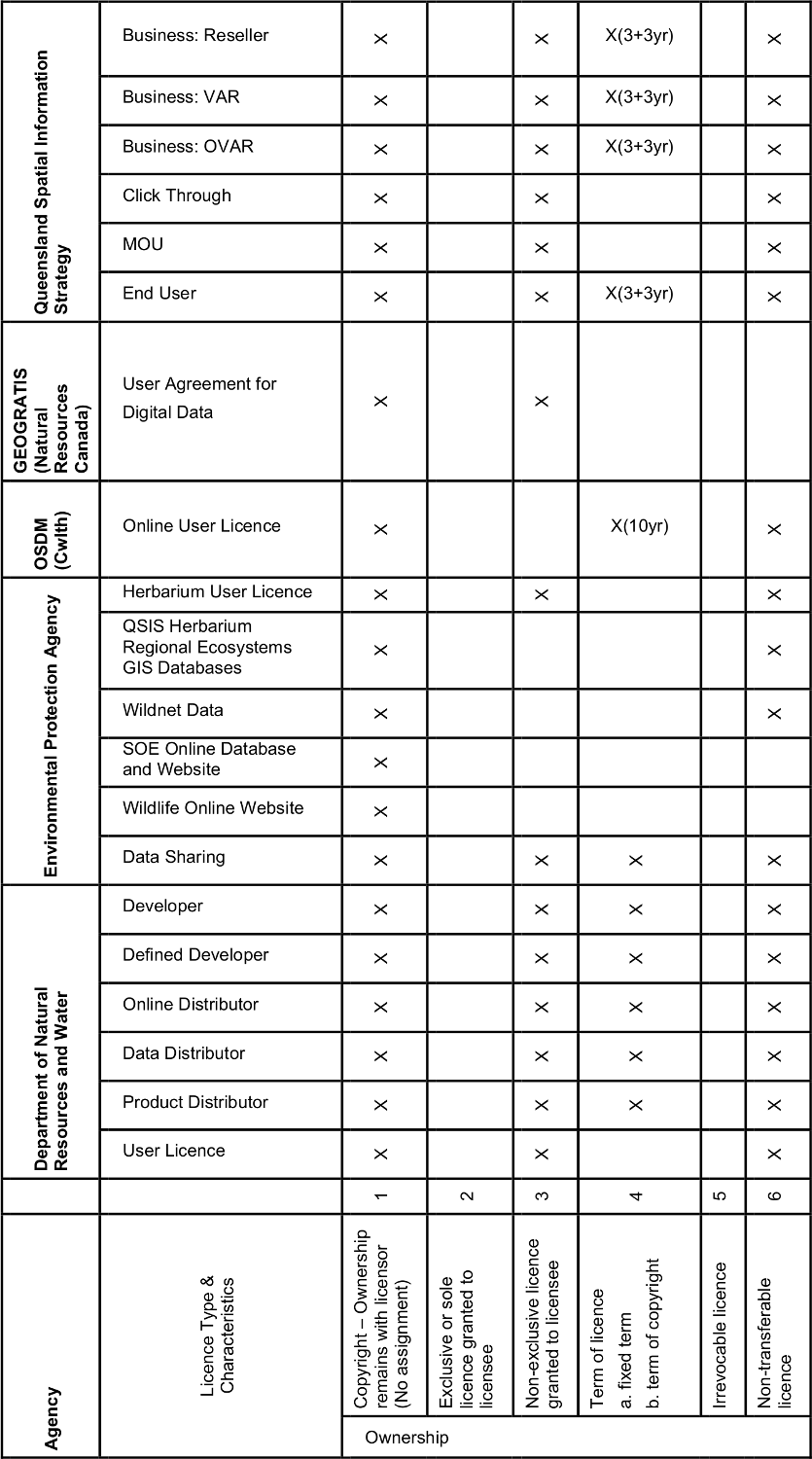
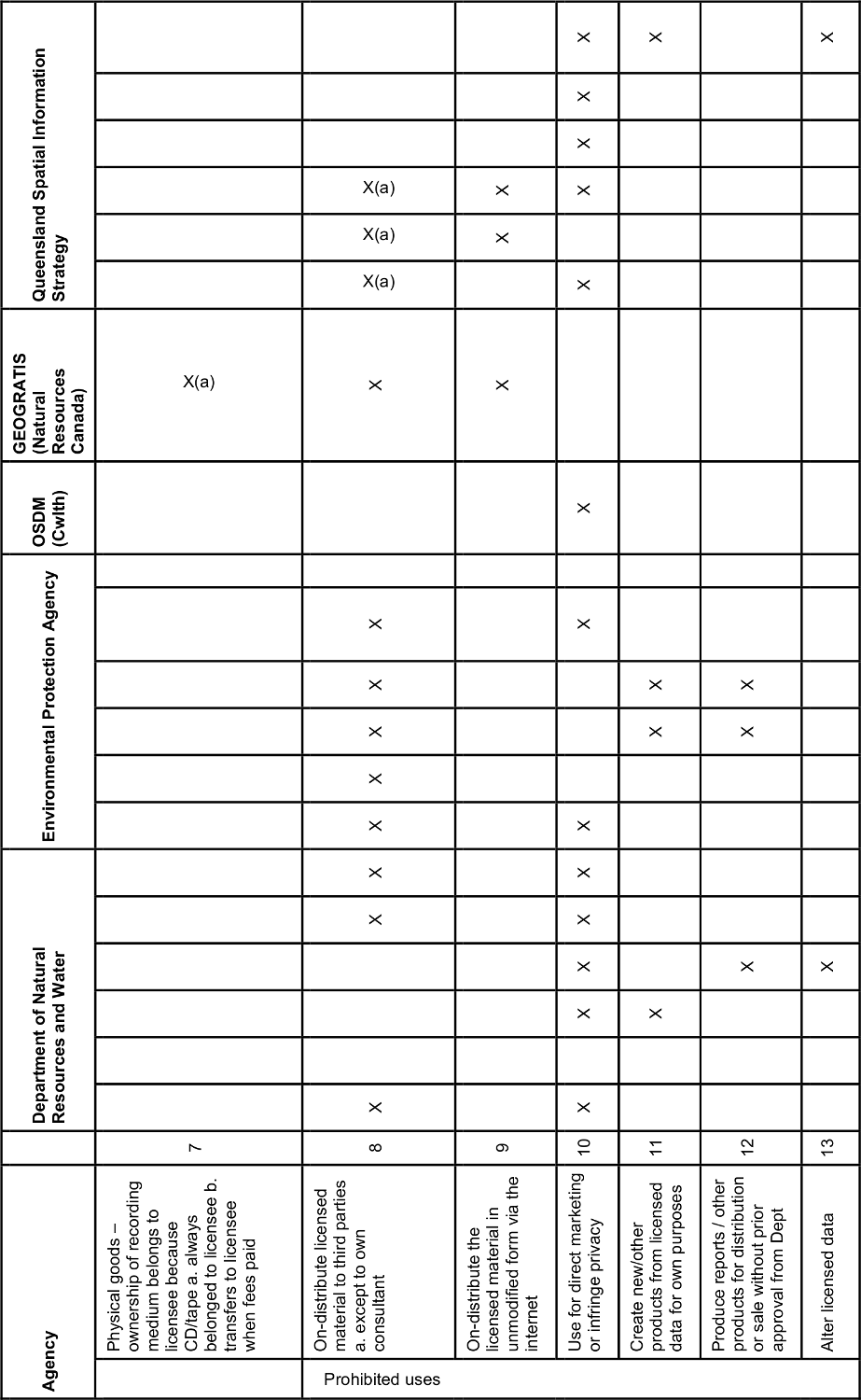
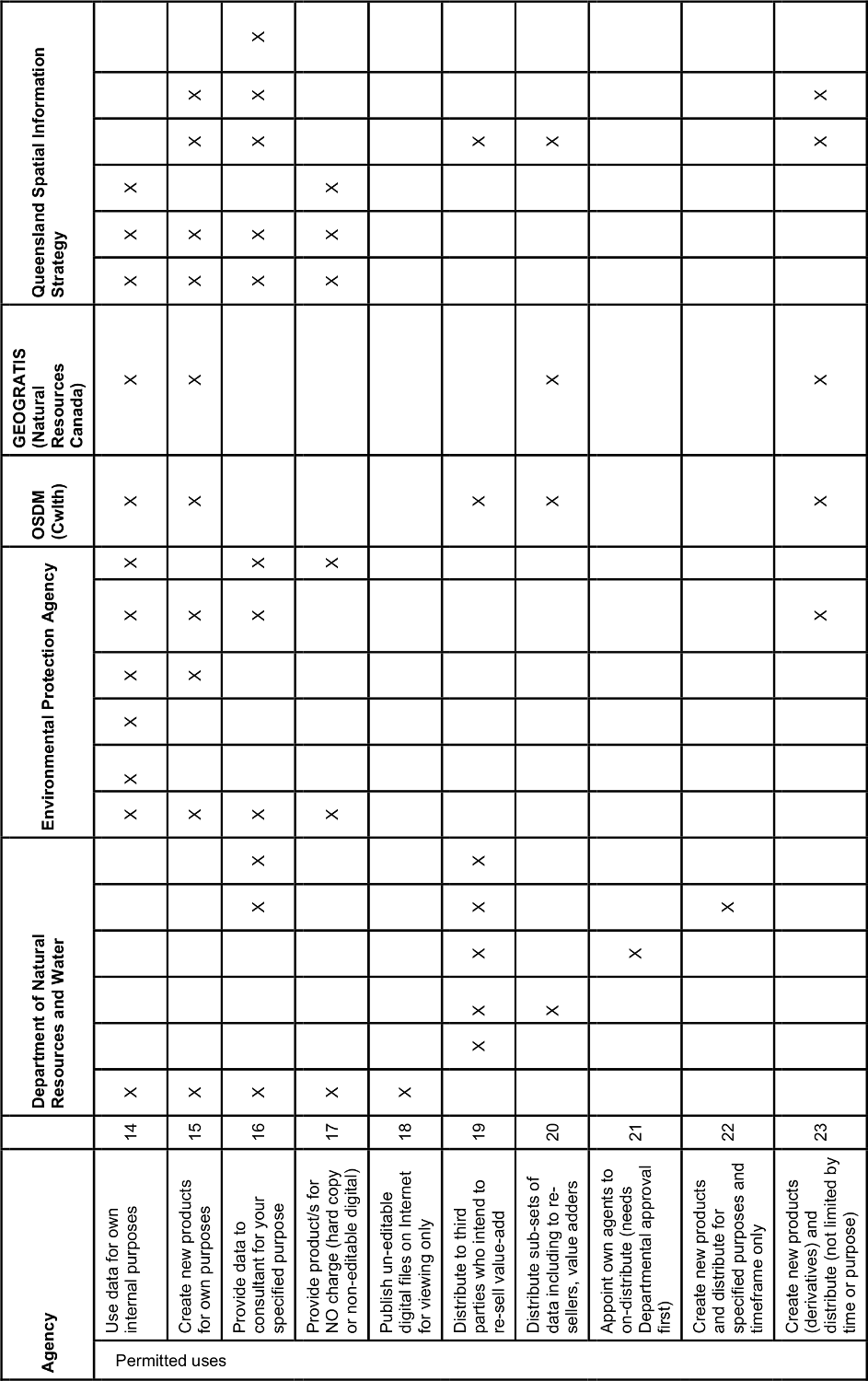
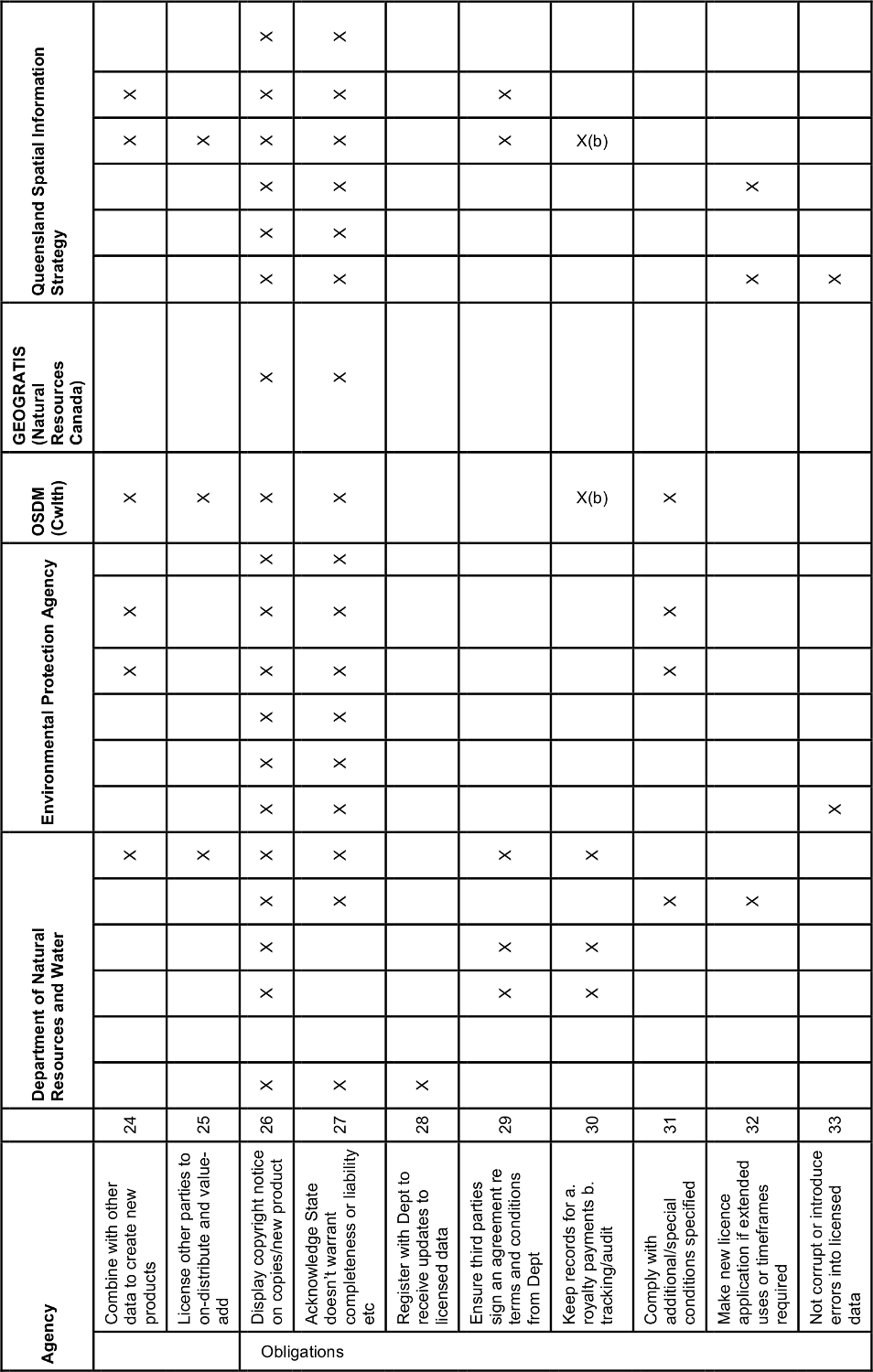
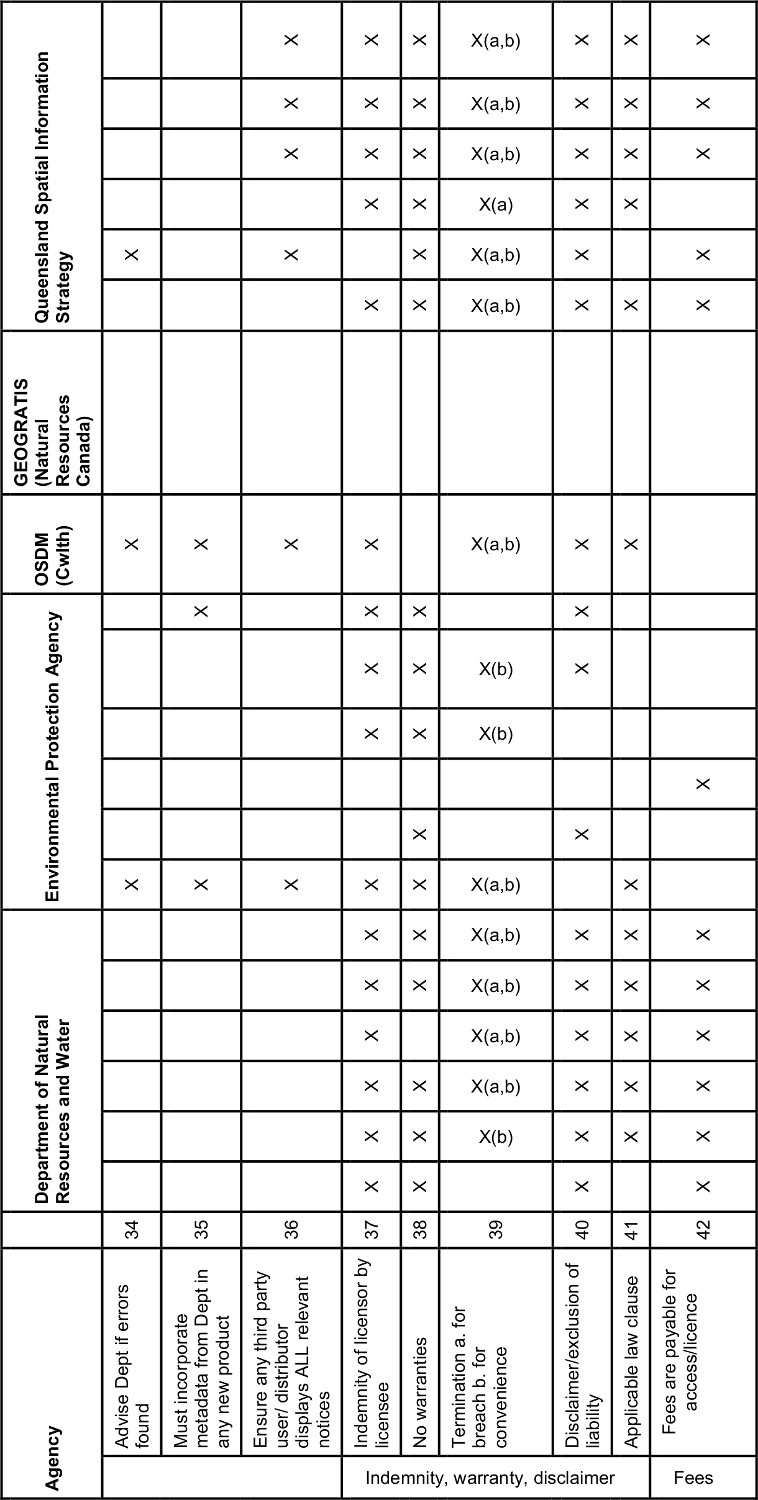
Table 2: Equivalent terms and conditions in the creative commons Attribution (BY) licence shown by shaded overlay
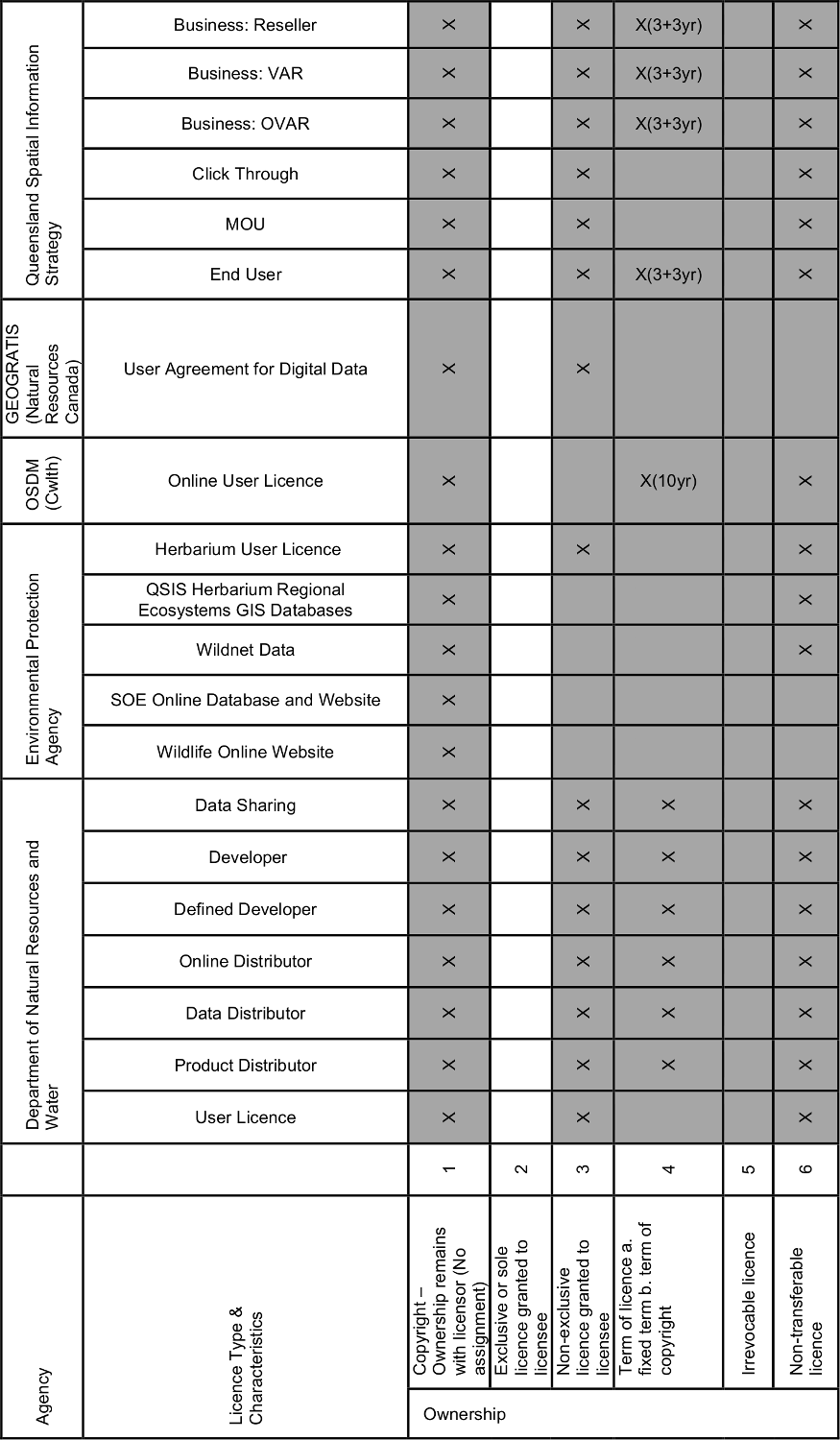
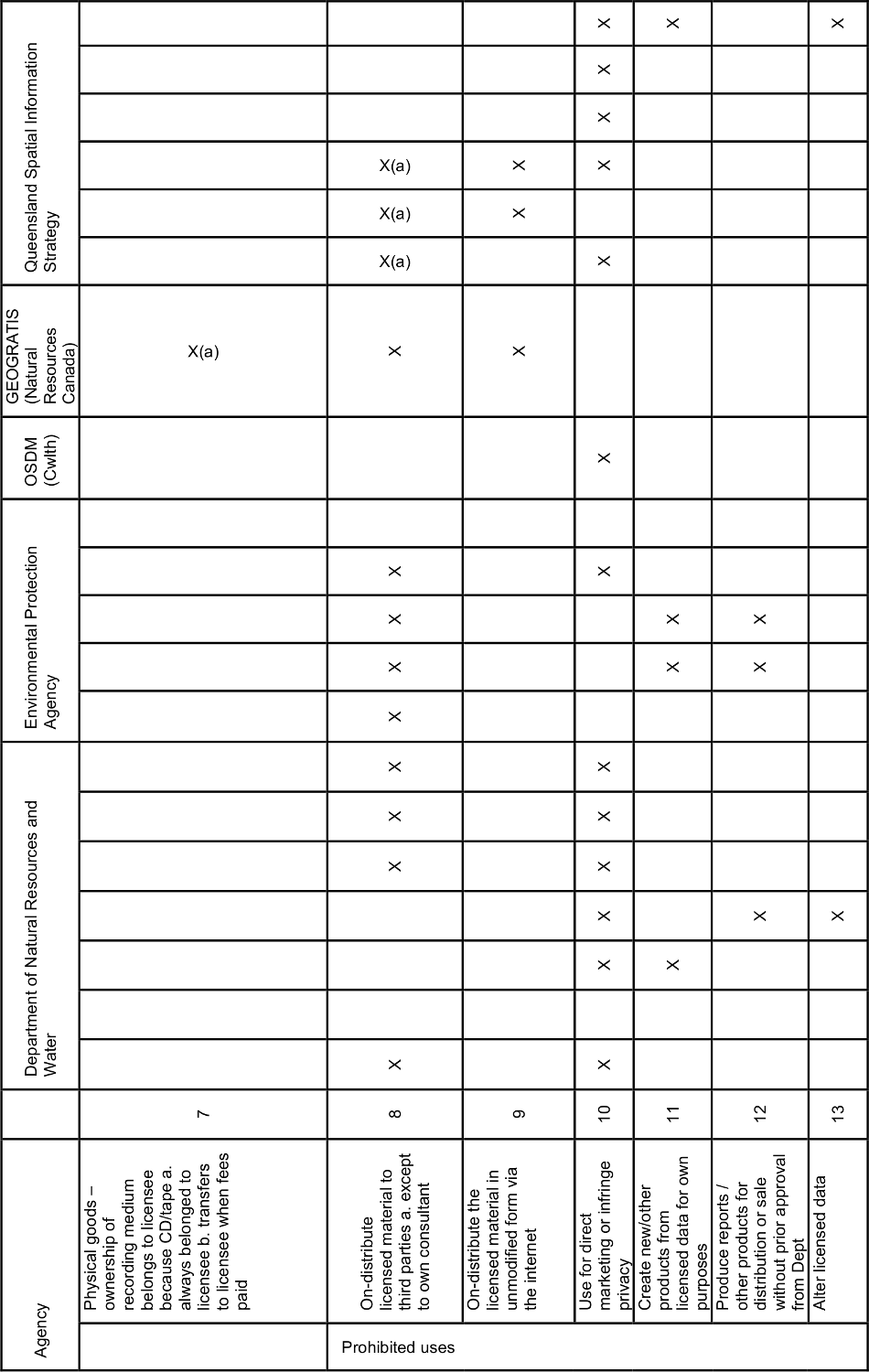
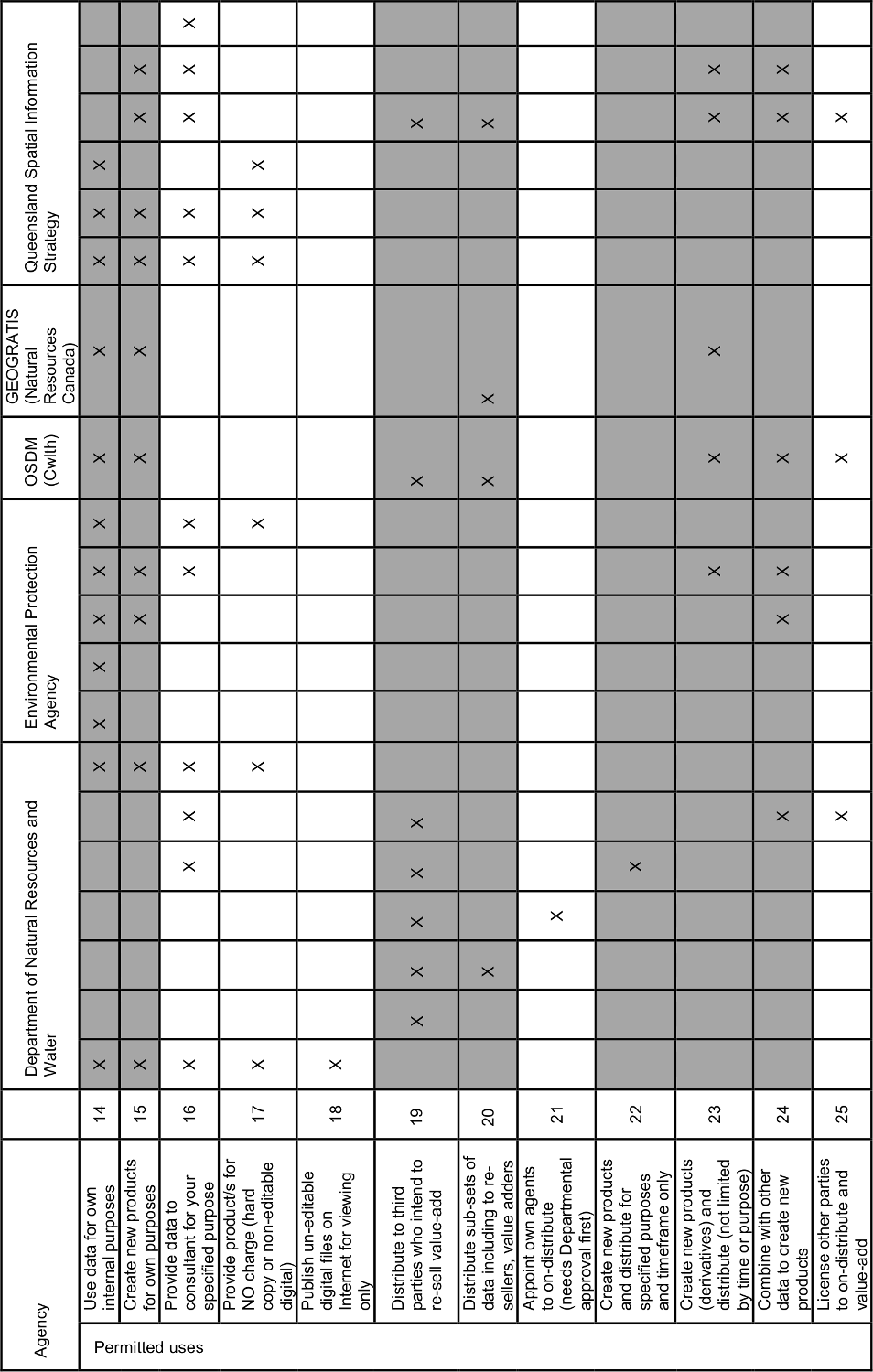
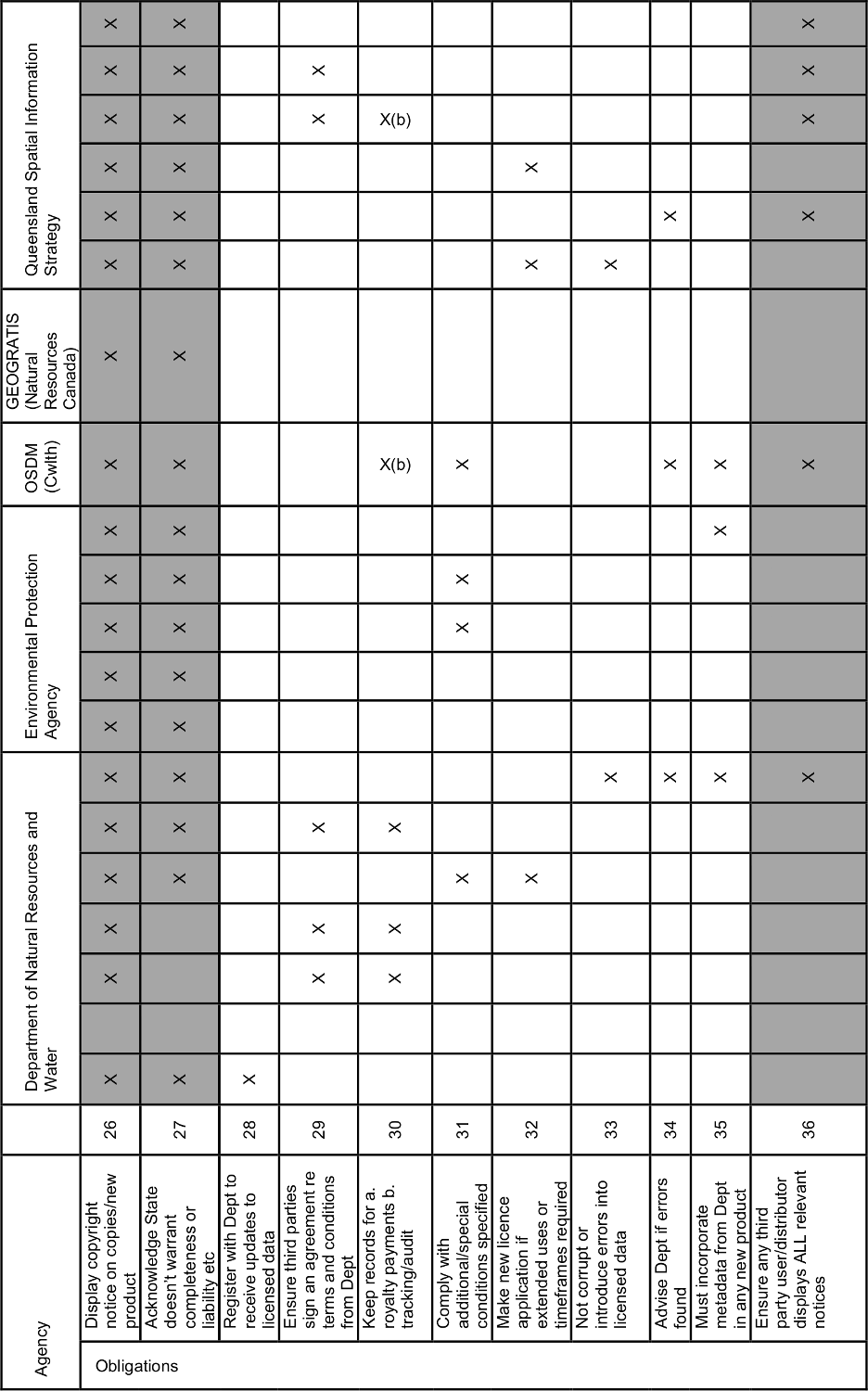
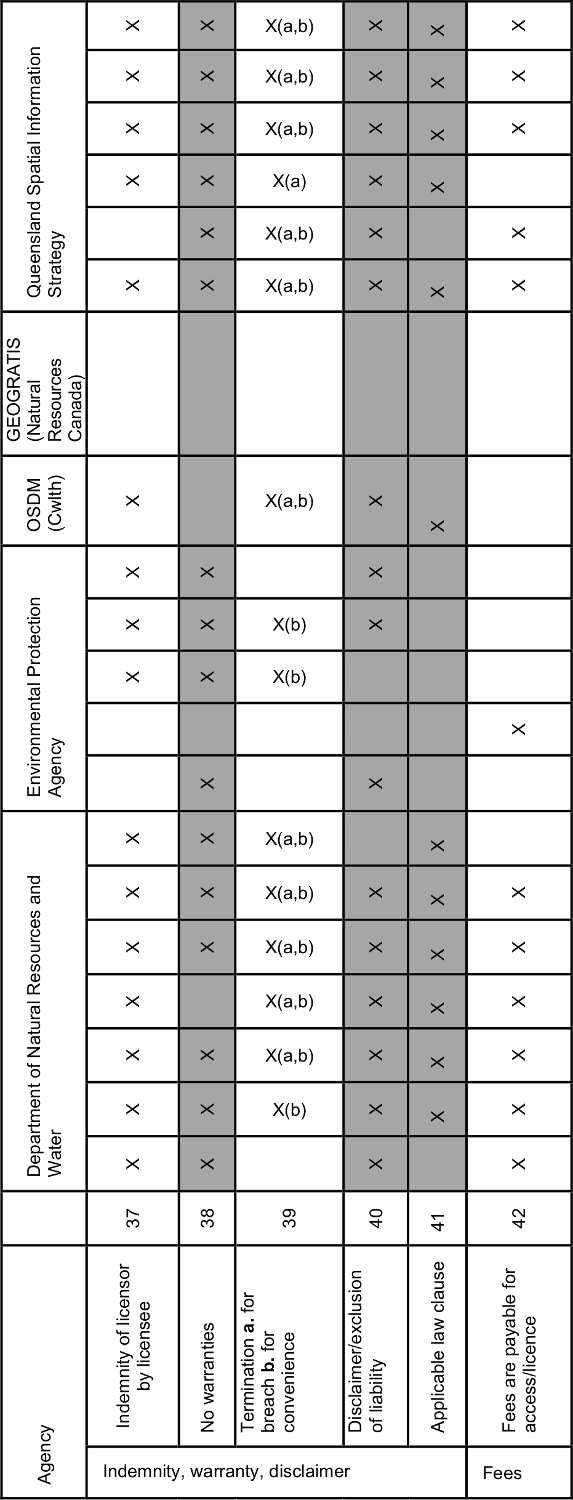
Table 3: Equivalent terms and conditions in the creative commons Attribution Share Alike (BY-SA) licence shown by shaded overlay
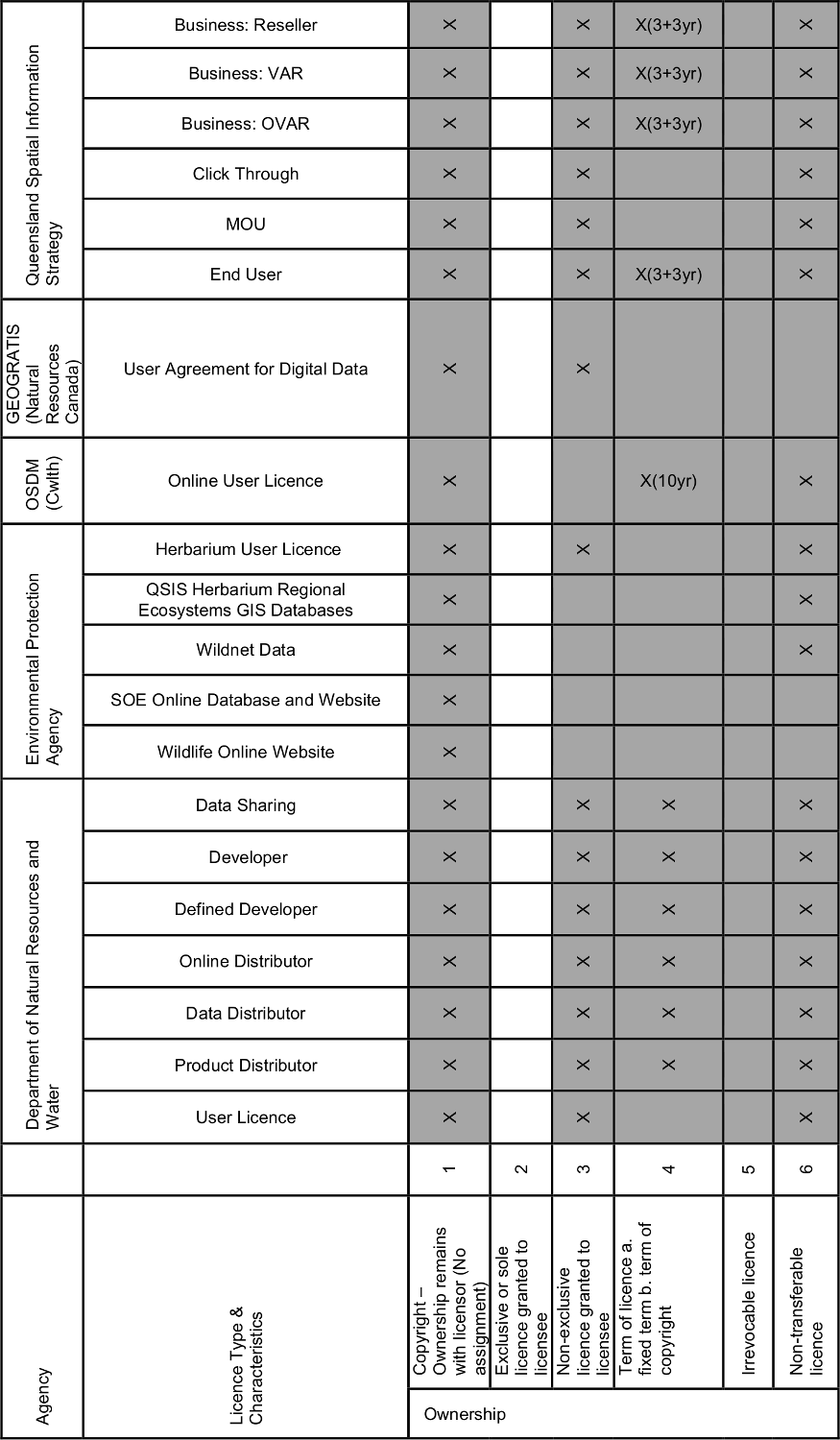
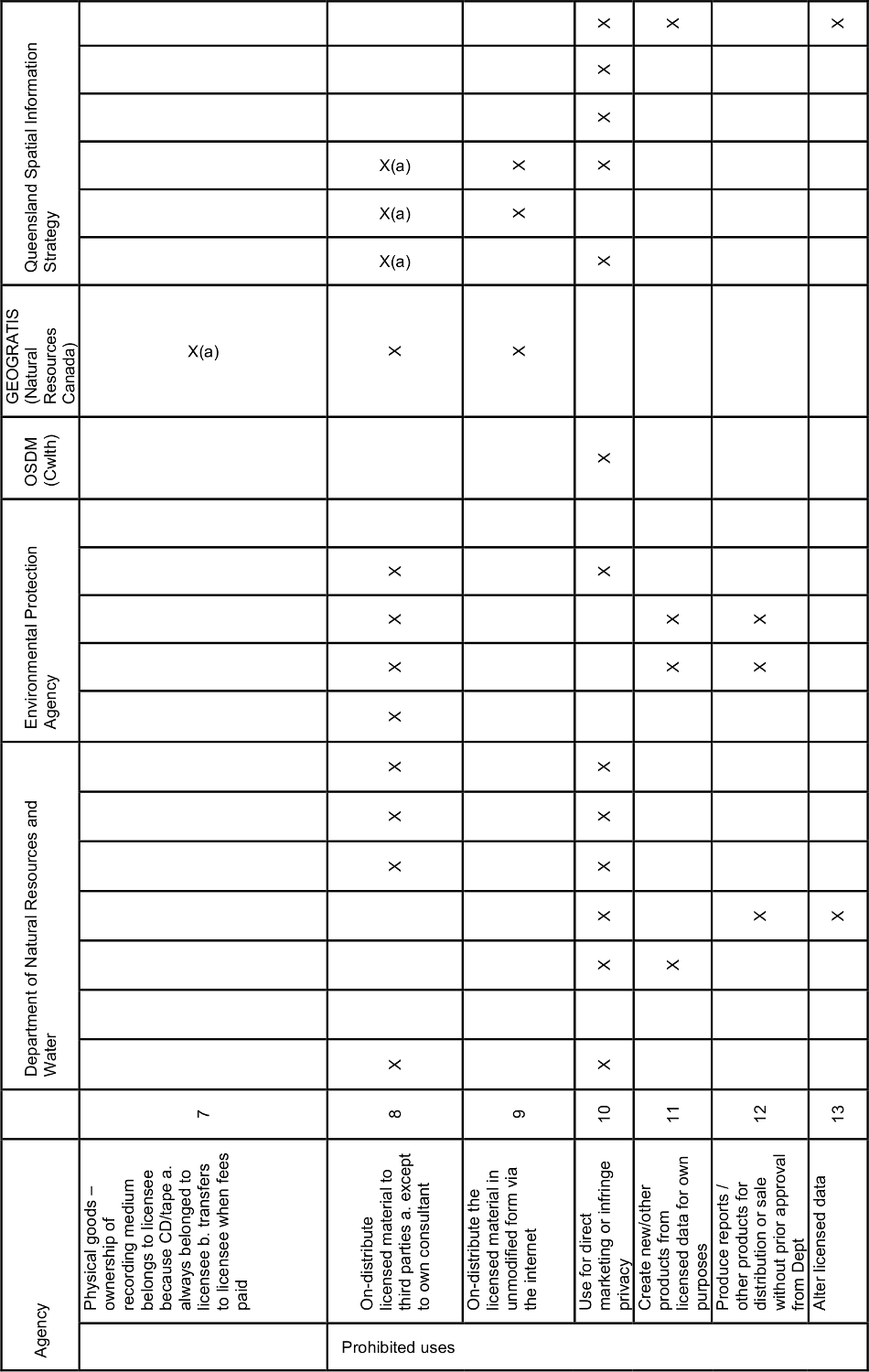
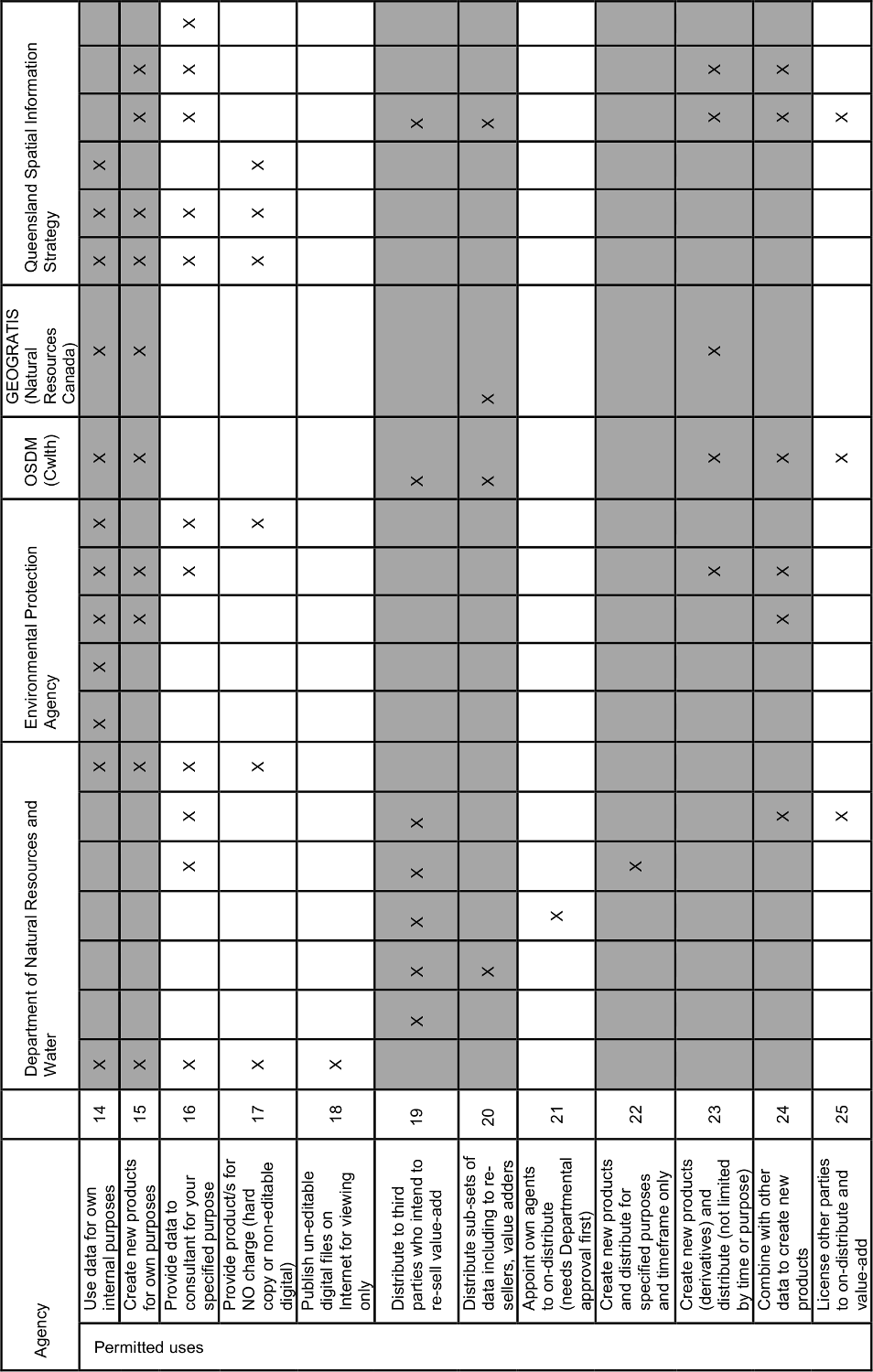
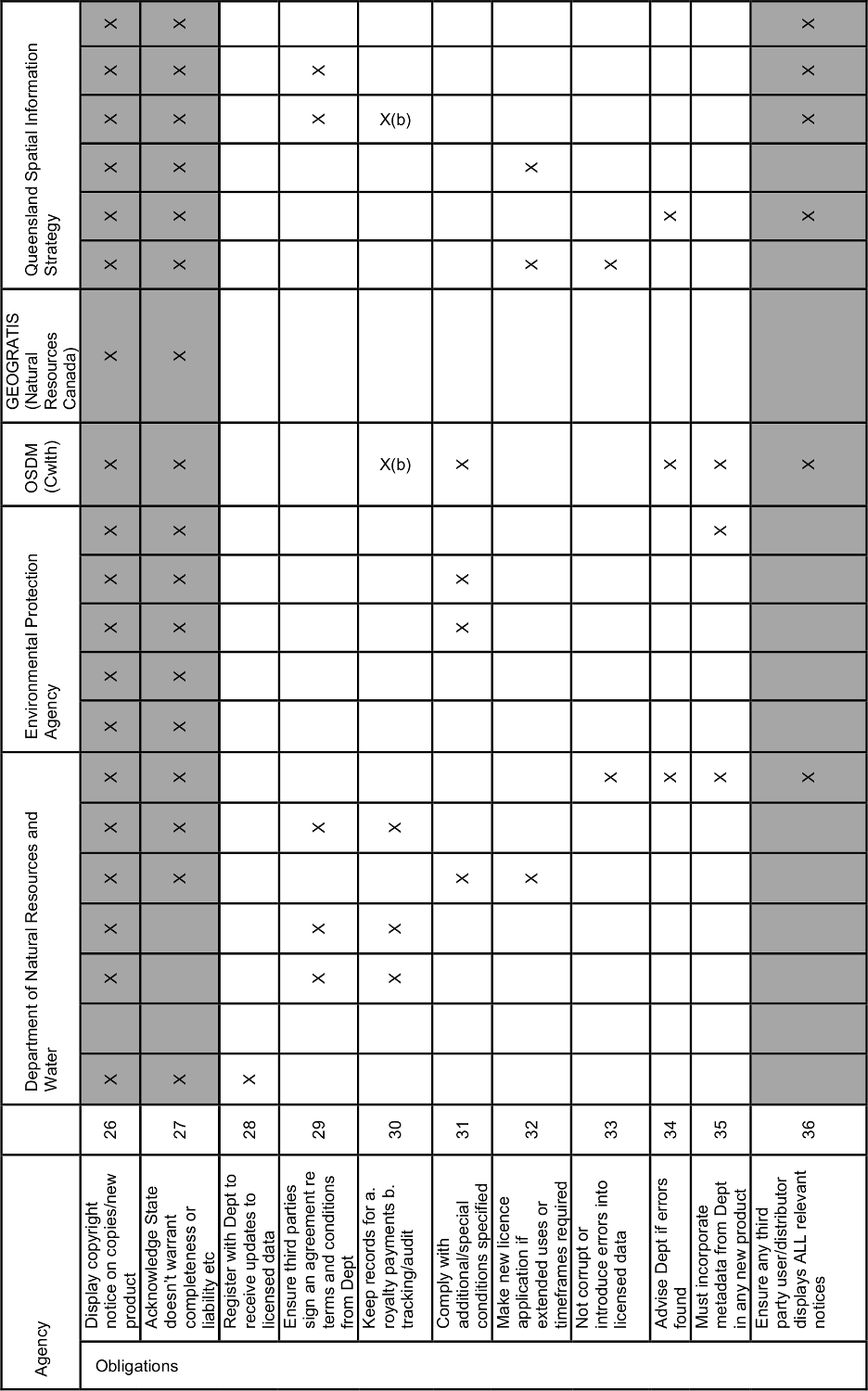
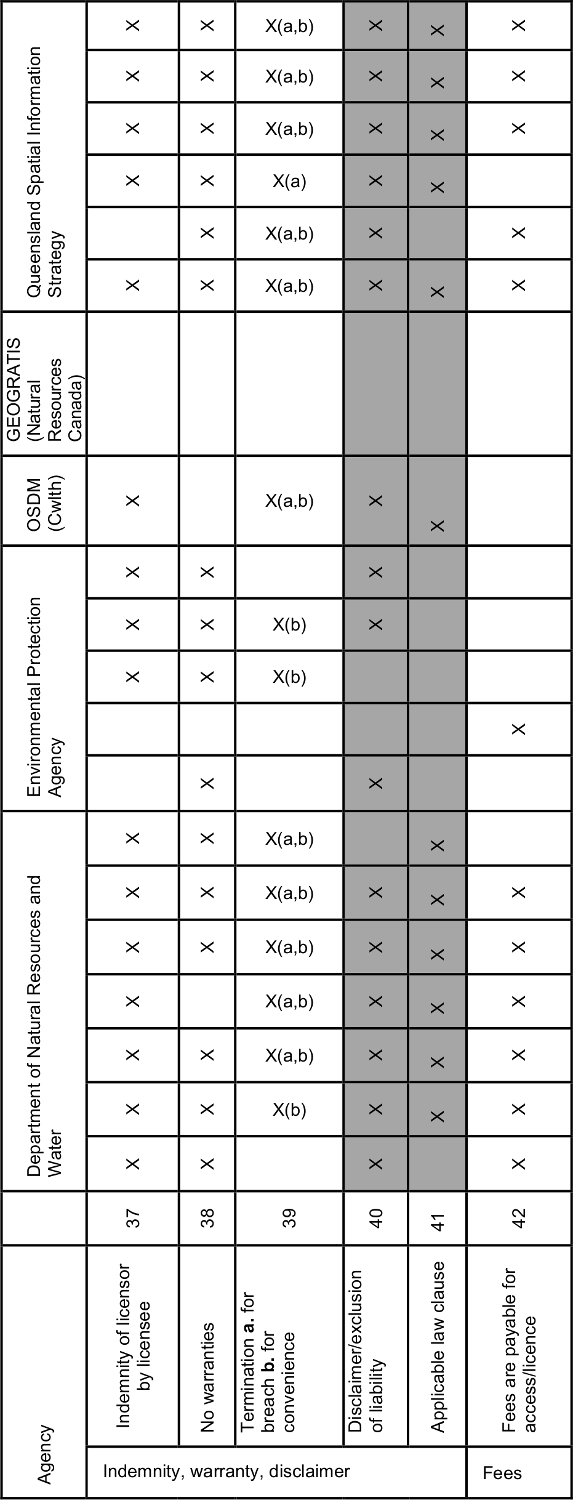
Table 4: Equivalent terms and conditions in the creative commons Attribution No Derivatives (BY-NC) licence shown by shaded overlay
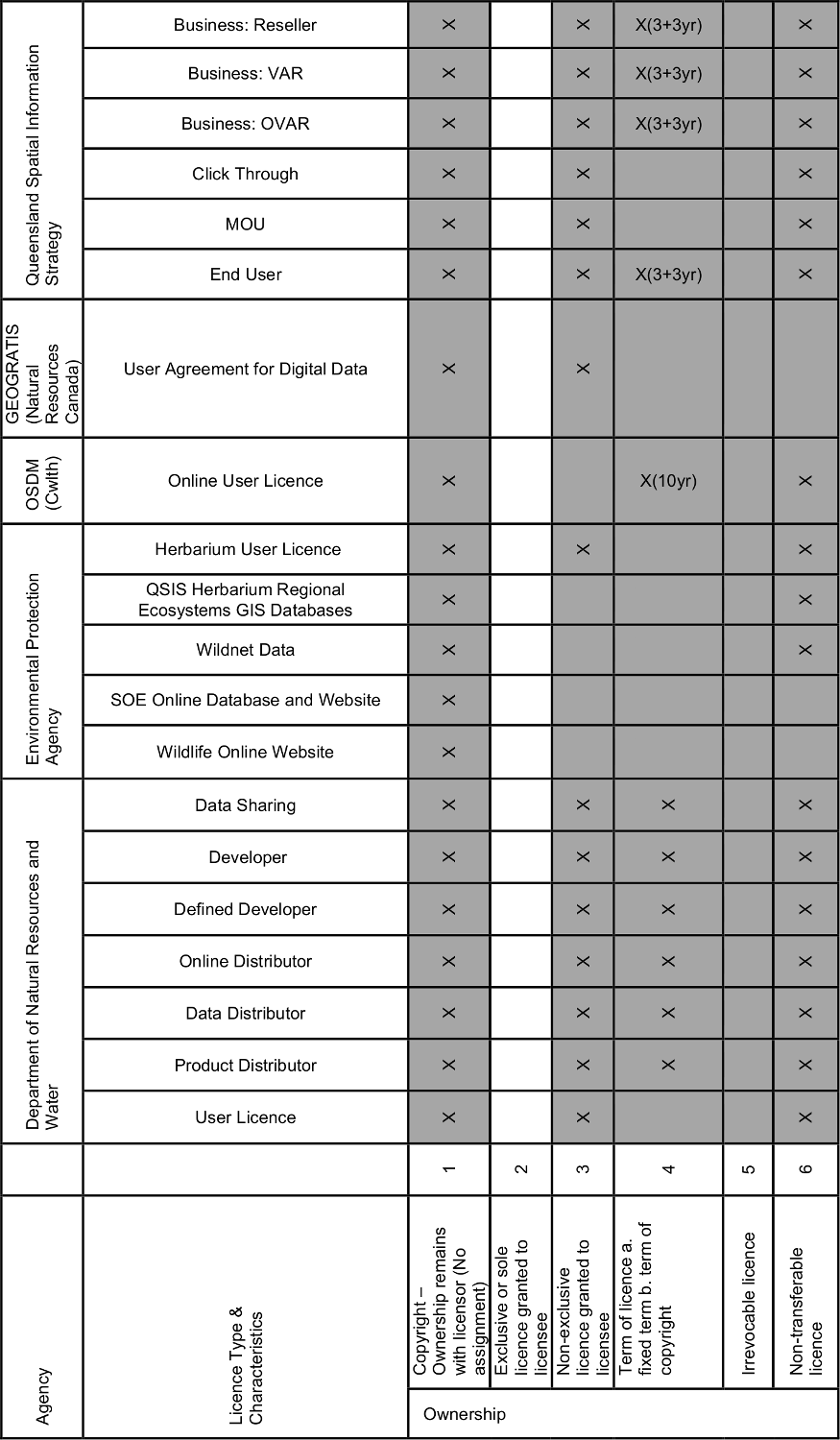
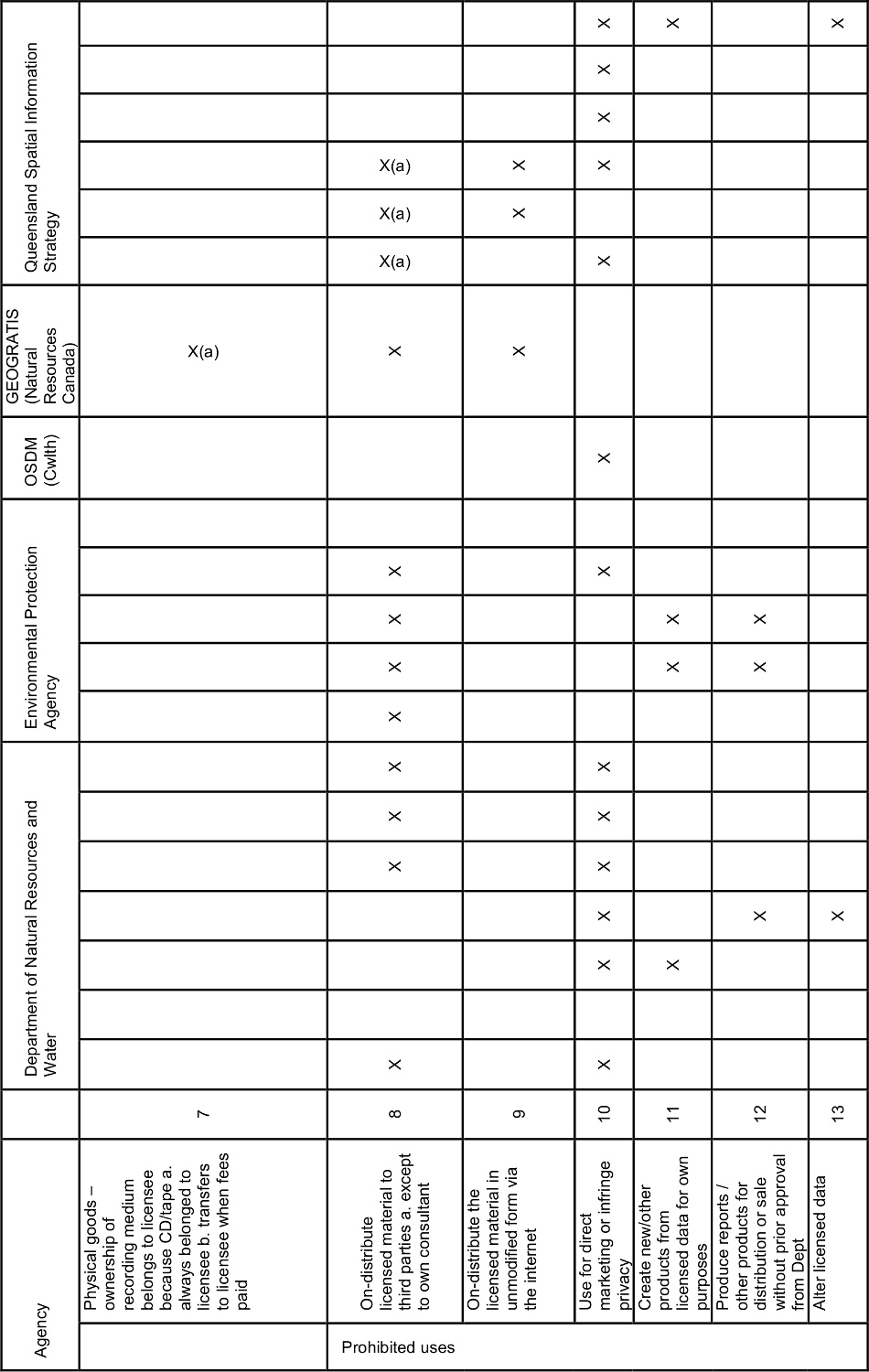
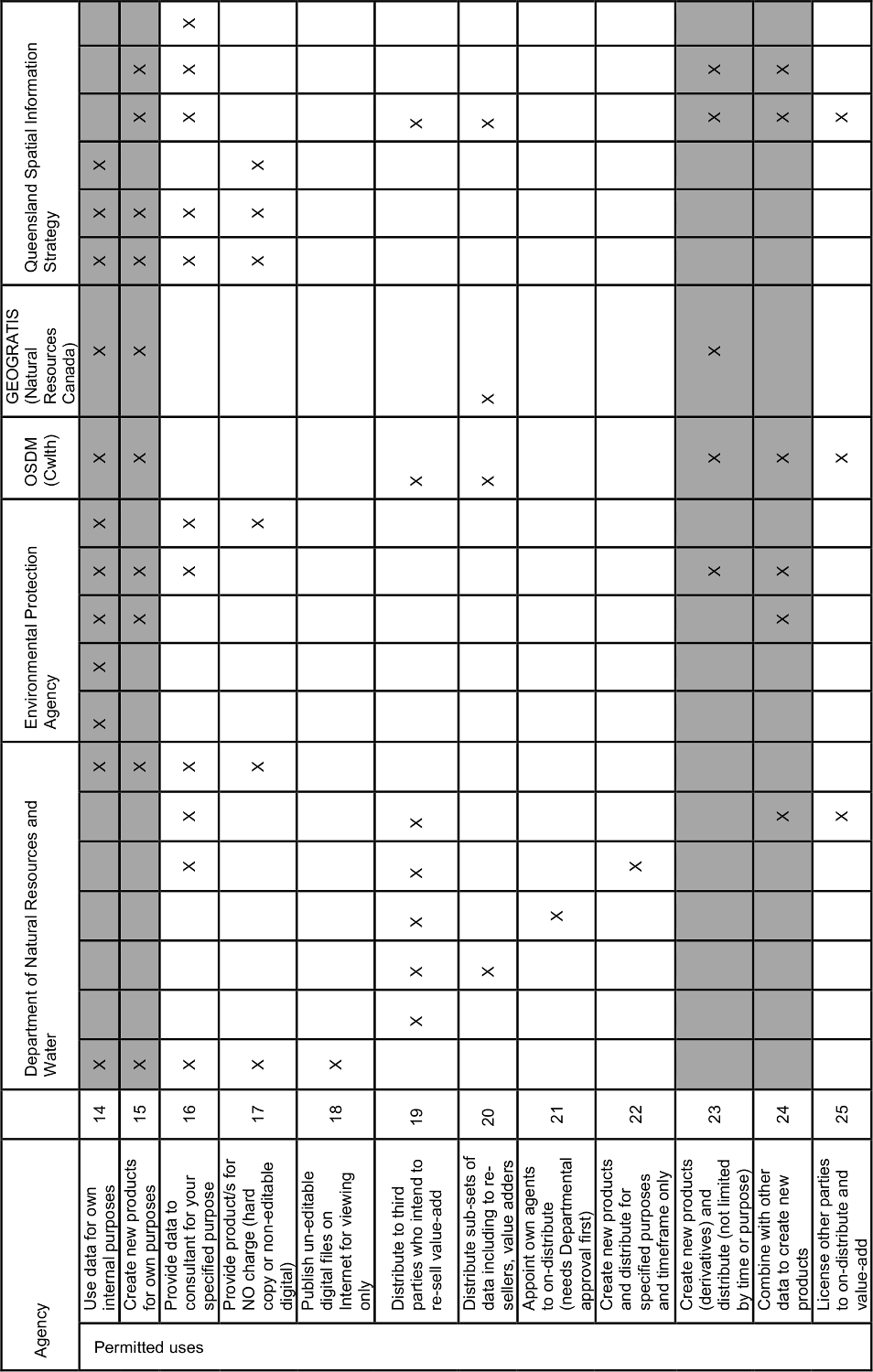
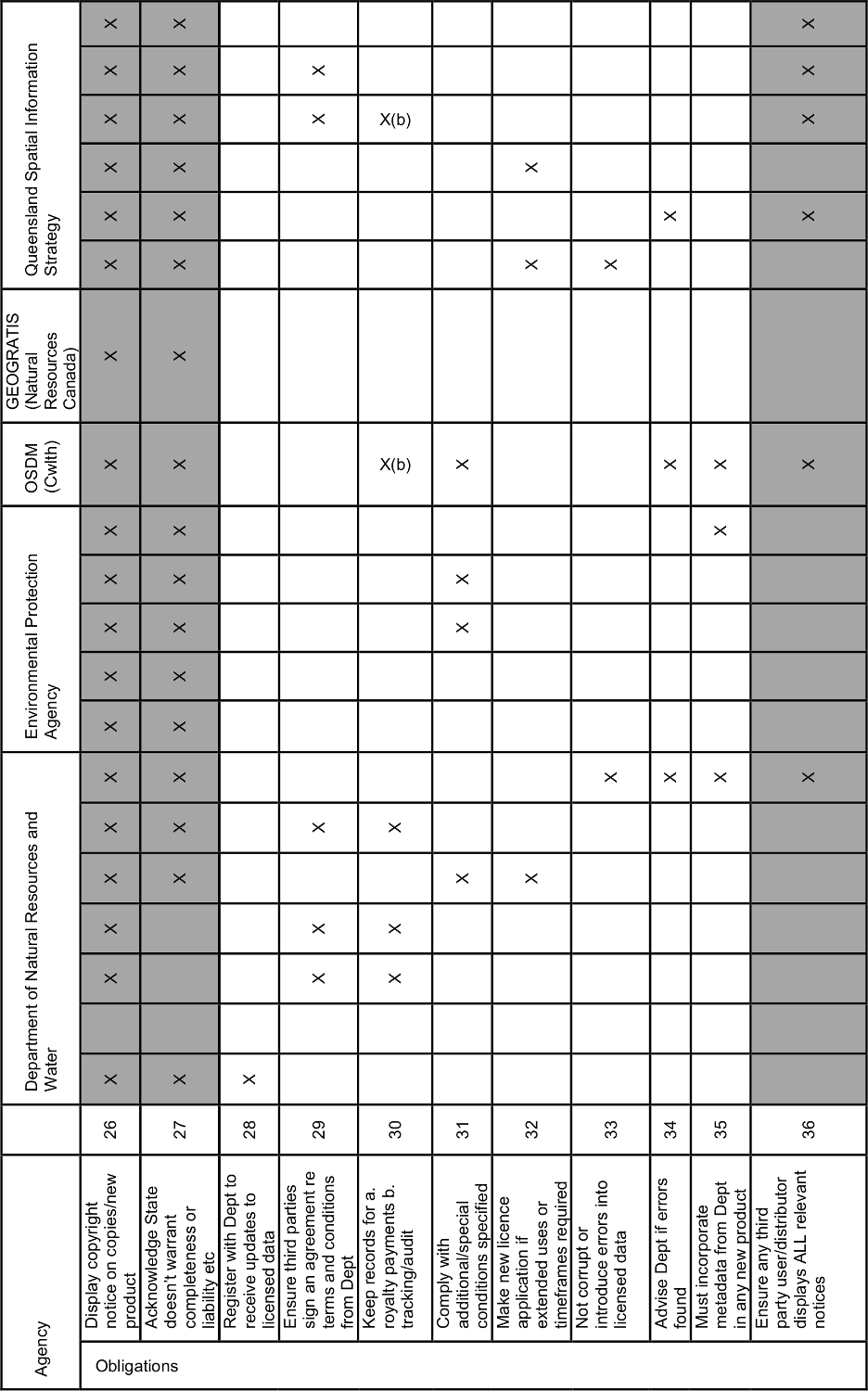
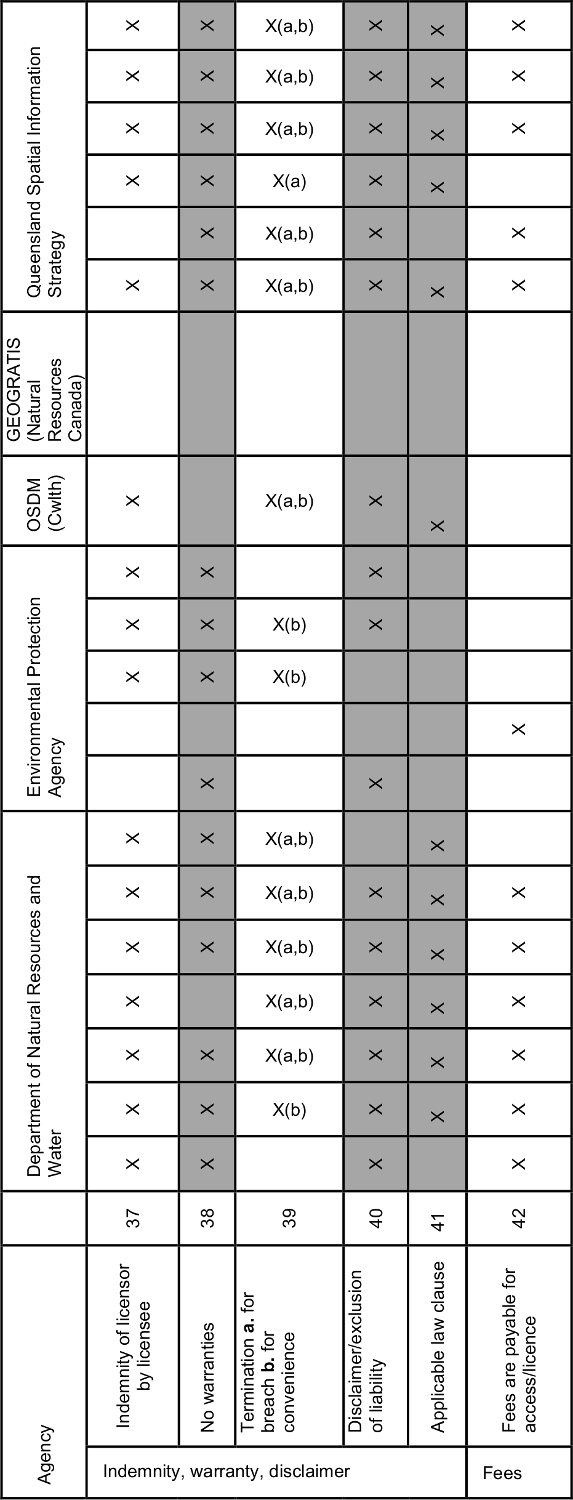
Table 5: Equivalent terms and conditions in the creative commons Attribution Non-commercial Share Alike (BY-NC-SA) licence shown by shaded overlay
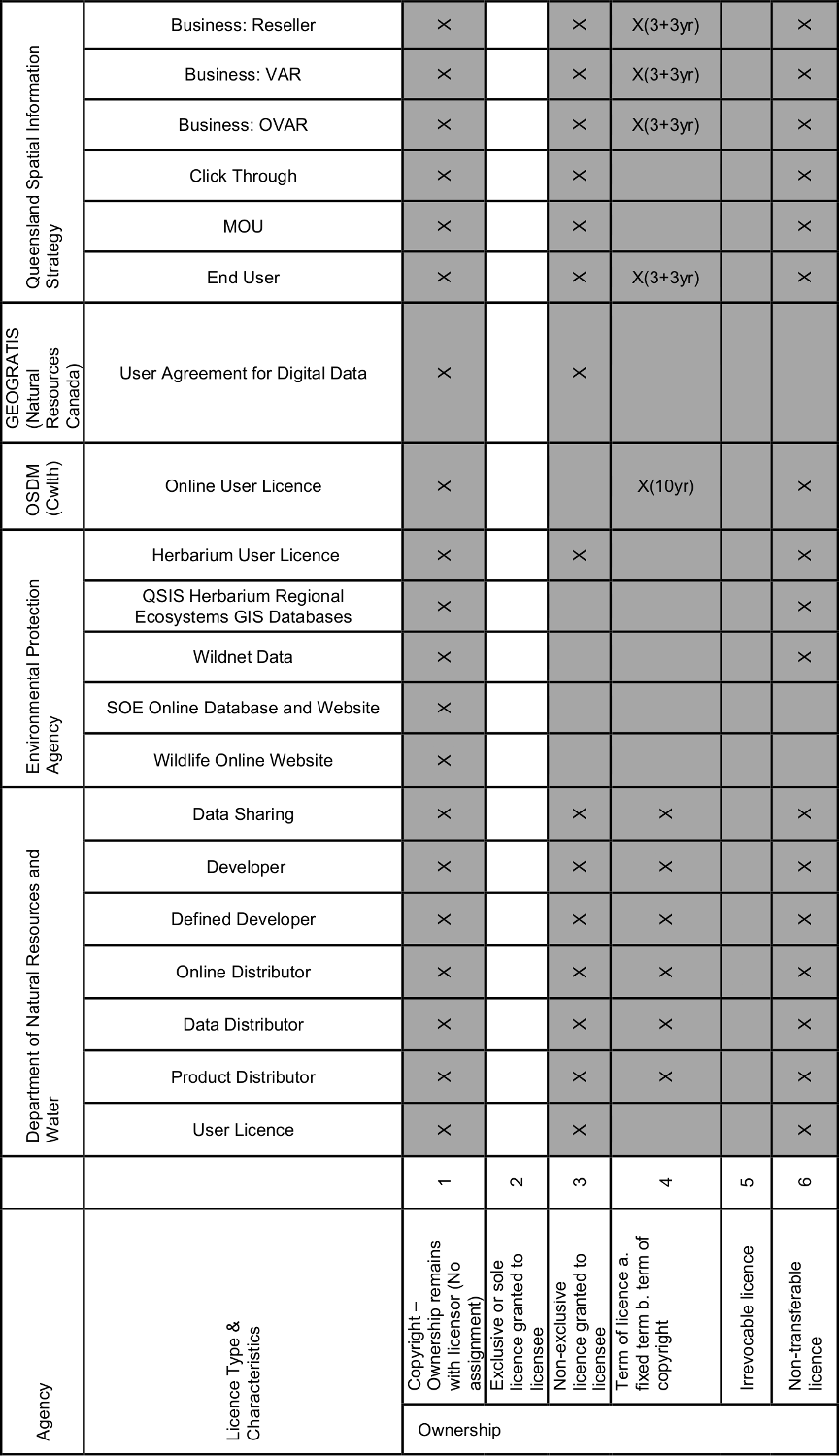
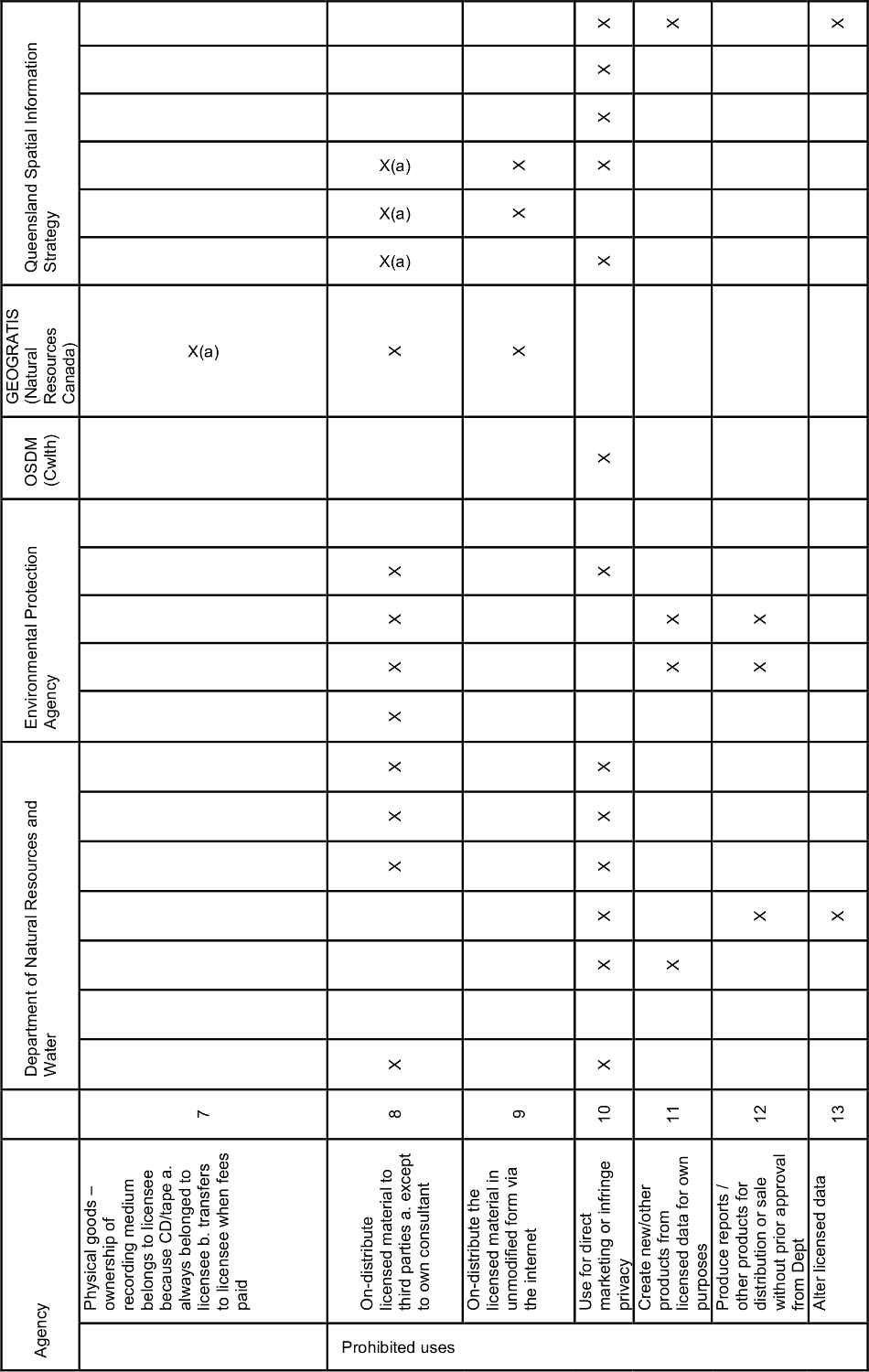
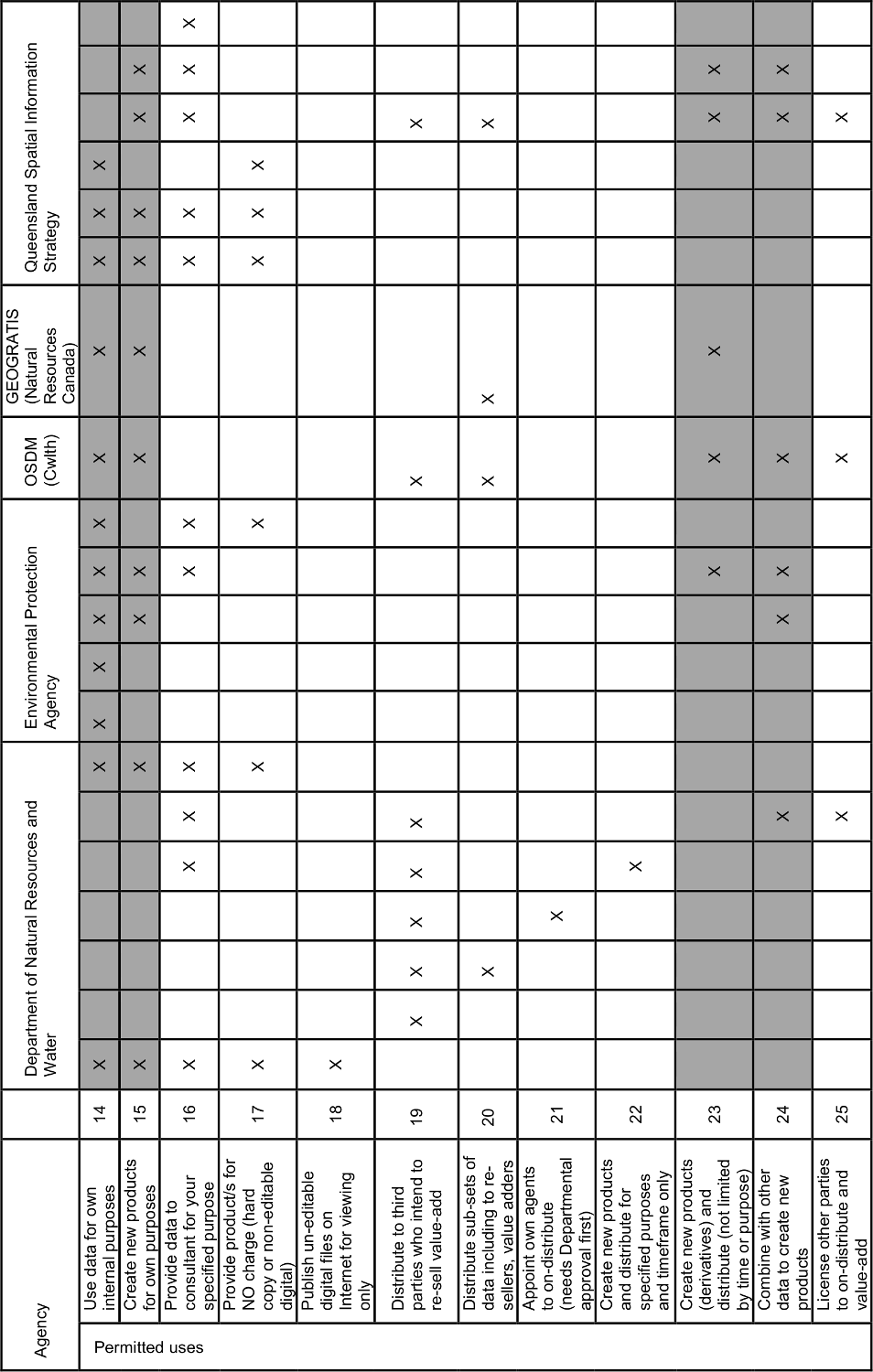
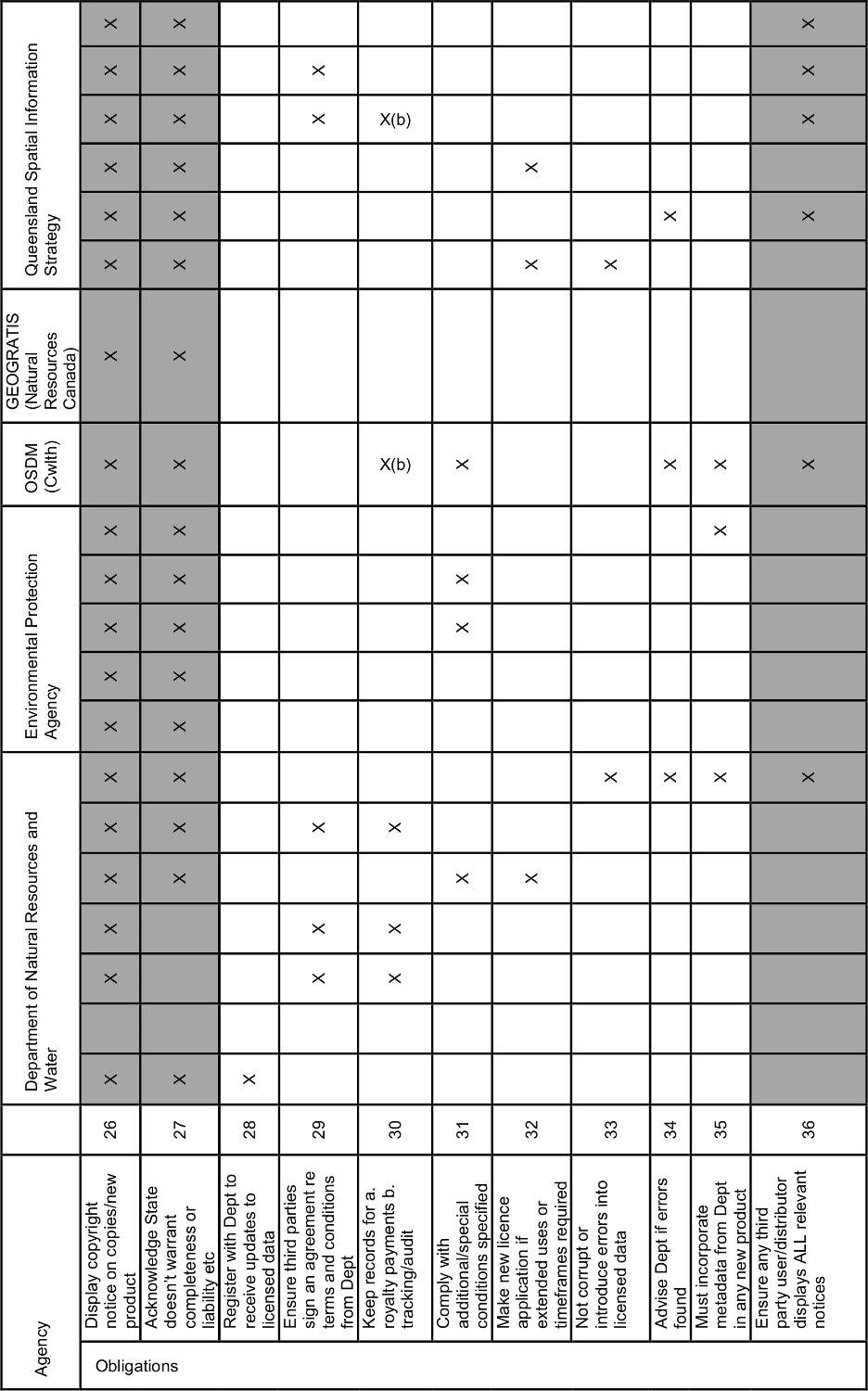
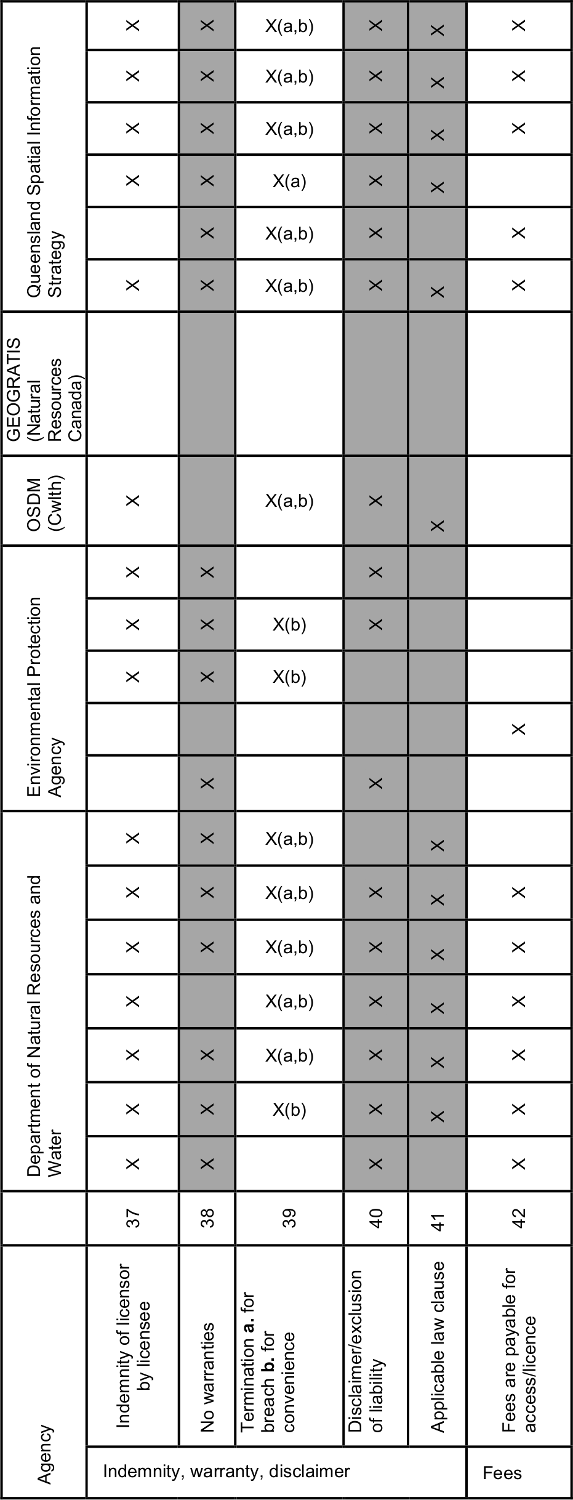
Table 6: Equivalent terms and conditions in the creative commons Attribution No Derivatives (BY-ND) licence shown by shaded overlay
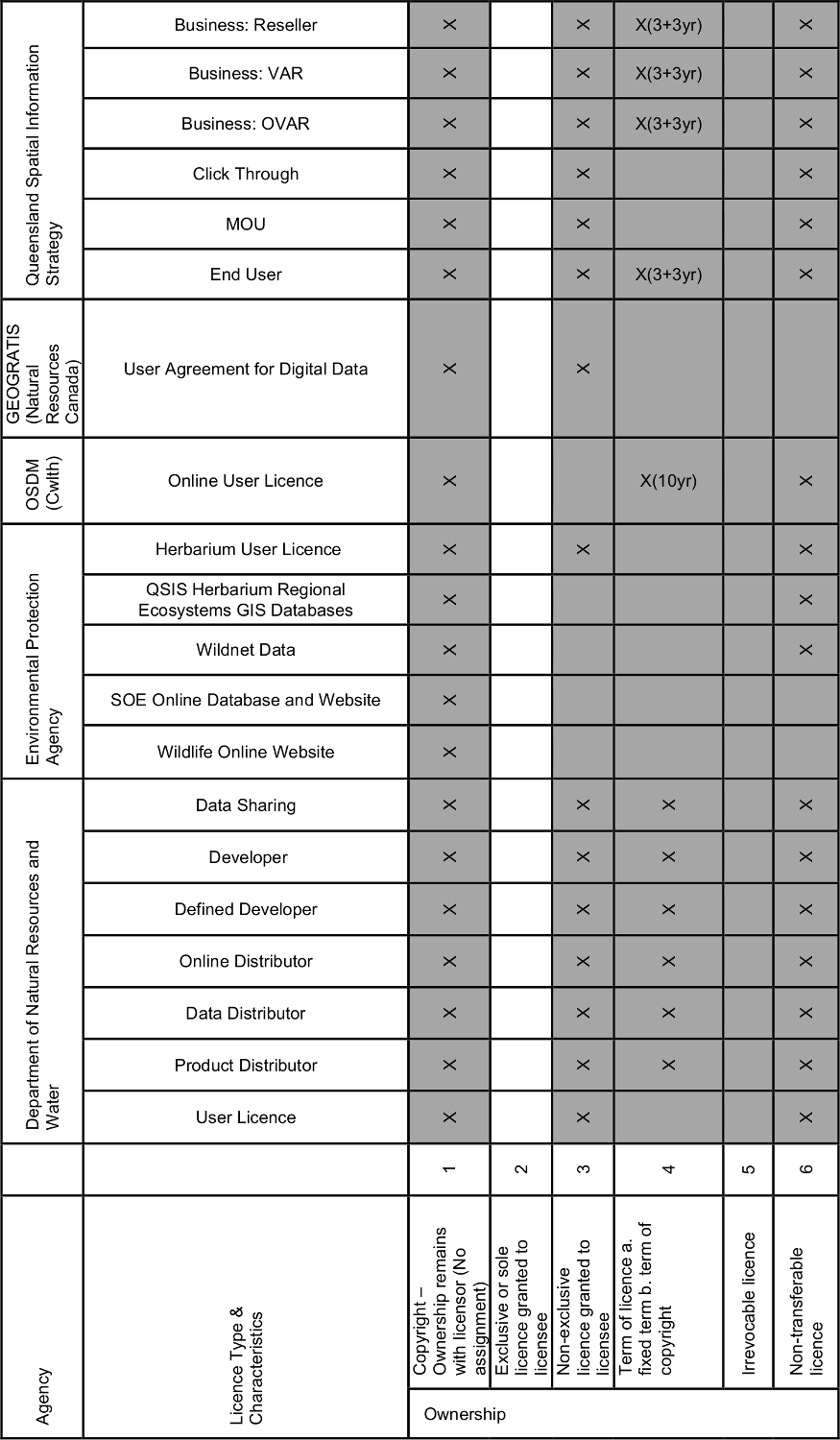
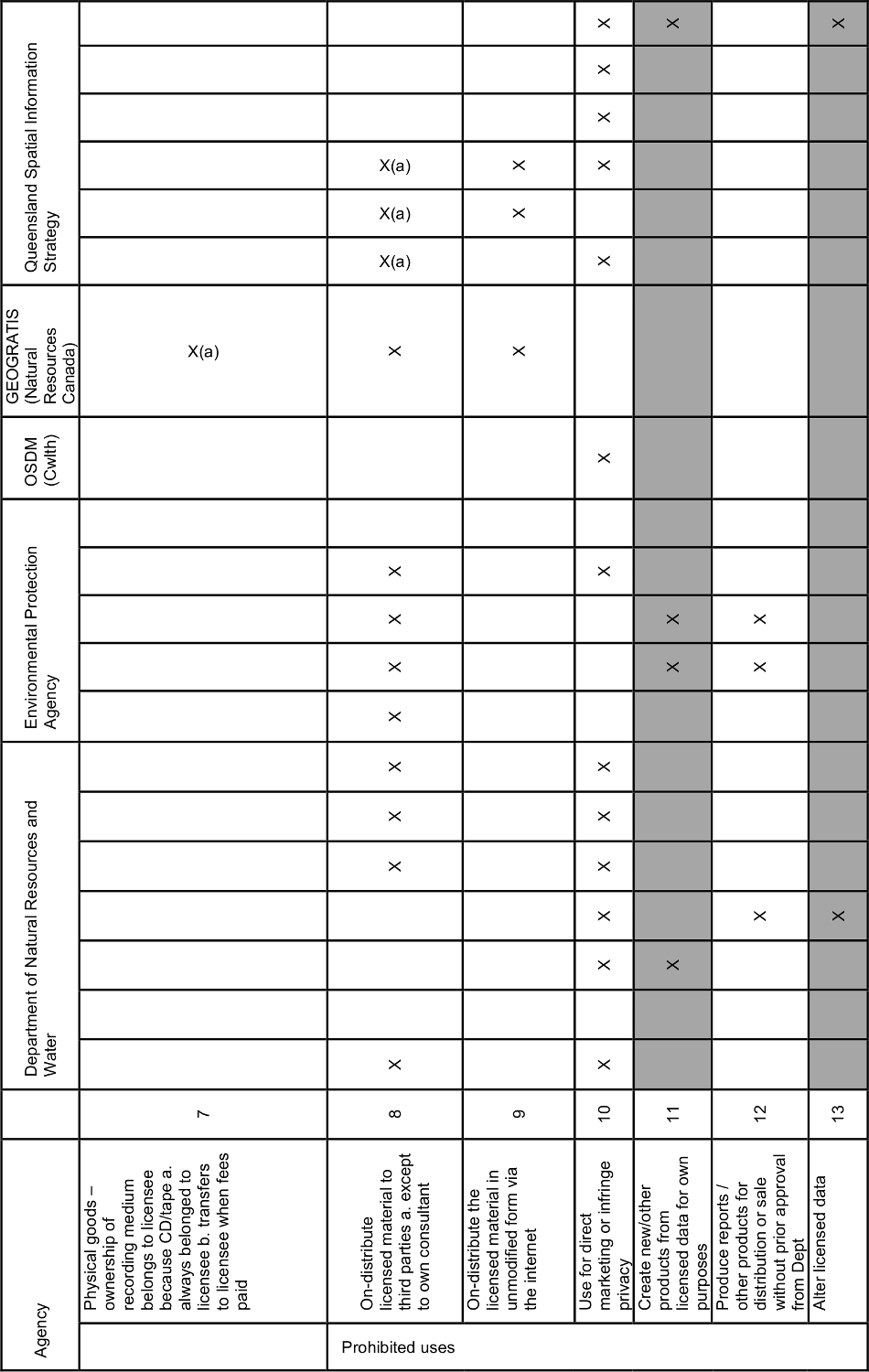
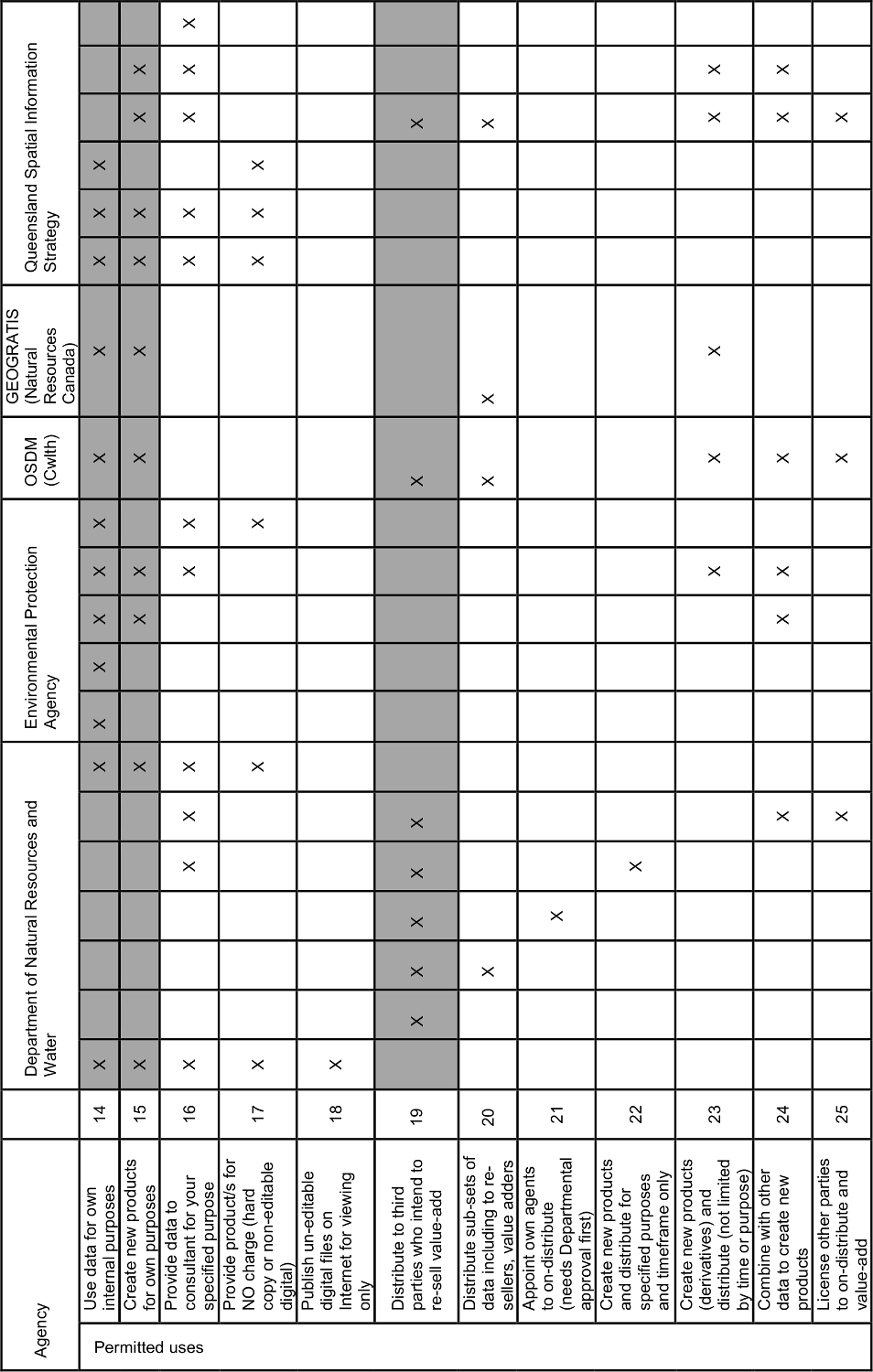
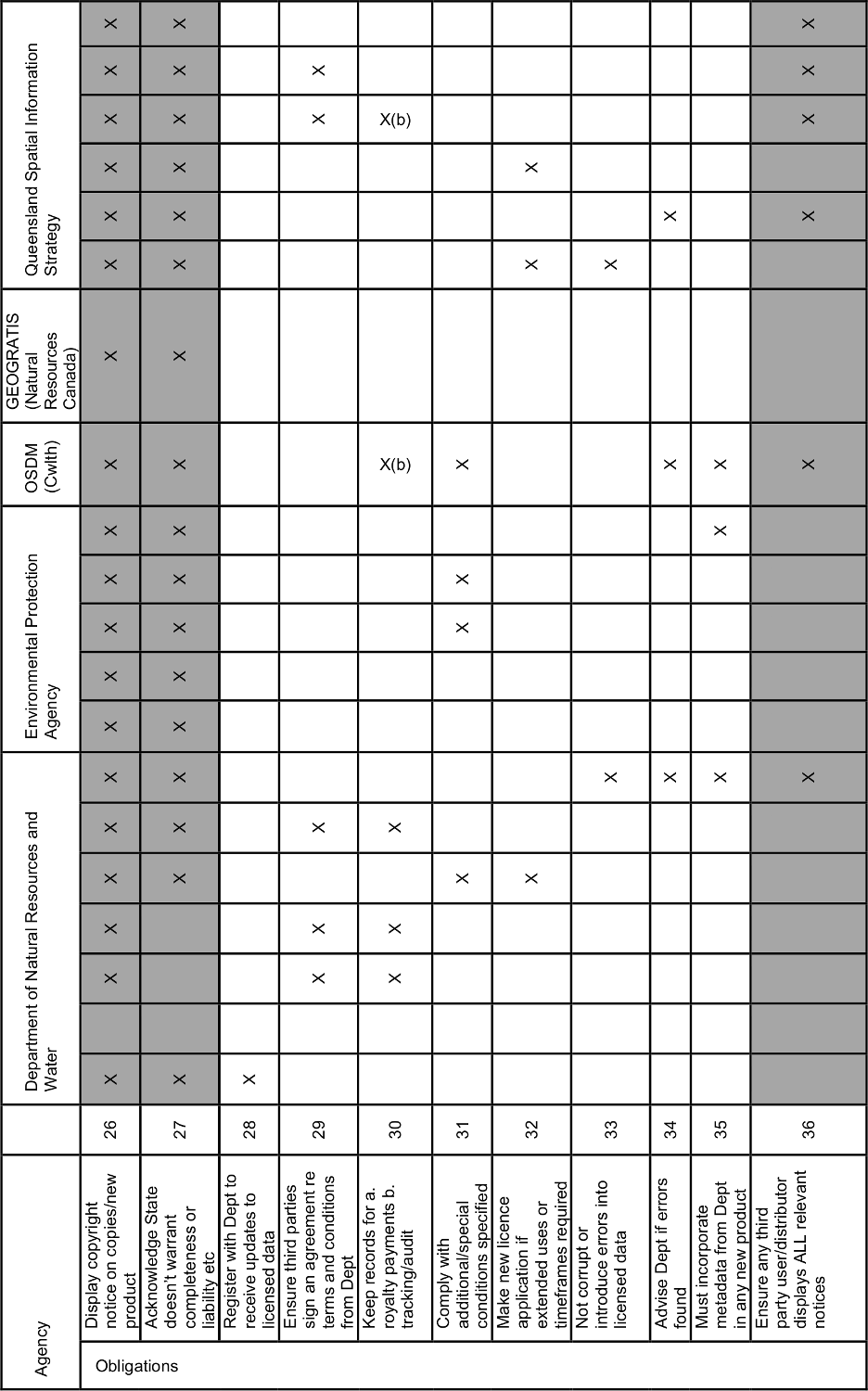
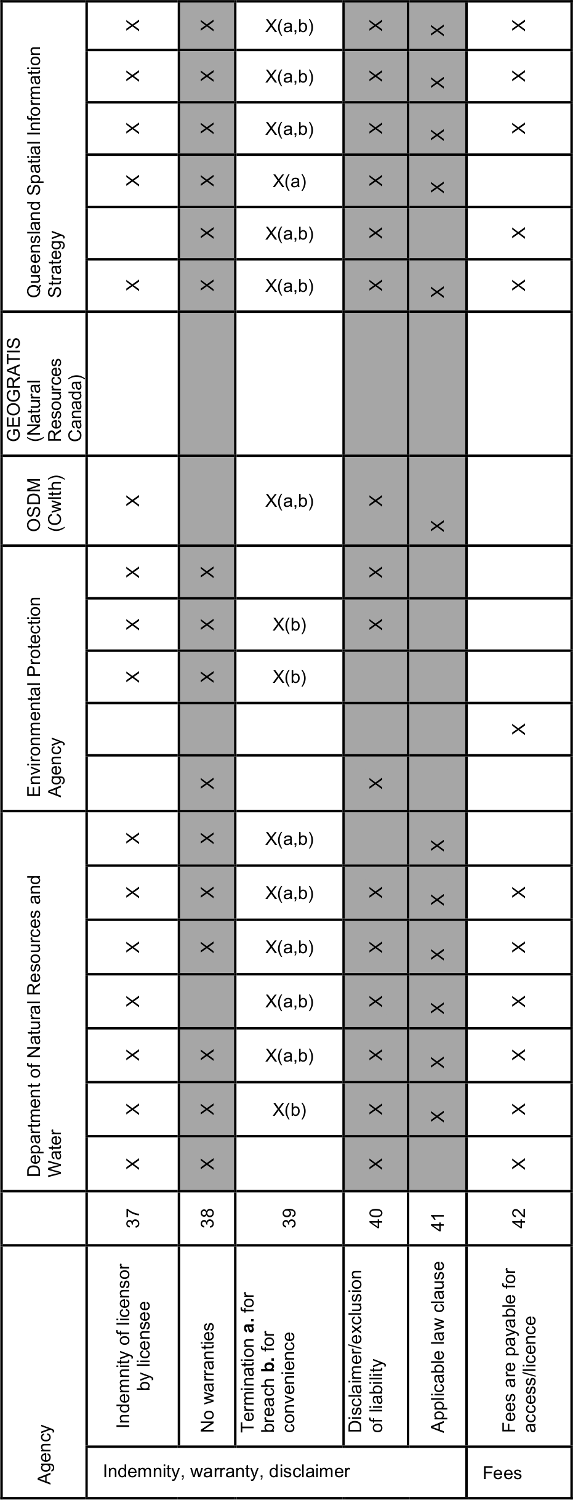
Table 7: Equivalent terms and conditions in the creative commons Attribution Non-commercial No Derivatives (BY-NC-ND) licence shown by shaded overlay
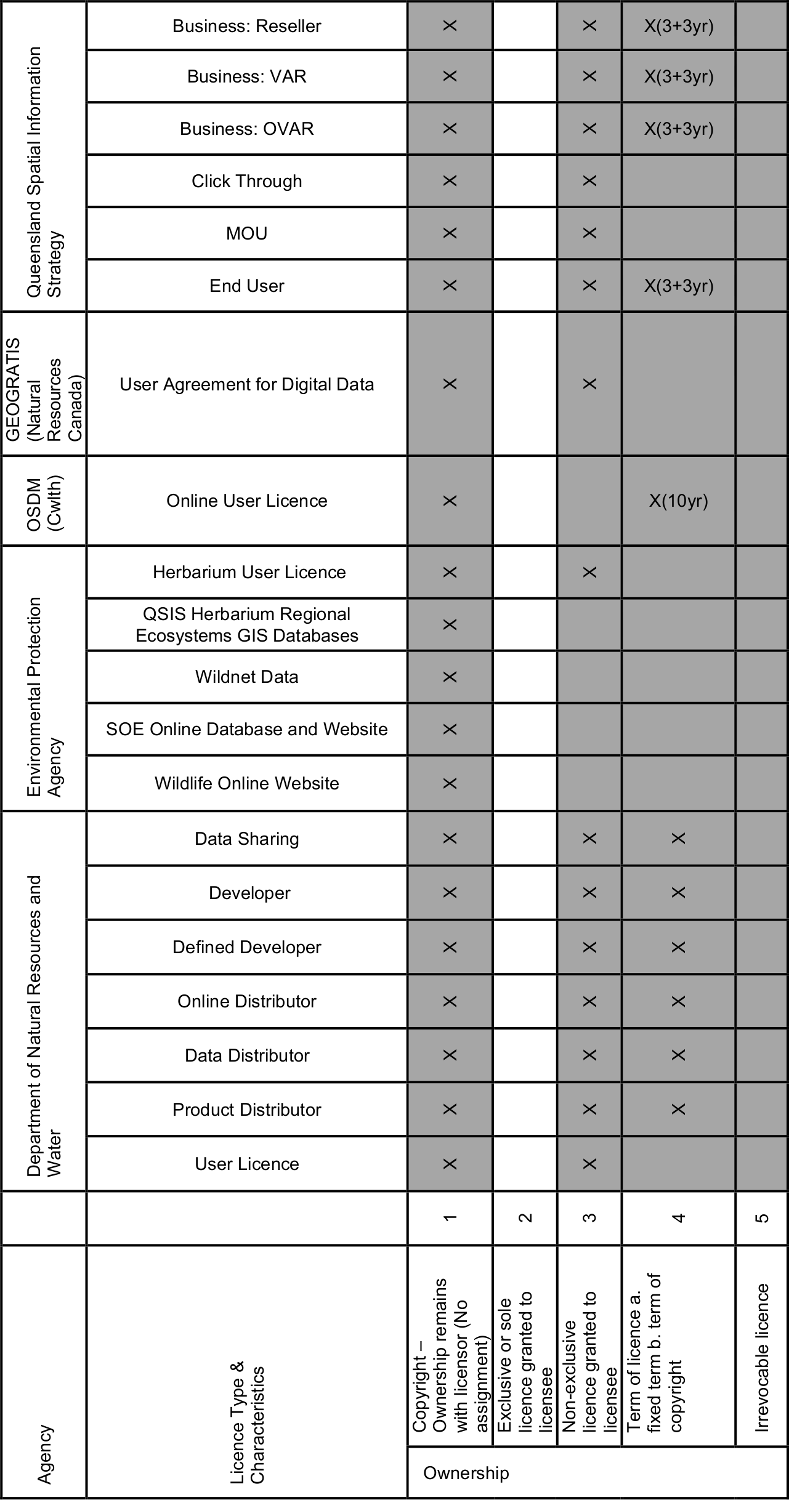
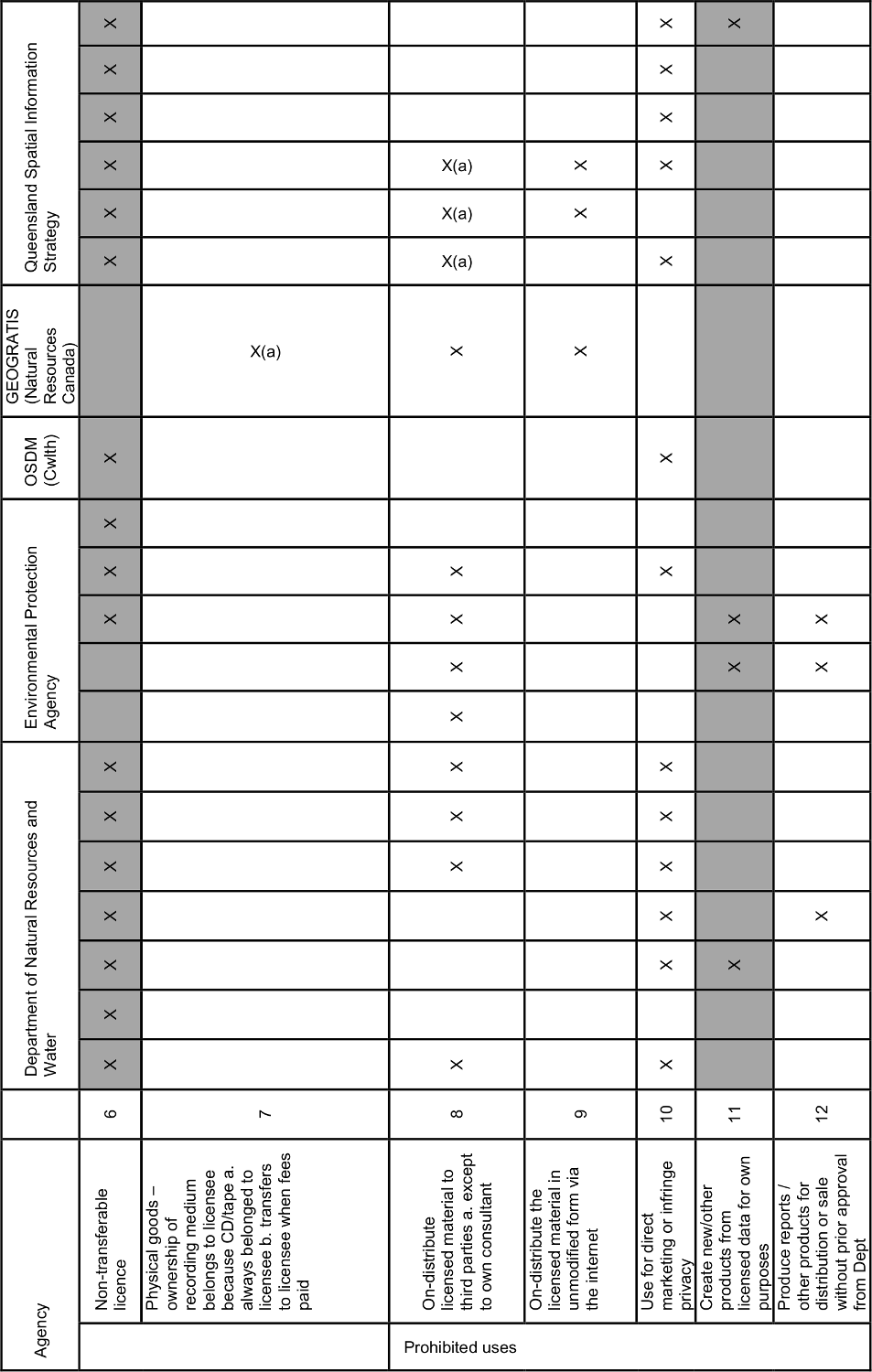
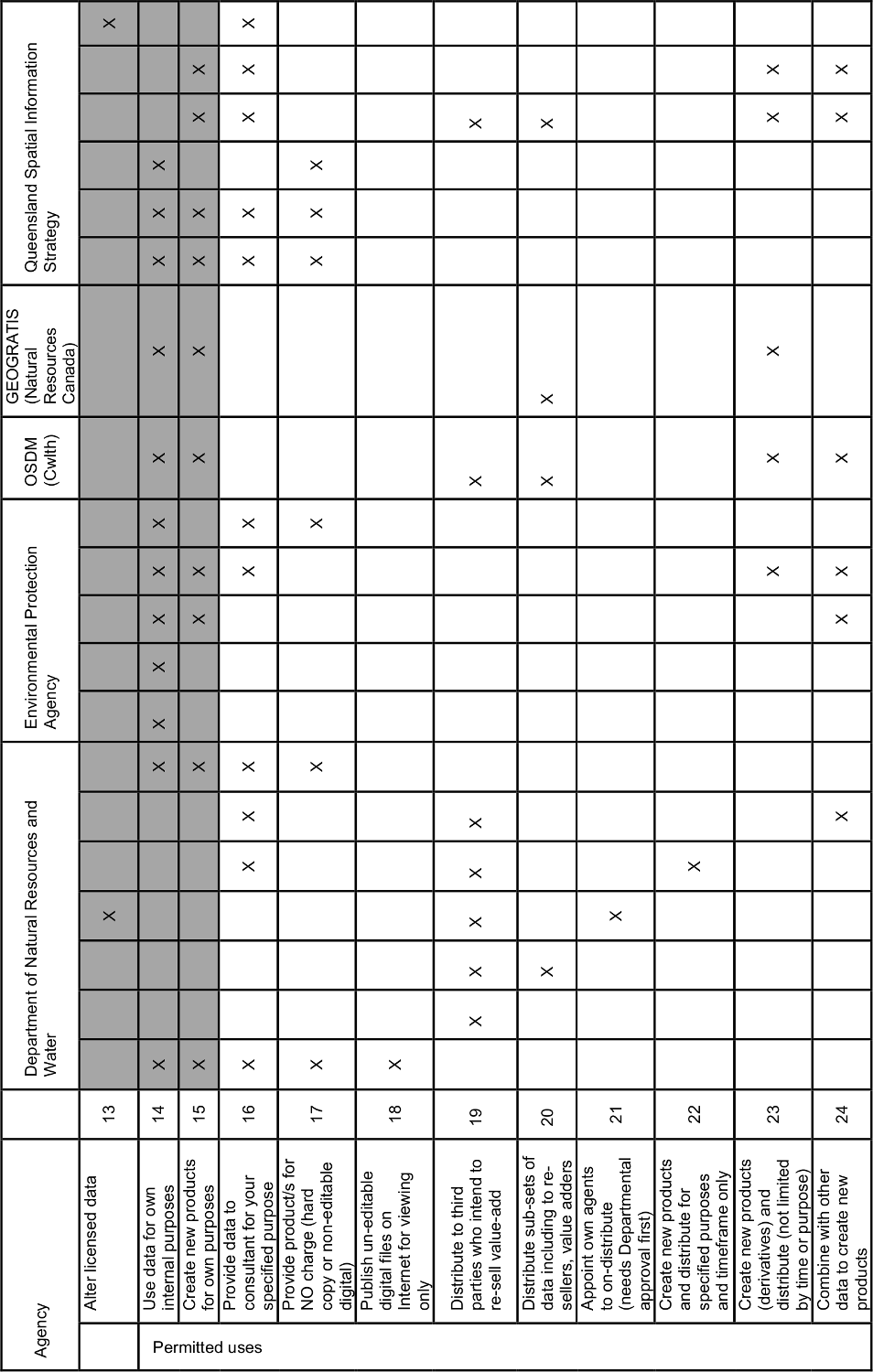
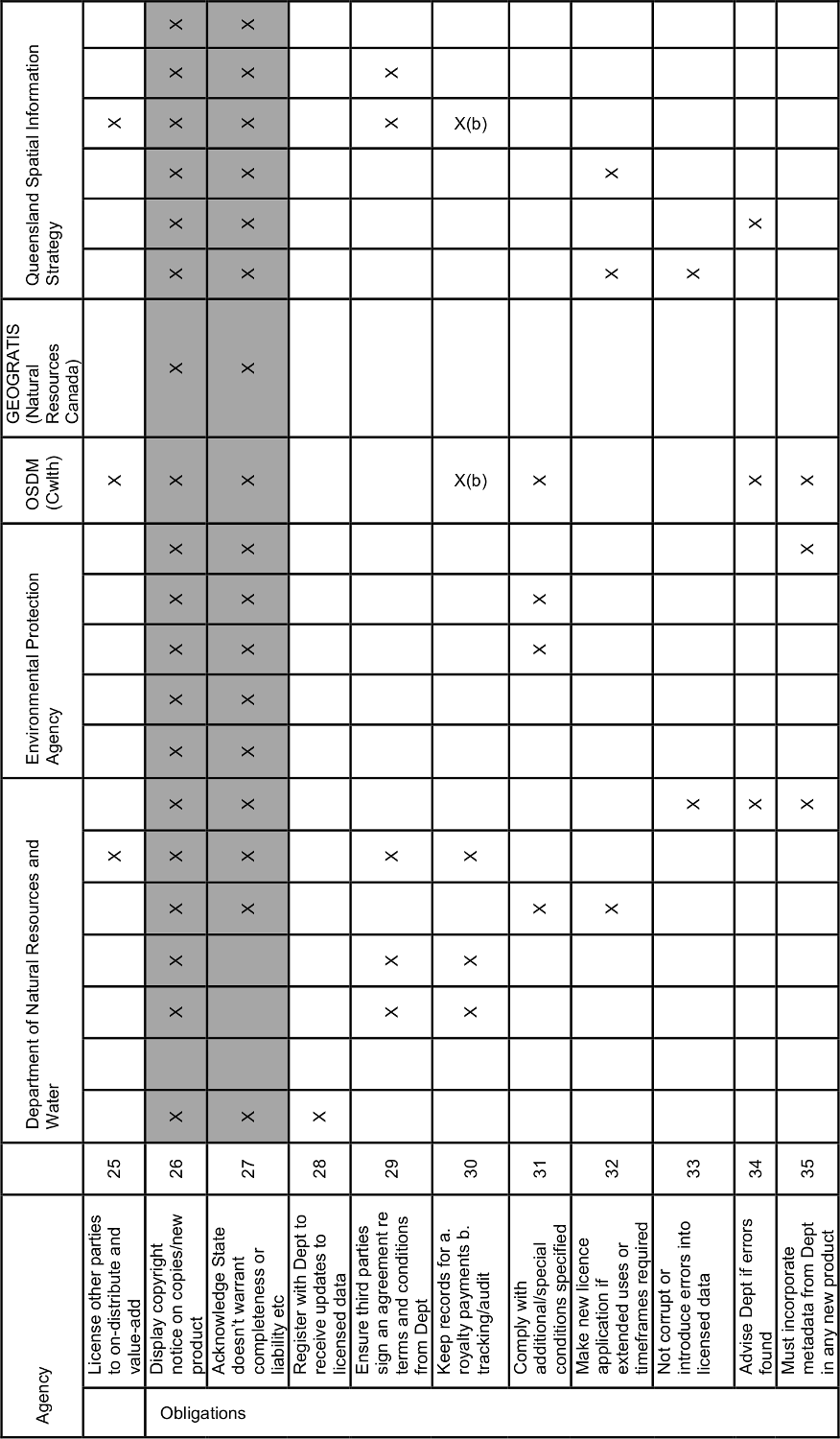
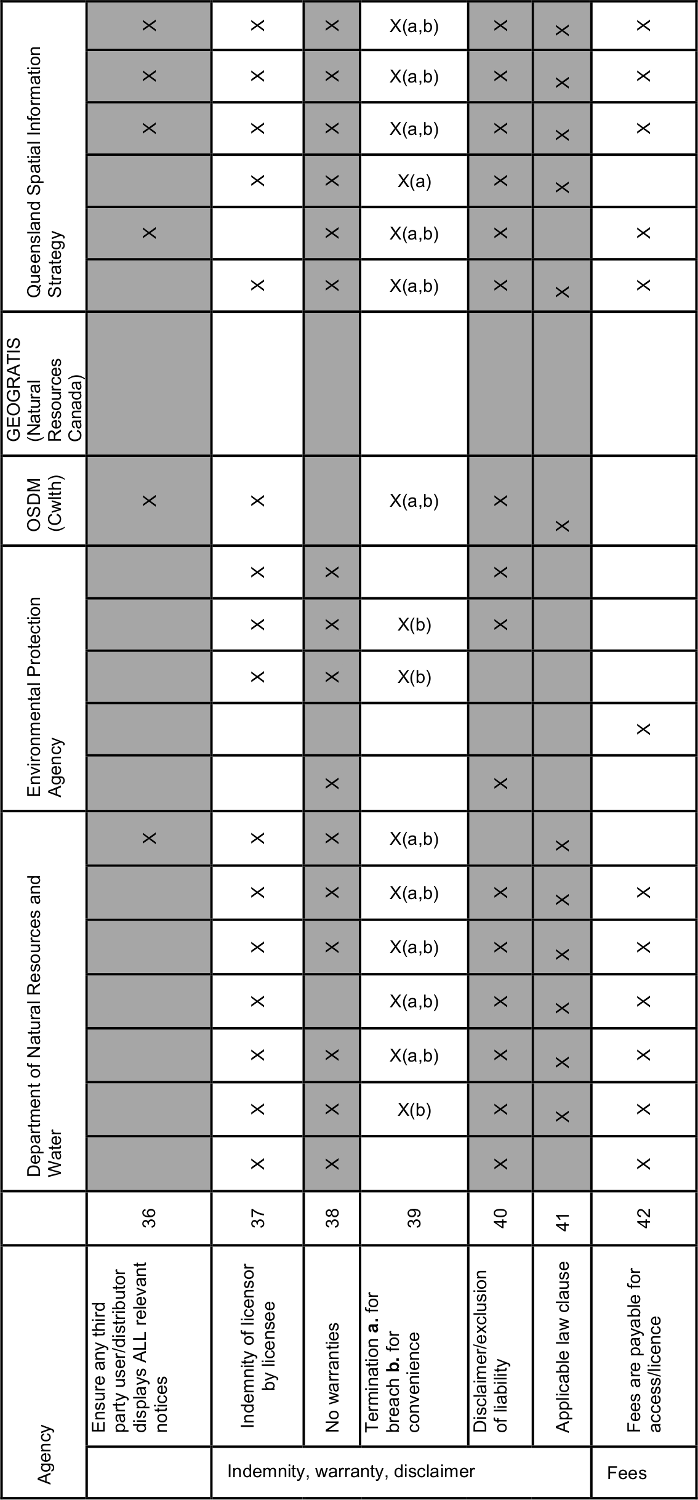
Table 8: Equivalent terms and conditions in six creative commons licences

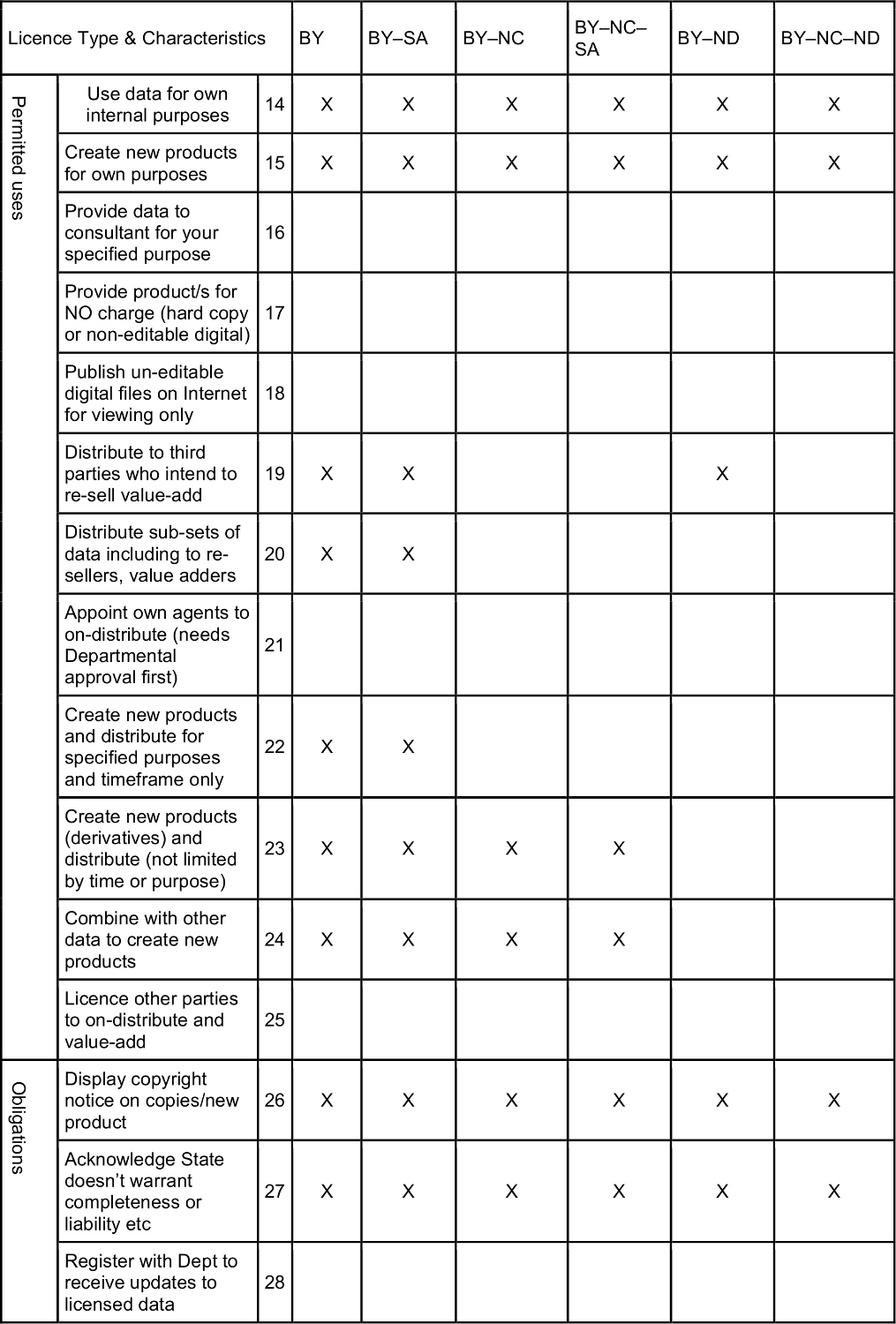
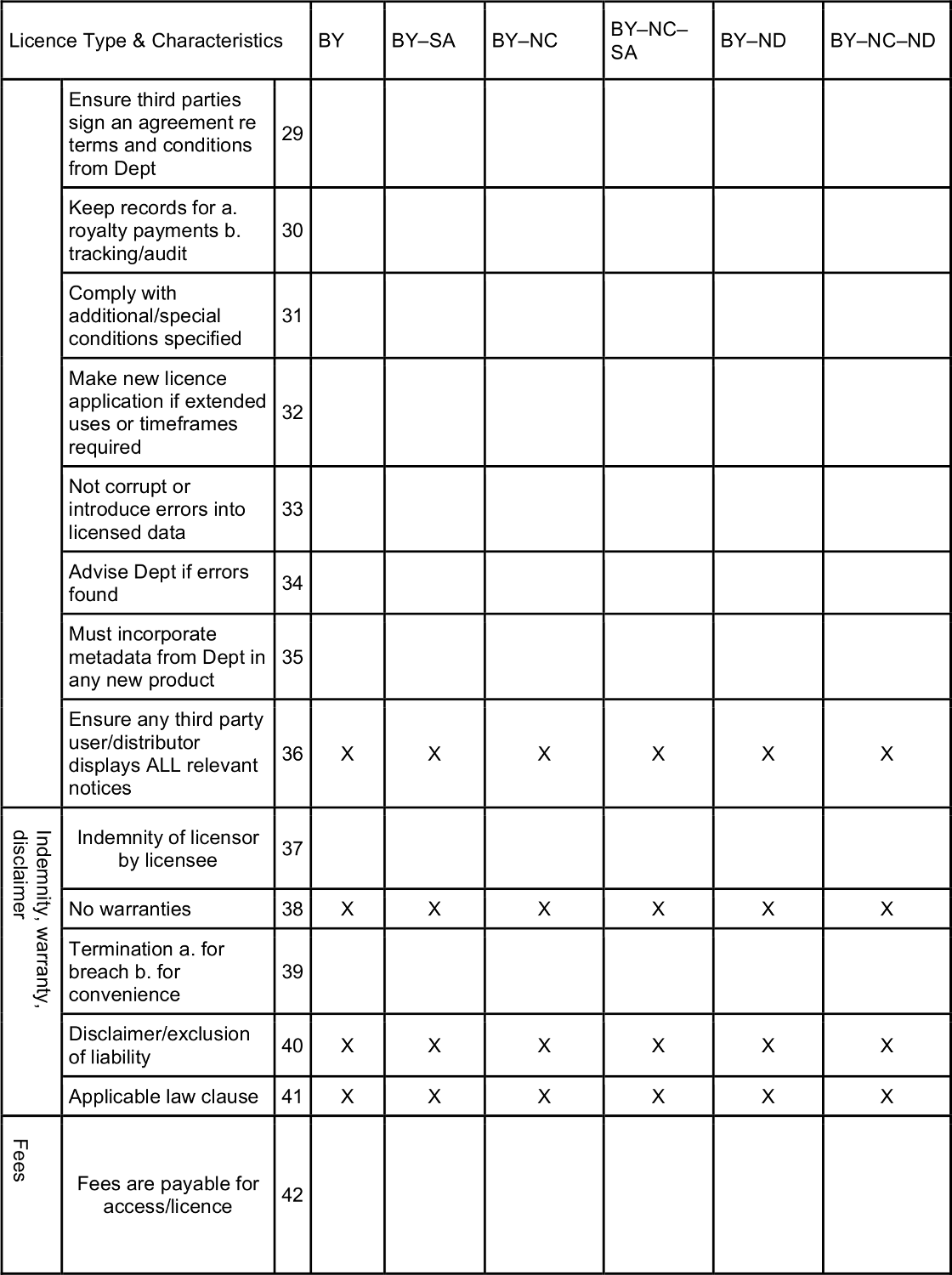
Table 9: Notes to the Department of Natural Resources and Water – Distributor Licences
| AGENCY Natural Resources and Water |
AGREEMENT IDENTIFICATION Data Distributor Licence | |
| Main Features | Clause Id | |
|
1. Ownership of intellectual property including copyright • Agreement does not transfer ownership of any intellectual property to the licensee [4.1.1] • State owns or is licensor of the intellectual property including copyright [4.1.2] |
4.1 | |
|
2. Licence type • Non-exclusive and non-transferable [1.1] • Licence has specified start and end dates and termination conditions [6.1, 6.2, 6.3, 6.4, 6.5] • Licence has dispute resolution clauses [7.1, 7.2] |
1.1, 6.1–6.6, 7.1, 7.2 | |
|
3. Permitted uses by licensee • Licensee can provide licensed data to customers, consultants for the specified purposes of this agreement [4.4] • If supplied to a consultant, that consultant must not receive any commercial consideration other than for the fee paid by the licensee [4.8.1] • Licensee is permitted to make copies of the licensed data for the purpose of this agreement and for security backup copies [4.7.1] |
4.4, 4.7, 4.8 | |
|
4. Prohibited uses by licensee • Licensee must not combine the licensed data with any other data to create other products [4.5.1] • Licensee cannot use the licensed data or a new product for any form of direct marketing or in breach of privacy laws [4.5.2] • Licensee must not use licensed data for own internal purposes [4.5.3] • Licensee must agree to be bound by any further restrictions specified by the licensor (specified in a schedule to agreement) [4.5.4] or any future legislations etc [9.12] • The licensee must not assign or sub-license any rights granted under this agreement without written consent of the licensor [9.6] • The licensee does not become a partner, employee or agent of the licensor and must not represent itself as such [9.8] • The licensee does not have the power or authority to enter any binding relationship with any third party for or on behalf of the licensor [9.8] |
4.5, 9.6, 9.8, 9.12 | |
|
5. Licensee’s obligations • Licensee must pay licence fees within 14 days of receiving licensor invoice [3.1] • Licensee must pay all royalty fees to licensor on a quarterly basis [3.1] • Licensee must not corrupt or introduce errors into licensed data and must notify the licensor if any errors in the licensed data are identified [4.2] • Licensee must agree that the licensed data is a valuable commercial resource of the licensor [4.3.1] • Licensee must agree to provide the licensed data only to its employees or consultants who need such access for the purposes of the licensee exercising its rights under the terms of this agreement [4.3.2] • Licensee must take all reasonable steps to protect the security of the licensed data [4.3.3]Licensee must not provide the licensed data to its consultants unless the consultant has first entered into an agreement with the licensee specifying the terms of this agreement [4.8.2] and that those agreements are consistent with the terms to this agreement and do not change their meaning [4.10.1, 4.10.2, 4.10.3, 4.10.4] • Licensee must ensure that all copies of the licensed data display the relevant notice (notice is specified in schedule to agreement) [4.6] • Licensee must ensure customers or consultants to whom the licensed data are supplied enter into an agreement with the licensee – by either a signed document or open network online agreement e.g. by click on ‘I Agree button’ [4.9.1 (i) (ii)] • Licensee must ensure that the metadata supplied with the licensed data is (at least) supplied to any customers or consultants [4.9.1 (iii)] • Licensee must take all reasonable steps to enforce the terms and conditions of this agreement [4.11] • Licensee must maintain records for the licensor and make these available for auditing – records relate to data distributions by licensee and for royalty payments back to licensor [5.1, 5.3, 5.3, 5.4] |
3.1, 4.2, 4.3, 4.6, 4.8, 4.9, 4.10, 4.11, 5.1–5.4 430 | |
|
6. Disclaimer of liability by licensor • The Department of Natural Resources and Water makes no representations or warranties in relation to the licensed data – excludes all liability to the extent permitted by law [8.1, 8.2] |
8.1, 8.2 | |
|
7. Indemnity by licensee • Licensee agrees to indemnify the State against all loss and liability (including consequential damages and negligence) in relation to the licensee’s use of the licensed data or any product made from the licensed data |
8.3 | |
| 8. Operates as a memorandum of understanding where the licensee is not a separate legal entity, e.g. another Queensland government department | 9.10 | |
| AGENCY Natural Resources and Water |
AGREEMENT IDENTIFICATION Online Distributor Licence | |
| Main Features | Clause Id | |
|
1. Ownership of intellectual property including copyright • Agreement does not transfer ownership of any intellectual property to the licensee [4.1.1] • State owns or is licensor of intellectual property including copyright [4.1.2] |
4.1 | |
|
2. Licence type • Non-exclusive and non-transferable [1.1] • Licensor can appoint other licensees to same licensed information products [1.2] • Licence has specified start and expiry dates and termination conditions [7.1, 7.2, 7.3, 7.4, 7.5, 7.6] • Licence has renewal clauses [8.1, 8.2, 8.3, 8.4] |
1.1, 7.1–7.6, 8.1–8.4 | |
|
3. Permitted uses by licensee • Licensee can provide licensed information products to end user by way of – display on end user computer screen, printout from computer screen, electronic online supply to end users, email delivered to end user’s computer (provided email is then deleted from licensee’s computer), facsimile [4.9.5] • Licensee can, with prior approval from licensor, appoint one or more agents according to certain terms and conditions [4.10.1, 4.10.2, 4.10.3 (i), (ii), (iii), (iv), (v)] – the licensee’s agent/s are required to sign a formal agreement (with consistent conditions to the licensor/licensee agreement) with the licensee [4.10.4, 4.10.5, 4.10.6] |
4.9, 4.10 | |
|
4. Prohibited uses by licensee • Licensee must not reformat or alter an information product except for some specific exceptions [4.3.1] (note – these exceptions are [4.4.1, 4.8.5, 4.10.3 (vi), 4.10.3 (vii)] – these are covered off in Obligations below) • Licensee cannot use the licensed data or a new product for any form of direct marketing or in breach of privacy laws [4.3.2] • Licensee must not produce reports or publications based in any information products for public sale or distribution without prior written permission from licensor [4.3.3] • Licensee must not store any information product on any system for more than three working days [4.5.1] • Information products must not be distributed to any other end user or used for any other purposes than satisfying the original request from an end user [4.5.2] • Licensee must agree to be bound by any further restrictions specified by the licensor (specified in a schedule to agreement) or any future legislations etc [10.12] • The licensee must not assign or sub-license any rights granted under this agreement without written consent of the licensor [10.6] • The licensee does not become a partner, employee or agent of the licensor and must not represent itself as such [10.8] • The licensee does not have the power or authority to enter any binding relationship with any third party for or on behalf of the licensor [10.8] |
4.3, 4.5, 10.6, 10.8, 10.12 431 | |
|
5. Licensee’s obligations • Licensee must pay licence fees, establishment fees, access fees and information products fees as per a schedule in agreement [3.1] • Licensee must account for and pay information product fees for any internal uses (i.e. uses in addition to online distribution to third-party clients) [3.3] • Licensee must agree that the licensed data is valuable commercial resource of licensor and that the online access mechanism through the licensor’s systems is confidential [4.2.1] • Licensee must take all reasonable steps to protect the security of the licensor’s system, including how the licensee manages access by its end users [4.2.2, 4.8.3, 4.8.4, 4.8.5, 4.8.6, 4.8.7, 4.8.8, 4.8.9] • Licensee must ensure that its employees use the licensed information products only for the purposes of exercising the licensee’s rights under the terms of this agreement [4.2.2] • Licensee must ensure that it maintains a firewall between its systems and those of the licensor to protect the licensor from unauthorised access to its systems [4.2.3, 4.8.1, 4.8.2] • Licensee must trade under one trading name for the purposes of this agreement [4.6.1] • Licensee must notify the licensor immediately if it becomes aware of any unauthorised uses of the information products or of the licensor’s system [4.7.1] • Licensee must promptly notify the licensor if it becomes aware of any unethical or dishonest uses of the information products [4.7.2] • Licensee must ensure that all copies of the licensed information products display the relevant copyright [4.4.1] • Licensee’s system must display the relevant copyright notice [4.10.3 (vi)] • Any alteration of the copyright notice displayed by licensee must be approved by licensor [4.4.2] • Licensee’s system must display a banner at the bottom of each information product with data and time of access request by end user [4.8.5] • Licensee’s system must insert a banner at the bottom of each information product with data and time of access request by end user in any licensee agent’s system [4.10.3 (vii)] • Licensee must provide the licensor with one authorised access to the licensee system (at no cost) and demonstrate to the licensor all and any new products created by licensee [4.7.3] • Licensee must not provide any information products to end users unless they have first entered into an agreement with the licensee and where the terms of this agreement are consistent with the terms to the agreement between licensor and licensee [4.9.1] • Licensee must ensure each end user agrees to the specified terms and conditions by either a signed document or open network online agreement e.g. by click on ‘I Agree button’ [4.9.3] • Licensee must ensure that the end user uses the information products only for its own internal purposes and does not on-supply or create new commercial products from the information products [4.9.4] • Licensee must maintain records for the licensor and make these available for auditing – records relate to data distributions by licensee and for royalty payments back to licensor [5.1, 5.2, 5.3, 5.4, 5.5, 5.6] |
3.1, 3.2, 3.3, 4.4, 4.6, 4.7, 4.8, 4.9, 4.10, 5.1–5.6 432 | |
|
6. Disclaimer of liability by licensor • Licensor makes some specific warranties including accuracy, completeness and limited compensation etc of information products. These are specified in a schedule for each information product. [9.1.1] • Licensee acknowledges and agrees it has not relied on representations, descriptions, illustrations or specifications from the licensor in entering into this agreement [9.1.3] • Licensor defines its liability for each information product in a schedule for each information product [9.2.1] • Except for specific liability guarantees in [9.1.1] and [9.1.2] – licensor makes no representations or warranties in relation to the licensed information products – excludes all liability to the extent permitted by law [9.2.2] • Subject to clauses [9.2.1] and [9.2.2] the licensor is not liable for and direct, indirect, consequential loss or damage sustained by licensee in connection with this agreement or information product including anything sustained through negligence of licensee [9.2.3] |
9.1, 9.2 | |
|
7. Indemnity by licensee • License agrees to indemnify the State against all loss and liability (including consequential damages and negligence) in relation to the licensee’s use of the licensed data or any product made from the licensed data [9.3.1, 9.3.2] |
9.3 | |
| 8. Operates as a memorandum of understanding where the licensee is not a separate legal entity, e.g. another Queensland government department | 10.10 | |
|
9. Licensor obligations • Develop, maintain and process the information products [6.1] • Does not acquire any rights of ownership of licensee’s system [6.2] • Process relevant data, use best endeavours to ensure information product is accurate, ensure its system is operative and accessible to licensee’s system, promptly correct faults in licensor’s system when needed [6.4] • Provide initial training of appropriate licensee’s staff, supply needed documentation (help, training guides, user support manuals etc), update these materials as required, supply test data for licensee for demonstrations and training [6.5] • Provide a nominated end-user support contact person in normal business hours [6.6] • Licensor supplies information at licensee’s own risk save the specific warranties given in [9.1.1, 9.1.2] |
6.1–6.6, 9.1 433 | |
| AGENCY Natural Resources and Water |
AGREEMENT IDENTIFICATION Product Distributor Licence | |
| Main Features | Clause Id | |
|
1. Ownership of intellectual property including copyright • Agreement does not transfer ownership of any intellectual property to the product distributor [4.3] |
4.3 | |
|
2. Licence type • Non-exclusive and non-transferable [1.1] • Licence has specified start and end dates and termination conditions [5.1, 5.2, 5.3, 5.4] |
1.1, 5.1–5.4 | |
|
3. Permitted uses by licensee • May distribute products to any third parties including those who intend to re-sell the products [4.2] |
2.1, 2.2 | |
|
4. Prohibited uses by licensee • The licensee must not assign or sub-license any rights granted under this agreement without written consent of the licensor [7.6] • The product distributor does not become a partner, employee or agent of the licensor and must not represent itself as such [7.8] • The product distributor does not have the power or authority to enter any binding relationship with any third party for or on behalf of the licensor [7.8] |
7.6, 7.8 | |
|
5. Licensee’s obligations • Ownership of products does not pass to product distributor until all fees are paid [4.1] |
4.1 | |
|
6. Disclaimer of liability by licensor • The Department of Natural Resources and Water makes no representations or warranties in relation to the licensed data – excludes all liability to the extent permitted by law |
6.1, 6.2 | |
|
7. Indemnity by licensee • Product distributor will indemnify the State against all loss and liability (including consequential damages and negligence) in relation to the licensee’s use of the licensed products |
6.3 | |
| 8. Operates as a memorandum of understanding where the licensee is not a separate legal entity, e.g. another Queensland government department | 7.10 | |
|
9. Ordering, accounts and product costs • A schedule is used to specify products sought, volumes and any discount pricing arrangements – orders sent to department’s contact officer in schedule [3.1, 3.2] • A credit account with the department can be established for the distributor – this account has management fees and payment conditions attached [3.4, 3.5, 3.6] |
3.1–3.6 434 | |
ATTACHMENT 5: CONSIDERATIONS FOR THE TECHNICAL IMPLEMENTATION
GENERAL OUTCOMES
The technical implementation of the project should give effect to the legal requirements of the project in a practical way.
NOTES
This document is, as far as possible, agnostic with respect to licence, technology and policy. This document is a first draft.
DEFINITIONS
Where possible the terminology used in this report is consistent with the draft Government Enterprise Architecture (GEA) White Paper Information Architecture.
GENERAL SPECIFICATION
The system will need to select and present a licence to the consumer, which must be accepted before the payload may be accessed. The presentation must constitute effective notice to the consumer of the terms under which they take the payload.
Licence Selection and Presentation – Minimum Requirements
- If per-consumer licensing is to be undertaken, the system presents the appropriate licence on a per-consumer basis, using rules set by the information custodian
- The consumer must agree to the licence in a binding way, either as a memorandum of understanding (for any organisation which contracts as the Crown in right of the State of Queensland) or as a contract for licence (any other person)
- The system must log the provision of the payload under that licence to the consumer.
Licence Selection and Presentation – Optimal Solution
- The system highlights to the consumer the specific metadata relating to limitations of use of the payload (for example, inaccuracies which render the information inappropriate for use in navigation)
- The system embeds or attaches the selected licence as Electronic Rights Management information in the payload.
Overall Process Flow
1) Consumer searches metadata fields to find the relevant payload
2) Consumer examines detailed metadata for payload to determine suitability
3) Consumer is authenticated as permitted to download that payload
4) Consumer accepts the appropriate licence conditions
5) Consumer provides/authorises any financial transaction information
6) Consumer is provided with the payload. 435
Steps 1 and 2: Consumer Search and Selection
An example of this can be seen on the Infolinks site.
The first iteration of the search function will present a basic search or an advanced search, as well as the ability to browse through the datasets available. The basic search should search a predefined set of metadata fields. The advanced search should present an interface to limit searches to specific fields, or to combine and refine searches etc. One of the searchable fields may be the licence fields themselves. It may be appropriate to allow a combination of text-based searches and setting of geographic constraints through a mapping tool (such as the tool on Information Queensland or Infolinks).
The metadata must be kept up to date to make this a worthwhile tool. Currently updates by custodians are undertaken on an irregular basis other than when prompted by the Office of Economic and Statistical Research staff. This practice will need to change – the accuracy of the metadata will directly relate to the value of the information to the wider community. Limited or inaccurate metadata will increase the cost to the consumer to find the data, or make it virtually impossible to find the data.
The actual metadata fields conform to the profile maintained by the Office of Economic and Statistical Research.
The metadata profile may need to be amended to include specific information on the licensing option. Of the current fields in the metadata profile, the ‘2.20.5 User Note’ field is the most appropriate to use, but this field would be best used to explain in general terms the licences. This will depend on whether the payload is offered under a single licence (licence ‘per-payload’), or if the same payload may be provided to different persons under different licences (licence ‘per-consumer/payload’). An example of this second option is the current suite of licences of the Department of Natural Resources and Water.
A new repeatable field in the profile which contains specific licensing information, through a few refinement fields, would be the best solution. This would be repeatable to cater to licensing per consumer/payload.
It would be advantageous for each dataset to reside at a static URL, for simplicity of revisiting frequently used datasets.
A search function based on time should also be available. Suggested searches include:
- All new datasets since last time the account was accessed.
- All datasets which were previously downloaded by the consumer, which have been updated since that last download.
Questions/Actions
Action 1: Finalise the licensing model: whether licensing is done per-consumer/payload or only per-payload.
Action 2: Adapt the metadata profile depending on the licensing model selected by the project.
Action 3: Ensure the metadata is kept up to date. (This is currently handled by the Office of Economic and Statistical Research staff in conjunction with database custodians).
Action 4: Define the fields to be included in a ‘basic search’. 436
Step 3: Authentication
It is most likely that authentication will be done through creating and then logging into an account. (Please note, the term ‘account’ here is used to denote a username/password, not a ‘financial’ account).
Policy will determine the level of information the consumer must provide to create an account. Alternatives range from the minimum of providing merely a username and password, through to providing alternative (non internet) contact information. Once provided, there is also a question of how much of the information is verified automatically or manually before activating the account.
With the ‘qualification’ process that will be undertaken to ensure that all databases accessible through the system are appropriate for public use (and the probable outcome that at least the first group of databases will be appropriate for licensing to consumers under a bare ‘attribution’ licence), it may be appropriate to only include automatic verification. A common automatic verification system is to require the consumer to include an email address in the information in their application for an account with the system. The consumer is then emailed a code to the provided email address, which is used to activate the account. Further limitations on this are also sometimes used (such as not allowing ‘free’ email addresses to be used for this verification step, etc). This establishes a minimum level of trust between the system and the consumer – that the consumer has offered a valid email address.
This system can then be expanded when further databases come online which require more extensive authentication to allow for accounts to be ‘upgraded’ by an administrator when they are verified as permitted to access more content.
The system may also provide for corporate group registration, where an account will be used by anyone within (say) a department or company. It may be advantageous to allow multiple individual accounts under a company account, for cost and access tracking purposes (see the section on financial transaction). If grouping of accounts is implemented, a system for the holder of the overall group account to add new accounts to that group account would cut administration overhead.
As with any collection of data, the privacy policy for the site should be in place and potentially presented to the consumer during the account creation process.
Action 5: Determine whether automated account creation is appropriate.
Rec: Automated account creation with limited automated verification should be used for creation of ‘public’ accounts.
Action 6: Determine the level of information required to be provided to create an account.
Rec: The minimum standard should be first and last name, city/suburb, state, country, date of birth and a valid email address. Investigation of methods to block ‘free’ email accounts should be considered, with regard to the increasing reliance on free email accounts for many users.
Action 7: Determine whether ‘group’ accounts should be supported.
Rec: Group accounts will simplify the granting of access to users in a company or organisation, and simplify e-commerce. Failing to allow multiple users to attach to a group account will encourage the creation of a single account for a company, which will impede logging of user activity.
Action 8: Plan for further authentication steps and access levels when more sensitive data is brought online. 437
Step 4: Licence Presentation
The licence must be presented in a way that constitutes clear notice of the terms to the consumer, which must be positively accepted before the process can continue. Lessons learned from other licensing cases should be put into practice here, so for example the consumer should be required to ‘read’ all of the licence before being able to accept it.
As part of this process, the consumer must also be presented with a second screen detailing the restrictions on using the payload – this is drawn from a mandatory field in the metadata (‘2.20.1 Use Limitation’).
Action 9: Determine ‘look’ and method of the licence and limitations presentation.
Action 10: Ensure the use limitation field is kept up to date.
Step 5: Consumer Provides/Authorises Any Financial Transaction Information
This step may not be used on the first set of qualifying databases. However, it must be planned for. Some databases may be subject to statutory fees, and some may be licensed only under cost recovery schemes.
There will be two methods of approaching this. The first is to include in the metadata profile a field detailing the cost to access the payload under a specific licence. The second is to maintain the pricing and other information in a separate system. The choice of this will depend on the complexity of pricing structures – the more complex the more a separate pricing system is indicated. Another consideration is that if the pricing information is included in the metadata, all consumers that search the metadata will have access to the different pricing details. This may assist in meeting transparency and non-discriminatory pricing goals.
There should be provision made for account customers either to pre-pay a balance or to allow invoicing on terms for all access from the account. As above, it may be advantageous to allow a corporate account to which a number of individual account’s transactions are charged.
The decisions required here are business/policy decisions likely to be made externally to this project, so no action items are suggested at this time.
Step 6: Presentation of the Payload
The payload will consist of the data in an appropriate format, the metadata, and a copy of the licence under which the data was taken. As an example, the consumer may be presented with an archive file consisting of a Microsoft Excel spreadsheet (an XLS file) containing statistical data, an XML file containing the metadata, and a text file containing the licence details.
If possible, it would be advantageous for at least a subset of the metadata (including the licence under which the data was taken) to be embedded directly in the data file itself. This can be done in certain file formats which have flexible metadata structures which may be adapted to contain licence information. As an example, see the CC Microsoft Office add-in.
If the payload is licensed on a per-consumer/payload basis, the payload will need to include the correct version of the licence in the licence file, the metadata and the embedded metadata. This may be generated at the time the payload is delivered, or be manually compiled and then simply selected and delivered by the system.
The licence should make explicit that removing the metadata or licence information from the package is an offence (see the Electronic Rights Management information section of the Copyright Act 1968 (Cwlth) Division 2A.
The presentation of the payload should (if possible) be accompanied by basic information about how to access the data – for example links to free data viewers appropriate to the data format 438selected. It may also be appropriate to link to some basic datasets that are released under compatible licences (the CC BY licence is compatible with all other CC licences) which will give context to the selected dataset. For example, links to basic maps of Queensland and Brisbane in the selected file format may be appropriate, along with basic information about how to use them as context on the selected dataset.
Technological challenges here depend very much on decisions made in previous sections, so no specific action items are suggested at this time.
EXAMPLES OF USER EXPERIENCES
The following experiences assume some of the recommendations made above, and also assume that the CC licences and licensing model is selected for implementation.
Example 1: first time ‘casual’ consumer
A property developer (‘Jane’) is considering purchasing a currently undeveloped parcel of land. Concerned about wildlife habitat issues, Jane accesses the Information Queensland site.
Step 1: Using the map, Jane selects the greater Brisbane area as a boundary, and then enters the Boolean search term ‘endangered OR threatened’ into the basic search box. The system will present her with all of the datasets which have any geographic extents falling within the selected area, and including the terms ‘endangered’ or ‘threatened’ in the defined ‘basic’ metadata fields.
Step 2: Jane can now review the descriptive metadata of all of the datasets that the search has returned, can further refine the search by adding a new term, or can clear the search and use an advanced search to only search for those terms in a specific metadata field. After reviewing the returned records, Jane finds a dataset comprising spatial data on locations of endangered bird species in the ESRI Shapefile format, and selects the ‘download’ link.
Step 3: At this point, the system will ask her to log in. As this is the first time she has accessed this site, she must create an account on the site. After being presented with the site’s privacy policy, Jane provides her full name, date of birth, company name and a valid email address. Jane is then asked to check her email account. Jane checks her account, and receives an email with a coded link to follow which will enable her account with Information Queensland, verifying that she has provided a valid email address. Now that she has created an account, she may log in and complete the authentication process as a ‘public’ consumer – a user with no special permissions.
Step 4: The system then checks the licensing information in the metadata, and presents a screen with the appropriate licence for a public consumer. For this data, the custodian has used the licensing toolkit to select an ‘attribution’ licence as appropriate for all users. Jane is presented with the CC BY licence deed, including a highly visible link to the full text of the licence. Agreeing to the licence, Jane is then presented with the usage information field from the metadata – which informs Jane that the data is to be used only for environmental study, and should not be relied on for land development purposes. Jane again indicates that she has read the usage information, now knowing that she will need to undertake further research before finalising the decision to purchase the property. Finally, the system presents Jane with a notice that the licence terms are only valid for the entire payload – that she may not separate the metadata or licence information from the data files.
Step 5: The data custodian has indicated that there are no fees for accessing this information, so there is no e-commerce step in this transaction. 439
Step 6: The system presents a download link to the payload, along with links to some basic information about free tools to view the data. The payload in this case consists of an archive file, containing the following individual files:
- A TXT file with the CC BY licence
- An XML file with the metadata (including the licence terms)
- An SHP file, an SHX file, and a DBF file, which combined contain the actual mapping data
- An SHP.XML file, which mirrors much of the metadata (including the licence terms).
Example 2: A repeat ‘corporate’ user
A legal research clerk (‘Cameron’) has been tasked with finding all recent traffic usage surveys on a road next to a major shopping centre, to support an application for a permanent closure of the road. This is a common request from his supervising partner at the firm Hutz and Simpson.
Steps 1&2: Cameron goes directly to the advanced search function, and searches for the name of the dataset. The search returns 1 result. He reviews the metadata, sees that the dataset has been updated since he last accessed it, and selects the download option.
Step 3: Cameron logs into his account on the system using his username and password, which is linked to the Hutz and Simpson group account. The office manager at Hutz and Simpson created the corporate account, and uses a special account administration screen to link the accounts created by Hutz and Simpson employees to the main group account.
Step 4: The data custodian has indicated that this dataset may only be licensed to nongovernment consumers under a CC BY–ND licence (so that it may be used, but no derivate works may be created). Cameron agrees to the CC BY–ND deed, the use restrictions from the metadata, and the notice to not separate the licence and metadata from the payload.
Step 5: The data custodian for the traffic dataset has indicated that there are statutory fees totalling $125 which must be collected for corporate access. Hutz and Simpson prepay for access and have more than $125 in their account. Cameron is presented with a virtual invoice for $125 to accept.
Step 6: The system presents a download link to the payload, along with links to some basic information about free tools to view the data. The payload in this case consists of an archive file, containing the following individual files:
- A TXT file with the CC BY–ND licence
- An XML file with the metadata (including the licence terms)
- A KML file that is the actual traffic data (and embedded in the KML file is metadata including the licence terms).
Example 3: A government department user
An employee of the Department of Emergency Services (‘Wendy’) is also looking for traffic usage surveys, this time for route planning purposes.
Steps 1&2: Wendy follows a bookmark in her web browser directly to the dataset she needs.
Step 3: Wendy logs into her account on the system using her username and password. Her account is linked to the Department of Emergency Services group account. 440
Step 4: The data custodian has indicated that this dataset may be licensed to government consumers under the CC BY licence. Wendy accepts the CC BY deed, use restrictions from the metadata and the notice not to separate the licence and metadata from the payload. As a government consumer, this takes the form of a memorandum of understanding rather than a binding contract.
Step 5: Rather than the statutory fee which is charged for non-government clients, the system merely records that the data was taken by the Department of Emergency Services.
Step 6: The system presents a download link to the payload, along with links to some basic information about free tools to view the data. The payload in this case consists of an archive file, containing the following individual files:
- A TXT file with the CC BY licence
- An XML file with the metadata (including the licence terms)
- A KML file that is the actual traffic data (and embedded in the KML file is metadata including the licence terms). 441
ATTACHMENT 6: BACKGROUND RESEARCH
There is an increasing amount of activity, at national and international levels, directed at the development and implementation of systems to enable information and content generated or held by public sector institutions, publicly-funded universities and research institutes to be more readily accessed and re-used.
Although attention since the 1980s, has been given to improving access to public sector information, efforts to facilitate access and re-use have strengthened in recent years. As well as advances in computing technology, an important contributing factor has been the body of economic research over the past decade which points to the advantages gained by enabling access to and re-use of public sector information.1
One of the most influential texts has been Carl Shapiro and Hal Varian’s Information Rules: A Strategic Guide to the Network Economy (1999), which clearly explains the economic theory underlying the valuing of information.
‘Technology changes. Economic laws do not…2
Economists say that the production of an information good involves high fixed costs but low marginal costs. The cost of producing the first copy of an information good may be substantial, but the cost of producing (or reproducing) additional copies is negligible. This sort of cost structure has many important implications. For example, cost-based pricing just doesn’t work. A 10 or 20% mark-up on unit cost makes no sense when unit cost is zero. You must price your information goods according to consumer value, not according to your production cost.
Since people have widely different values for a particular piece of information, value-based pricing leads naturally to differential pricing…3
When managing intellectual property, your goal should be to choose the terms and conditions that maximise the value of your intellectual property, not the terms and conditions that maximise the protection’.4
In a study commissioned by the US Computer and Communications Industry Association, ‘The Role of Government in a Digital Age’ (2000), Stiglitz et al. examined the appropriate role of governments in the online and information environment.5 The study proposed a set of principles to guide government involvement, based on a recognition that while governments have a role to play, it should not extend too far into downstream value-adding activities. Stiglitz’s principles for online and informational government activity are the following:
- ‘Green Light’ for Online and Informational Government Activity
– Principle 1: Providing public data and information is a proper governmental role 442
– Principle 2: Improving the efficiency with which governmental services are provided is a proper governmental role
– Principle 3: The support of basic research is a proper governmental role
- ‘Yellow Light’ for Online and Informational Government Activity
– Principle 4: The government should exercise caution in adding specialised value to public data and information
– Principle 5: The government should only provide private goods, even if privatesector firms are not providing them, under limited circumstances
– Principle 6: The government should only provide a service online if private provision with regulation or appropriate taxation would not be more efficient
– Principle 7: The government should ensure that mechanisms exist to protect privacy, security, and consumer protection online
– Principle 8: The government should promote network externalities only with great deliberation and care
– Principle 9: The government should be allowed to maintain proprietary information or exercise rights under patents and/or copyrights only under special conditions (including national security)
- ‘Red Light’ for Online and Informational Government Activity
– Principle 10: The government should exercise substantial caution in entering markets in which private-sector firms are active
– Principle 11: The government (including government corporations) should generally not aim to maximise net revenues or take actions that would reduce competition
– Principle 12: The government should only be allowed to provide goods or services for which appropriate privacy and conflict-of-interest protections have been erected.
One of the most significant initiatives in the re-use of public sector information in recent years has been the EU’s Directive on the re-use of public sector information. The EU Directive was adopted by the European Parliament and Council on 17 November 2003.6 The EU Directive, which aims to facilitate the development of European data products based on public sector information, was the culmination of efforts that began in the late 1980s.7 European content firms engaged in the aggregation of information resources into value-added information products, were perceived to be at a competitive disadvantage in comparison to their US counterparts, due to a lack of clear policies or uniform practices in relation to access to and re-use of public sector information. The lack of harmonisation of policies and practices regarding
443public sector information resources among the European Union Member States was regarded as a barrier to the establishment of European information products that were based on information obtained from different countries.8 By contrast, the situation in the US was seen as providing extensive opportunities for the re-use of public sector information, due to a legislative framework which enhanced access to and re-use of Federal government information. Features of the US legal framework which were identified as contributing to the advantageous position of US firms include:
- citizens and businesses have a broad right to electronically access Federal government information and can re-use it for commercial purposes
- there is no copyright on Federal government materials
- there are no restrictions on re-use
- fees for re-use are limited to, at most, marginal costs for reproduction and dissemination.9
European Union Member States were required to bring their national laws into conformity with the Directive by 1 July 2005 and to review the application of the Directive by 1 July 200810,11 By 15 December 2005, 12 countries (including France, Ireland, Italy, Sweden, the Netherlands and the UK) had notified the European Commission that they had given effect to the Directive.12 In the UK, the Directive has been given effect by the Re-use of Public Sector Information Regulations 2005 which came into force on 1 July 2005 and in May 2005 the UK government established an Office of Public Sector Information with the responsibility for the coordination of policy standards on the re-use of public sector information.13,14
444While the Directive has established a European Union-wide legal framework governing policies and practices relating to the re-use of public sector information, it should be viewed alongside other European Union initiatives designed to make digital content in Europe more accessible, usable and exploitable. Of particular relevance is eContentplus, a four year program (2005–08) established by the European Commission’s Directorate-Generale for Information Society and Media, with a budget of €149 million ‘to tackle organisational barriers and promote take up of leading-edge technical solutions to improve accessibility and usability of digital material in a multilingual environment’.15 The eContentplus program has targeted three specific areas where development has been slow and the program can have a maximum impact, i.e. geographic information, educational content, and cultural, scientific and scholarly content.16 The aim of the program is to facilitate ‘access to digital content, its use and exploitation, enhancing quality of content with well-defined metadata, and reinforcing cooperation between digital content stakeholders’.
AUSTRALIAN COMMONWEALTH GOVERNMENT AGENCIES
In November 2005 the Commonwealth government agencies – the Office of Strategic Data Management and the National Data Network (National Data Network – in particular one of its key members, namely the Australian Bureau of Statistics) abandoned their longstanding ‘traditional’ restrictive government licensing practices in relation to their datasets, which included charging fees for the data and severely restricting or prohibiting commercial downstream use of the data by the licensee or others, and largely embraced the core principles or philosophy of the open content licensing movement, including CC.
Since November 2005 these Commonwealth government agencies have virtually removed all data charges, and restrictions on downstream use of their datasets, whether commercial or otherwise. Therefore the current licence agreement being used by these Commonwealth agencies for online access to, the download, and further use of their data, strongly resembles in many key respects an open content licence because the very broad rights to use commercially or otherwise, including the right to sub-license, are granted subject only to rather modest requirements including the explicit recognition (attribution) of the Commonwealth’s ownership of the intellectual property rights in the dataset, and certain record keeping and reporting obligations, with reports only to be provided on reasonable request by the agency. Nevertheless there are still some legal conditions included such as the requirement of an indemnity which are not generally included in open content licences.
Put simply, these fundamental changes in access and management practices represent a major paradigm shift on the part of these Commonwealth government agencies and a most significant
445step towards embracing the open content licensing principles and philosophies of only ‘some rights reserved’ as opposed to the traditional copyright ‘all rights reserved’ licence. The main feature of the open content licensing models, including the CC, is the requirement for the acknowledgement or attribution of copyright ownership and then the granting of a range of generous rights of use, the precise scope is determined by which licence is selected from the six standard licences on offer under the Australian chapter (iCommons) of the CC regime.
Whether or not or by coincidence this fundamental change in Commonwealth licensing practice coincided closely with the first public release of a report entitled Unlocking the Potential: Digital Content Industry Action Agenda, Strategic Industry Leaders Group report to the Australian Government, November 2005.17
Of particular relevance for present purposes is the following extract taken from the report.
3.5 INTELLECTUAL PROPERTY
Issues
- Low levels of industry knowledge about managing intellectual property
- The importance of effective intellectual property management to build revenue in firms
- Insufficiently developed mechanisms for accessing Crown intellectual property for exploitation.
Proposed solutions
- Identify and develop ways that firms can strengthen their protection of intellectual property, particularly by incorporating skills in identifying, managing and commercialising intellectual property into training frameworks
- Engage with work occurring in the area of alternative approaches to intellectual property licensing, such as CC
- Develop ways of improving access to Government intellectual property for commercial exploitation by digital content firms to encourage innovation.
Developing the efficient operation of copyright industries in the online environment has been a priority since 2000, when the Government introduced the Digital Agenda copyright reforms.
Improved information and research into the management and use of digital copyright content will make an important contribution to efficient industries. A wide range of studies have been undertaken on these issues and there is a strong body of ongoing research in Australia and internationally, particularly in the areas of eLearning and digital rights management.
The Digital Content Industry has determined that, in the context of the Action Agenda’s primary role to focus on measures to support industry development, the most significant intellectual property issues relate to:
- improving awareness about intellectual property management
- promoting mechanisms to support the Digital Content Industry in using its intellectual property to generate revenue streams.
446Measures to promote intellectual property management underpin each strategy to advance industry development skills, research and development, investment and export’.18
Clearly this Report contains a strong encouragement for the broader uptake of the CC licensing regimes by Commonwealth agencies in relation to ‘Crown intellectual property’. The two significant Commonwealth agencies mentioned above have promptly put the recommendations into practice and are now looking directly at the CC model to see whether it might be implemented more directly.
Clearly it would appear that whilst the recommendations contained in the Report are not official government policy nevertheless there is an unmistakeably strong push by the Commonwealth government to have its intellectual property promoted out into the private sector to support industry growth.
In this context the principles and objective of the Licensing Project may be seen to be entirely consistent with the Commonwealth’s philosophy of greater access to and use of ‘Crown intellectual property’. For the purposes of this analysis, Queensland public sector databases which have satisfied the qualifying principles (qualifying databases) are ‘Crown (the State of Queensland) intellectual property’.
THE NEED TO DEVELOP POLICIES AND GUIDING PRINCIPLES TO SUPPORT MORE OPEN LICENSING ARRANGEMENTS
The development of systems for access to and re-use of public sector information needs to be based on a clear statement of overarching policy supplemented by guiding principles.
The general policy applying to information access and re-use needs to be clearly stated in appropriate documents (e.g. IS25, IS33, IS45 etc), which may need to be revised to ensure that they accurately reflect current policy.
A sufficiently detailed set of guiding principles based on the general policy needs to be developed, to provide guidance to government agencies in the implementation of the policy. As the principles will guide the implementation of the policy they need to be sufficiently detailed to be used to inform the development of licensing models and practices and should form the basis of implementation toolkits developed for use by individual agencies.
Experience to date in Australia and internationally shows that the development and adoption of a general policy and guiding principles are crucial steps in the implementation of systems designed to promote access to and re-use of public sector information.
For example, the importance of basing an access regime on an appropriate policy and guiding principles was recognised in the Intrallect and University of Edinburgh report commissioned by the UK’s Common Information Environment, Common Information Environment and Creative Commons (2005), and in the Australian Government’s Office of Spatial Data Management, A Proposal for a Commonwealth Policy on Spatial Data Access and Pricing Policy (2001).19 Statements of the principles underlying access and re-use are also central to the EU’s Directive on the re-use of
447public sector information of 2003 and the OECD’s Declaration on Access to Research Data from Public Funding (2004).20
The research and consultations conducted to date in the Government Information Licensing Framework Project (Stages 1 and 2) support a policy position that agencies should make public sector information available for access and re-use, unless there is a clear and justifiable reason why they should not. The guiding principles developed in other public sector information re-use projects address issues such as:
- materials should be made readily available, e.g. online, in electronic form and discoverable by search engines wherever possible and in formats that interoperate with other systems
- materials should be made available free of charge over the internet or at no more than the marginal cost of transfer for packaged products
- the conditions of use (licence terms) for the material should be transparent, e.g. conditions of use should be linked directly to the material so that users can immediately understand the basis on which the material is being made available and what re-use rights they have, so the material is re-usable at the point of discovery
- re-use rights should be as unconstrained as possible, including permitting commercial re-use (value-adding) wherever possible
- the range of permitted uses should be broad, including rights to modify the work and create derivative works
- re-use should be encouraged by permitting others to re-distribute resources.
EXAMPLES OF POLICIES AND PRINCIPLES
The following are some examples of the policies and principles that have been developed by other jurisdictions to support more open licensing arrangements.
Office of Spatial Data Management, Spatial Data Access and Pricing Policy (2001)
In 2001, the Australian Government released the reports Positioning for Growth – the Spatial Information Industry Action Agenda and A Proposal for a Commonwealth Policy on Spatial Data Access and Pricing.21,22 These documents establish the following principles as the basis for spatial data access and re-use:
- fundamental spatial data will be provided:
– free of charge over the internet, or
– at no more than the marginal cost of transfer for packaged products, or
– at the full cost of transfer for customised services
- there will be no restrictions on commercial value-adding to the listed fundamental spatial datasets
- spatial data will be provided subject to a licence setting out the conditions of transfer
448The Australian Government Office of Spatial Data Management is charged with implementing the Australian Government’s spatial data access and pricing policy, which is summarised as follows.23
This Policy is premised on the view that all fundamental spatial data should be freely available at no more than the marginal cost of transfer in order to maximise the net economic and social benefits arising from its use. As user requirements and technology trends converge, all agencies will make fundamental spatial data available through their websites. This is consistent with the Access Policy and the broader Government online initiatives. As datasets become accessible over the internet, the marginal cost of transfer approaches zero. Therefore, all fundamental spatial data will eventually be made available free of charge.
The basic elements of this pricing policy are:
- custodians of fundamental spatial data will make that data freely available through the internet at no cost, as soon as appropriate technology becomes available within the custodian agency
- fundamental spatial data distributed as packaged products will be made available at a price not exceeding the marginal cost of transfer
- fundamental spatial data distributed as customised products will be made available at a price not exceeding the full cost of transfer
- there will be no restrictions on commercial use or value-added activities related to fundamental spatial data, as defined in the Schedule to the Policy, although copyright may be reserved by the Commonwealth
The cost of providing fundamental spatial data as packaged products (e.g. CDs) or customised products (e.g. significant staff time and other resources to generate) is a legitimate charge to users – hence these may be made available at a price. However, data accessed through these mechanisms will also be available free over the internet, as each agency develops this capability.
THE COMMON INFORMATION ENVIRONMENT AND CREATIVE COMMONS: FINAL REPORT (2005)
The Intrallect and University of Edinburgh report commissioned by the UK’s Common Information Environment, Common Information Environment and Creative Commons: Final Report to the Common Information Environment Members of a Study on the Applicability of Creative Commons Licences (2005) observed that, in responding to legislative, cultural and economic forces to make resources available for re-use, public sector organisations will have to make difficult decisions when considering the specific conditions on which material is licensed.24 To be able to make such decisions, the report considered it would be advisable to make them on a ‘sound and
449principled basis’ (p. 27). The report recommended that in order to achieve the strong motivation in many common information environment organisations to make their resources more available for use, it would be necessary for them to have ‘a clear policy that is disseminated throughout the organisation’ (p. 27). Any such policy would have to be based on the benefits to the organisation and users and the required changes to organisational practice. The report recommended that each common information environment organisation should make an active decision on whether it will adopt a policy for encouraging re-use of its resources (p. 27).
The report further recommended that the common information environment organisations adopting a policy for encouraging re-use should consider basing it on the following principles:
- Resources should be made available for re-use unless there is a justifiable reason why they should not
- The re-use of resources should be as unconstrained as possible. For example, resources should be made available for commercial re-use as well as non-commercial re-use wherever possible (e.g. the CC Attribution licence)
- The range of permitted uses of resources should be as wide as possible, for example, including the right to modify the resource and produce derivative works from it (e.g. CC Attribution–Non-commercial–Share Alike licence)
- Re-use should be encouraged by permitting others to redistribute resources on a world-wide basis
- Resources should be made directly available and discoverable electronically whenever possible
- The conditions of use for each resource should be linked directly to the resource so that they are re-usable at the point of discovery (p. 27).
EUROPEAN UNION’S DIRECTIVE ON THE RE-USE OF PUBLIC SECTOR INFORMATION (2003)
The EU Directive establishes a minimum set of rules governing the re-use and the practical means of facilitating re-use of existing documents held by public sector bodies of European Union Member States.25,26 The principles set out in the EU Directive may be summarised as follows: 450
- where re-use of public sector documents is permitted, they will be re-usable for commercial or non-commercial purposes (in accordance with the conditions in Articles 5–11) and, where possible, will be made available through electronic means27
- public sector bodies are, through electronic means where possible and appropriate, to process requests for re-use and make the document available for re-use to the applicant or, if a licence is needed, to finalise the licence offer to the applicant within a reasonable time28
- public sector bodies shall make documents available in ‘any pre-existing format or language, through electronic means where possible and appropriate’29
- where charges are made, ‘the total income from supplying and allowing re-use of documents shall not exceed the cost of collection, production, reproduction and dissemination, together with a reasonable return on investment’30
- any conditions and charges applying to the re-use of documents must be transparent, i.e. they must be pre-established and published, through electronic means where possible and appropriate31
- public sector bodies may allow for re-use of documents without conditions or may impose conditions, where appropriate, in the form of a licence, and such conditions are not to unnecessarily restrict possibilities for re-use and are not to be used to restrict competition, licences can be adapted to meet particular licence applications and are available in electronic form so they can be processed electronically, Member States are to encourage all public sector bodies to use the standard licences32,33
- ‘practical arrangements [must be] in place [to] facilitate the search for documents available for re-use, such as asset lists, accessible preferably online, of main documents and portal sites that are linked to decentralized asset lists’34
- any conditions on the re-use of documents must be ‘non-discriminatory for comparable categories of re-use’; where documents are re-used by a public sector body as input for commercial activities falling outside the scope of its public tasks, the same charges and other conditions are to apply to the supply of the documents for these activities as apply to other users35,36
- the re-use of documents is to be open to all potential actors in the market, ‘contracts or other arrangements between the public sector bodies holding the documents and third parties shall not grant exclusive rights’, exclusive arrangements established after the entry into force of the Directive are to be transparent and made public and all existing exclusive arrangements that do not qualify for the exception in Art 11.2 are to be terminated at the end of the contract or not later than 31 December 2008.37,38
OECD’S DECLARATION ON ACCESS TO RESEARCH DATA FROM PUBLIC FUNDING (2004)
The OECD’s Declaration on Access to Research Data from Public Funding (2004) sets out a lengthy list of objectives and principles which are to govern access regimes for digital research data from public funding, including:
- openness
- transparency:
– making information on data-producing organisations, documentation on the data they produce and specifications of conditions attached to the use of this data, available and accessible internationally
– in regulations and policies related to information, computer and communications services affecting international flows of data for research, and reducing unnecessary barriers to the international exchange of these data
- legal conformity: paying due attention in the design of access regimes for digital research data to national legal requirements concerning national security, privacy and trade secrets
- professionalism
- protection of intellectual property: describing ways to obtain open access under the different legal regimes of copyright or other intellectual property law applicable to databases as well as trade secrets
- interoperability: paying due attention to the relevant international standard requirements for use in multiple ways, in co-operation with other international organisations
THE DISSEMINATION OF GOVERNMENT GEOGRAPHIC DATA IN CANADA – GUIDE TO BEST PRACTICES
Chapter 4 of The Dissemination of Government Geographic Data in Canada – Guide to Best Practices deals with government licensing fundamentals, authority and constraints. It states that ‘government geographic data licence agreements are the written expression of a contractual relationship entered into by government in support of overarching government mandates and policy objectives. The terms governing government geographic data licence agreements find their justification in the data dissemination objectives established by government in support of the same overarching mandates and policy objectives. The subject-matter of government geographic data licence agreements is intellectual property. A basic understanding of intellectual property, and perhaps more precisely of copyright law, is useful to appreciate the legal intricacies of government geographic data licence agreements’.39 452
ATTACHMENT 7: ECONOMIC BENEFITS
The broader economic benefits of a more open content policy will need to be addressed through a cost-benefit analysis to be conducted during Stage 3.
In many jurisdictions the philosophy and economics of giving agency business units the operational charter to generate revenue or profits through rents or licensing fees from other agencies or external parties, is being superseded by policies that support the ‘public good’ and broader economic benefits that flow from facilitating greater access and use without rents or nominal rents only.
The Smart State initiative has as one of its key objectives the development of a closer and more productive working relationship between the public and private sectors with the objective of promoting economic development in Queensland including the creation of high skilled jobs. If the GILF were to be implemented across the public sector agencies then this would greatly improve the efficiency and effectiveness with which the private sector could access and use public sector databases which satisfy the qualifying principles.
Through the use of the standardised online click licences identified in this project, private sector firms will be able to access and re-use data contained in the qualifying databases, whether for commercial or non-commercial purposes. This will enable the full potential of the data to be realised and at the same time foster the development of the information industry in Queensland.
Similar significant gains in operational effectiveness and efficiency to those identified above for the private sector would also be realised by government agencies in their dealings with other government agencies in relation to the access to and re-use of another department’s datasets (where those datasets satisfy the qualifying criteria). This would be on the basis that government agencies would use the same licensing arrangements in their agency-to-agency dealings as they would apply to their agency-to-external party transactions. If the same or a compatible licensing regime were to be implemented at the federal government and local government levels, the efficiencies that can be realised from the introduction of an open content licensing system to facilitate access and re-use to public sector information would be maximised. This would also greatly facilitate interoperability internationally and enhance Australia’s participation in the global economy.
The State Government’s IS25 – Guidelines for the Management of Public Sector Intellectual Property supports the proper management of public sector intellectual property assets including where appropriate the commercialisation of public sector intellectual property assets through the private sector. The relevant principles and guidelines to be followed by public sector agencies are set out in IS25. The public sector databases which satisfy the qualifying principles are public sector intellectual property assets for the purposes of applying IS25.
The proposed licensing regime supported by this project is also entirely consistent with the current government initiative, through the Department of State Development, Trade and Employment, for each public sector agency to establish and maintain an intellectual property register. Before an intellectual property asset qualifies to be included in an agency’s intellectual property register the agency concerned must first apply a set of principles to establish the precise legal ownership of the intellectual property rights subsisting in the intellectual property asset. These details are then recorded and maintained in the Intellectual Property Register.
This process under the Intellectual Property Register initiative is in substance very similar to the qualifying process identified by this project as being necessary for agencies to apply to their 453databases before the databases which satisfy the qualifying principles (qualifying databases) may be made available online for access and re-use under the proposed arrangements. In substance the databases which have satisfied the qualifying principles established by this project are intellectual property assets for the purposes of the Intellectual Property Register initiative.
The Intellectual Property Register initiative needs to be implemented in practice in order to facilitate the proper identification, management and commercialisation of public sector intellectual property assets. This project is entirely consistent with these initiatives.
It would be entirely appropriate for any further work on cost-benefit analysis issues to be undertaken in Stage 3 to address the following works:
- Peter N. Weiss’s 2002 article from the US Department of Commerce (National Oceanic and Atmospheric Administration, National Weather Service) (Article: ‘Borders in Cyberspace: Conflicting Public Sector Information Policies and their Economic Impacts’ www.osti.gov/datameeting/Borders_publisher_format.html
- Joseph Stiglitz’s article on ‘The Role of Government in a Digital Age’ (2000), Computer and Communications Industry Association, Washington, DC archive.epinet.org/real_media/010111/materials/stiglitz.pdf (See Attachment 1 – Draft Government Information Licensing Framework Toolkit)
- Information Rules: A Strategic Guide to the Network Economy (1999), a book by Carl Shapiro and Hal R. Varian, published by Harvard Business School Press, Boston, Massachusetts.
* This was first published as a report titled Government Information Licensing Framework Project Stage 2 Report by the Queensland Spatial Information Office, Queensland Government. The original report is available at: www.gilf.gov.au/resources-gilf-stage-2-report.
The State of Queensland (the State) and the Queensland Spatial Information Office wish to acknowledge the co-operative contributions by all agencies and bodies at Federal, State and Local Government levels which participated in the extensive consultations undertaken in Stage 2 of this Project, and also by members of the Open Access to Knowledge (OAK) Law Project at the Queensland University of Technology.
The State and the Queensland Spatial Information Office also wish to acknowledge the valuable contributions of the following individuals in Stage 2 (including in the preparation of this Report):
• Neale Hooper (Principal Lawyer, Crown Law, Department of Justice and Attorney-General, Queensland – on secondment to the Office of Economic and Statistical Research, Queensland Treasury)
• Dr Anne Fitzgerald (Principal Policy Advisor, Department of Natural Resources and Water, Queensland, and Adjunct Professor, Queensland University of Technology)
• Tim Barker (Assistant Government Statistician and Director, Queensland Spatial Information Office, Office of Economic and Statistical Research, Queensland Treasury)
• Graham McColm (Principal Advisor, Natural Resources and Water, Queensland)
• Government Information Licensing Framework Project team members in the Office of Economic and Statistical Research – Jenny Bopp, Brendan Cosman, Cathy McGreevy, and Trish Santin-Dore
Statements and opinions expressed or implied in this publication do not necessarily reflect the opinions or views of the Office of Economic and Statistical Research, Queensland Treasury or the State of Queensland.
All data and information in this publication are believed to be accurate and have come from sources believed to be reliable.
The State of Queensland does not guarantee or represent that the data and information in this publication are accurate, up to date or complete, and disclaims liability for all claims, losses, damages or costs of whatever nature and howsoever occurring, arising as a result of relying on the data and information, regardless of the form of action, whether in contract, tort (including negligence), breach of statutory duty or otherwise.
© The State of Queensland (Queensland Treasury) (2006)
This work is licensed under a Australian Creative Commons Attribution-ShareAlike 2.5 Australia licence, creativecommons.org/licenses/by-sa/2.5/au.
1 QSIC comprises representatives from the Australian Spatial Information Business Association, the Spatial Sciences Institute, State Government Agencies, the Local Government Association of Queensland, and the Australian Spatial Information Education and Research Association, as well as the Assistant Under Treasurer and Government Statistician, Queensland Treasury.
2 www.nationaldatanetwork.org/ndn/ndnhome.nsf/Home/Home.
3 The licences contain generic components – Common Terms and Conditions, Distribution and Value Adding Agreements, and Schedules, as well as specific purpose appendices which contain specific Terms and Conditions – data distribution, value adding and data integration, and end use.
The Business Licences set out the principal rights of the licensees in the value adding and resale of spatial information and cater for all types of data use and data users. Three licences are contained in a single licence template. The template may be used by an organisation to appoint licensees in the roles of Reseller, Value Adding Reseller, or Open Value Adding Reseller.
A Reseller is any organisation or person that is licensed and supplied with data for the purposes of selling the data to end users under licence. A Reseller may not modify or add value to the data.
Value Adding means any augmenting, repackaging or incorporating of the original data with new data. Reformatting or conversion of the data onto different media or the translation into a different format is not value adding.
A Value Adding Reseller is any organisation or person that is supplied data or data products for the purposes of: (a) further value-adding to the data or data products; or (b) incorporating the data or data products into a significantly different product; or (c) incorporating the data or data products with an application program including run-time, view-only, software.
An Open Value Adding Reseller means any organisation or person that is supplied data or data products for the purposes of acting as a Reseller or Value Adding Reseller and in addition is authorised to issue sublicenses for the data or data products to others to act as Resellers or Value Adding Resellers.
End User means any corporation, organisation or person who receives or accesses the data or data products for their own use and not for resale. The End User Licence establishes appropriate arrangements for the ongoing supply and maintenance of spatial data and information products.
Online User Click-through Licence is for any corporation, organisation or person that receives or accesses for payment or otherwise the data or data products for their own use and not for resale and who gains access to the products through an online service.
Where the parties to the agreement operate within a single corporate entity (e.g. Departments of the State Government) the nature of the agreement is a Memorandum of Understanding. The memorandum of understanding template may be used for the supply of data between such parties only where the data is intended for internal use and not for resale. Should the receiving party need to re-sell the data then the Business Licence should be used in its existing form with the status of a memorandum of understanding. The memorandum of understanding should NOT be used where the parties are independent corporate entities.
4 Open Access To Knowledge (OAK) Law (Science Commons) Project and B. Fitzgerald, A. Fitzgerald, M. Perry, S. Kiel-Chisholm, E. Driscoll, D. Thampapillai and J. Coates, OAK Law Report No 1 – Creating a Legal Framework for Copyright Management of Open Access within the Australian Academic and Research Sector (August 2006) www.oaklaw.qut.edu.au.
5 See for example, Peter N. Weiss, Borders in Cyberspace: Conflicting Public Sector Information Policies and their Economic Impacts (2002), US Department of Commerce, National Oceanic and Atmospheric Administration, National Weather Service www.weather.gov/sp/Borders_report.pdf. www.osti.gov/datameeting/Borders_publisher_format.html
6 Directive 2003/98/EC of the European Parliament and of the Council of 17 November 2003 on the re-use of public sector information, Official Journal of the European Union, L 345/90, 31 December 2003.
europa.eu.int/information_society/policy/psi/docs/pdfs/directive/psi_directive_en.pdf.
7 See, in particular the Commission of the European Communities’ Guidelines for Improving the Synergy Between the Public and Private Sectors in the Information Market, issued in 1989.
europa.eu.int/information_society/policy/psi/docs/pdfs/1989_public_sector_guidelines_en.pdf The agenda appears to have been reinvigorated by a major policy conference on public sector information, sponsored by the European Commission, which was held in Stockholm in 1996. europa.eu.int/information_society/policy/psi/history/index_en.htm.
8 Problems were identified with response times to requests for information, pricing, existing exclusive deals and the overall lack of transparency. europa.eu.int/information_society/policy/psi/directive/index_en.htm Such problems had been identified as far back as the 1980s, in the Introduction to the Commission of the European Communities Guidelines for Improving the Synergy Between the Public and Private Sectors in the Information Market, 1989, p. 5. ‘Governments and public sector bodies collect large amounts of data and information, as part of their routine functions, which could be made available to the private sector for the construction and marketing of electronic database services. The private sector is well placed to combine information from a variety of government sources, and its prime function is to produce and distribute information products oriented to the needs of the market. In order to develop and strengthen the information industry, a positive initiative is required from governments, to encourage the use and exploitation of public sector data and information. However, there are few convergent policies or guidelines within Member States relating to the role of the public sector in this area. In addition, if there are different policies operating in the different Member States, then it will be very difficult to develop the market. It is therefore desirable that national policies, as far as they exist, be coordinated at the Community level in order to allow the majority of the EC countries not yet having such a policy to follow these orientations on a national level’.
9 See ‘The situation in the United States’ europa.eu.int/information_society/policy/psi/directive/us_situation/index_en.htm
10 Article 12.1
11 Article 13
12 See ‘Implementation’ europa.eu.int/information_society/policy/psi/implementation/index_en.htm.
13 Statutory Instrument 1515 of 2005 www.opsi.gov.uk/si/si2005/20051515.htm.
14 See the Office of Public Sector Information’s website www.opsi.gov.uk/ The Office of Public Sector Information, attached to the Cabinet Office, will advise on and regulate the operation of the re-use of public sector information, and will set standards and provide a practical framework to increase transparency and remove obstacles to re-use.
15 October 2005, the report for the UK study www.intrallect.com/cie-study/CIE_CC_Final_Report.pdf.
16 Bill Gates Embraces the Knowledge Commons, On the Commons, July 21, 2006 onthecommons.org/node/941 www.earlham.edu/~peters/fos/2006_07_16_fosblogarchive.html#115349848509092587.
17 www.dcita.gov.au/arts/film_digital/digital_content_industry_action_agenda/dciaa_report.
18 geogratis.cgdi.gc.ca/clf/en?action+userAgree.
19 Intrallect Ltd (E Barker, C Duncan) and AHRC Research Centre for Studies in Intellectual Property and Technology Law, The University of Edinburgh (A Guadamuz, J Hatcher and C Waelde), Common Information Environment and Creative Commons: Final Report to the Common Information Environment, Members of a Study on the Applicability of Creative Commons Licences, 10 October 2005 www.intrallect.com/cie-study/CIE_CC_Final_Report.pdf.
20 Commonwealth Interdepartmental Committee on Data Access and Pricing, A Proposal for a Commonwealth Policy on Spatial Data Access and Pricing, June 2001. ww.osdm.gov.au/osdm/policy/accessPricing/SDAP.pdf. www.osdm.gov.au/osdm/policy/accessPricing_summary.html (accessed 14 July 2006).
21 Directive 2003/98/EC, 17 November 2003, OJ L345/90, 31 December 2003, europa.eu.int/information_society/policy/psi/docs/pdfs/directive/psi_directive_en.pdf.
2 Note that the ‘No Derivative Works’ option is incompatible with the ‘Share Alike’ option.
3 Note that the ‘Share Alike’ option applies only to derivative works and is incompatible with the ‘No Derivative Works’ option.
4 For further information, see Creative Commons Developers – Using Creative Commons Metadata creativecommons.org/technology/usingmarkup.
5 For an account of the development of the AEShareNet project www.aesharenet.com.au/aesharenet/pdf/ajl_article.pdf.
6 For further information on the AEShareNet Licence Protocols www.aesharenet.com.au Creative Licensing to Expand Australia’s Public Domain, Crisp, 11 May 2004 www.aesharenet.com.au/FfE/announcementffe.pdf.
7 creativearchive.bbc.co.uk/index.html.
1 See for example, Peter N. Weiss, Borders in Cyberspace: Conflicting Public Sector Information Policies and their Economic Impacts (2002), US Department of Commerce, National Oceanic and Atmospheric Administration, National Weather Service www.weather.gov/sp/Borders_report.pdf www.osti.gov/datameeting/Borders_publisher_format.html.
2 Pp. 1–2.
3 P. 3.
4 P. 5.
5 Joseph Stiglitz, P. R. Orszag and J. M. Orszag, The Role of Government in a Digital Age (2000), Computer and Communications Industry Association, Washington, DC archive.epinet.org/real_media/010111/materials/stiglitz.pdf.
6 Directive 2003/98/EC of the European Parliament and of the Council, 2003/98/EC, 17 November 2003, Official Journal of the European Union, L 345/90, 31 December 2003 europa.eu.int/information_society/policy/psi/docs/pdfs/directive/psi_directive_en.pdf.
7 See, in particular the Commission of the European Communities’ Guidelines for Improving the Synergy Between the Public and Private Sectors in the Information Market, issued in 1989
europa.eu.int/information_society/policy/psi/docs/pdfs/1989_public_sector_guidelines_en.pdf. The agenda appears to have been reinvigorated by a major policy conference on public sector information, sponsored by the European Commission, which was held in Stockholm in 1996. See ‘History’
europa.eu.int/information_society/policy/psi/history/index_en.htm.
8 Problems were identified with response times to requests for information, pricing, existing exclusive deals and the overall lack of transparency. See ‘Background’
europa.eu.int/information_society/policy/psi/directive/index_en.htm Such problems had been identified as far back as the 1980s, in the Introduction to the Commission of the European Communities Guidelines for Improving the Synergy Between the Public and Private Sectors in the Information Market, 1989, p. 5. ‘Governments and public sector bodies collect large amounts of data and information, as part of their routine functions, which could be made available to the private sector for the construction and marketing of electronic database services. The private sector is well placed to combine information from a variety of government sources, and its prime function is to produce and distribute information products oriented to the needs of the market. In order to develop and strengthen the information industry, a positive initiative is required from governments, to encourage the use and exploitation of public sector data and information. However, there are few convergent policies or guidelines within Member States relating to the role of the public sector in this area. In addition, if there are different policies operating in the different Member States, then it will be very difficult to develop the market. It is therefore desirable that national policies, as far as they exist, be coordinated at the Community level in order to allow the majority of the EC countries not yet having such a policy to follow these orientations on a national level’.
9 See ‘The situation in the United States’ europa.eu.int/information_society/policy/psi/directive/us_situation/index_en.htm.
10 Article 12.1.
11 Article 13.
12 See ‘Implementation’ europa.eu.int/information_society/policy/psi/implementation/index_en.htm.
13 Statutory Instrument 1515 of 2005 www.opsi.gov.uk/si/si2005/20051515.htm.
14 See the Office of Public Sector Information’s website www.opsi.gov.uk/ The Office of Public Sector Information, attached to the Cabinet Office, will advise on and regulate the operation of the re-use of public sector information, and will set standards and provide a practical framework to increase transparency and remove obstacles to re-use.
15 See the eContentplus program website.
europa.eu.int/information_society/activities/econtentplus/index_en.htm.
The Decision No. 456/2005/EC of the European Parliament and of the Council, of 9 March 2005, establishing a multilateral Community program to make digital content in Europe more accessible, usable and exploitable, Official Journal of the European Union L79/1, 24 March 2005.
europa.eu.int/information_society/activities/econtentplus/docs/prog_decision_2005/econtentplus_decision_en.pdf.
16 For details of the eContentplus Work Program across these areas of content.
europa.eu.int/information_society/activities/econtentplus/docs/call_2005/ecp_work_programme_2005.pdf.
17 www.dcita.gov.au/arts/film_digital/digital_content_industry_action_agenda/dciaa_report.
18 P. 33.
19 Commonwealth Interdepartmental Committee on Data Access and Pricing, A Proposal for a Commonwealth Policy on Spatial Data Access and Pricing, June 2001 www.osdm.gov.au/osdm/policy/accessPricing/SDAP.pdf www.osdm.gov.au/osdm/policy/accessPricing_summary.html (accessed 14 July 2006).
20 Directive 2003/98/EC, 17 November 2003, OJ L345/90, 31 December 2003 europa.eu.int/information_society/policy/psi/docs/pdfs/directive/psi_directive_en.pdf.
21 www.industry.gov.au/assets/documents/itrinternet/SIAA_Positioning_20050606100443.pdf.
22 www.osdm.gov.au/osdm/policy/accessPricing/SDAP.pdf.
23 Summary is available on the OSDM website www.osdm.gov.au/osdm/policy/accessPricing_summary.html.
24 Intrallect Ltd (E Barker, C Duncan) and AHRC Research Centre for Studies in Intellectual Property and Technology Law, The University of Edinburgh (A Guadamuz, J Hatcher and C Waelde), Common Information Environment and Creative Commons: Final Report to the Common Information Environment Members of a Study on the Applicability of Creative Commons Licences, 10 October 2005 www.intrallect.com/cie-study/CIE_CC_Final_Report.pdf www.intrallect.com/cie-study/CIE_CC_Appendices.pdf www.intrallect.com/cie-study/ (accessed 14 July 2006).
25 Note that ‘public sector body’ is defined in Article 2 as ‘the State, regional or local authorities, bodies governed by public law and associations formed by one or several such authorities or one or several such bodies governed by public law’.
26 Article 1.1. The Directive needs to be implemented by EU Member States. An earlier attempt at providing voluntary guidelines for exploitation by the private sector of public sector information had little impact. See the Commission of the European Communities’ Guidelines for Improving the Synergy Between the Public and Private Sectors in the Information Market, issued in 1989 europa.eu.int/information_society/policy/psi/docs/pdfs/1989_public_sector_guidelines_en.pdf.
27 Article 3.
28 Article 4.
29 Article 5.
30 Article 6.
31 Article 7.
32 Article 8.1.
33 Article 8.2.
34 Article 9.
35 Article 10.1.
36 Article 10.2.
37 Article 11 of the Directive. There is a public interest exception to this prohibition in Article 11(2), ‘where an exclusive right is necessary for the provision of a service in the public interest, the validity of the reason for granting such an exclusive right shall be subject to regular review, and shall, in any event, be reviewed every three years. The exclusive arrangements established after the entry into force of this Directive shall be transparent and made public’.
38 Article 11.3.
39 The Dissemination of Government Geographic Data in Canada – Guide to Best Practices, Tim Werschler, Statistics Canada and Julie Rancourt, Department of Justice, Chapter 4 – Government Licensing Fundamentals, Authority and Constraints, page 24, Winter 2005, Version 1.2.